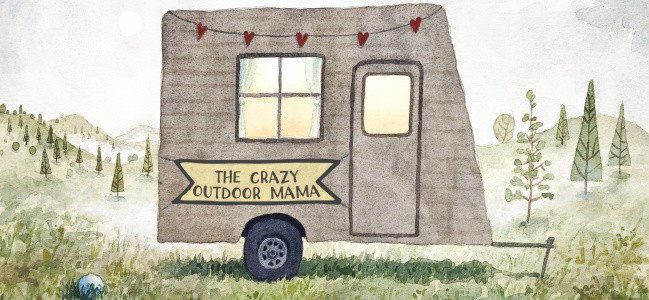

How to DIY RV BlackOut Window Covers for Your RV or Camper (NO SEWING Involved!)
Who else loves to nap during the day, but are blinded by the sunlight streaming through those cheap camper blinds, and swear you’ll buy the fancy black out blinds for your camper next time??
But if you’re like me, and super cheap, you probably never do! I have a TON of things in my “Save for Later” section of my Amazon cart, and I can tell you, nice blackout blinds are one of them!
This is especially true after our first camp trip of the year with all 3 kids in a new sleep set up – my son moved to the top bunk (no window!) but my twins are now in the bottom where there is both a window and blinds… and the blinds seem especially fun when they are going to sleep! I imagine it’s like some fun crunchy baby toy in their eyes for them!
Anyways, I wanted a quick and cheap way to do a couple of things – block out the light, help regulate the temperature a bit in our camper, as well as hopefully reduce the need to have those crunchy, cheap blinds that little kids love to wreck!
And I got it!
These cost around 5 dollars to make each, and you can bump up their quality with additional material (or even the actual black out material they sell at the store!)
Here we go!

How to Make Custom DIY RV or Camper Window Blackout Covers (For Cheap!)
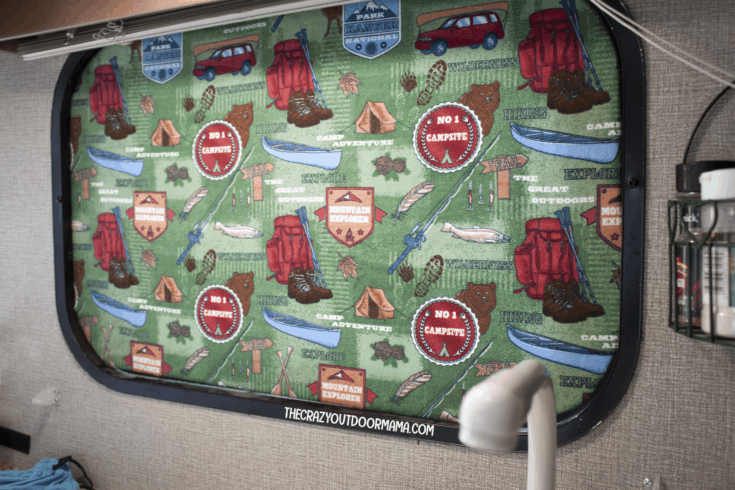
Make your own DIY RV window blackout covers for cheap with just a few materials! You can modify this to make it more "blackout" as needed!
- Tissue paper, contact paper, or some other thin, see through paper for tracing your window shape onto
- Foam Board (You can get it at the dollar store)
- Material enough to cover board (get enough for both sides if you want more black out and temp control power!)
- Marker to trace
- Hot glue gun
- Exacto knife
Instructions
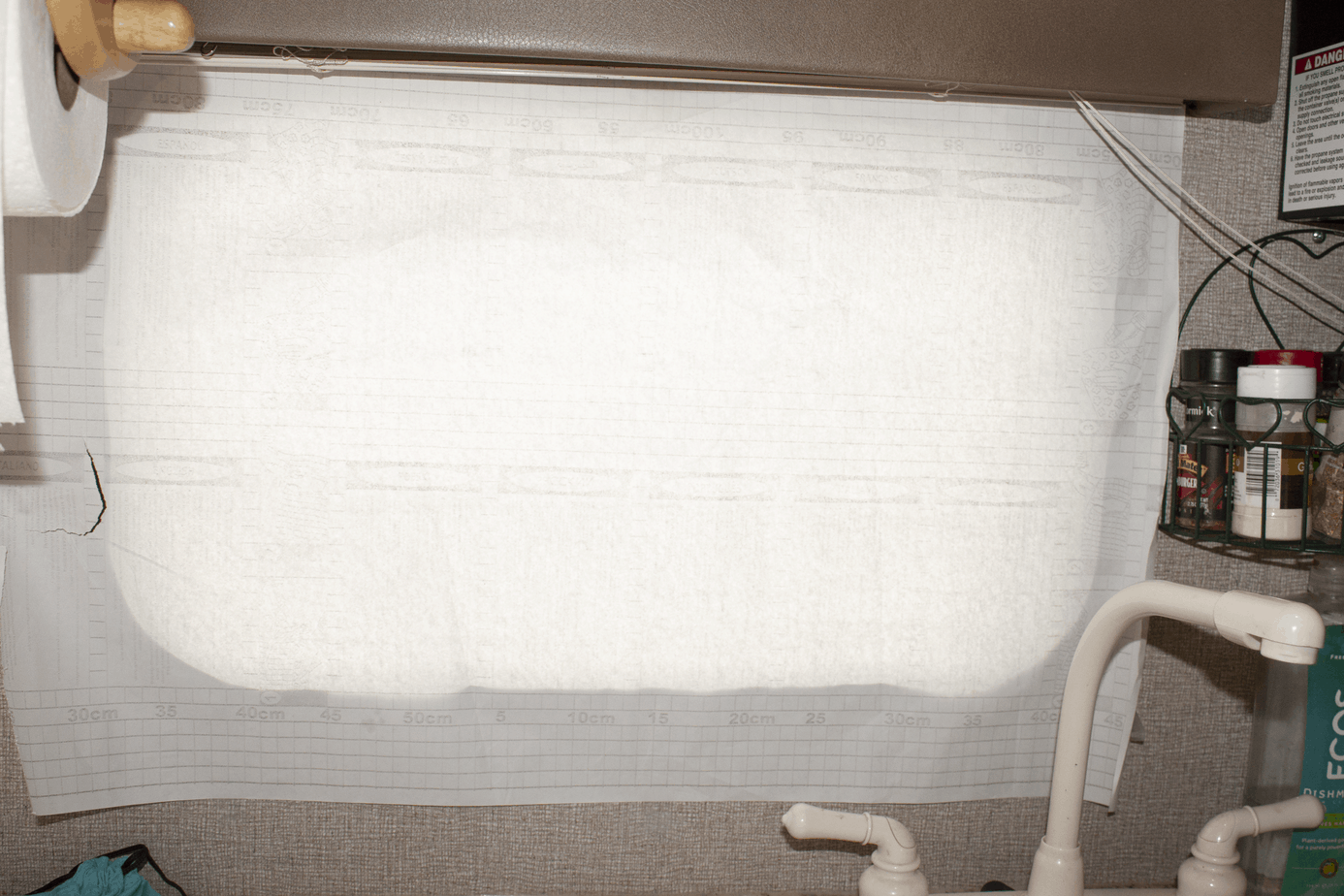
How did it go? Send me a picture!
These work perfect for the windows that don’t open, such as our kitchen window in our camper. I do have an issue with our kids bunk window, as the slide handle sticks out and makes it not lay flat (don’t worry, I have a solution!) I think more of a traditional curtain style might be best, but instead we would use velcro to secure it all in place.
Anyways, I’d love to see if you did it, or of any cool recommendations you have to make this even better! Now go on and enjoy that mid day nap so that I may live vicariously through you (with 3 kids 3 and under, it ain’t happening for awhile for me! =P )
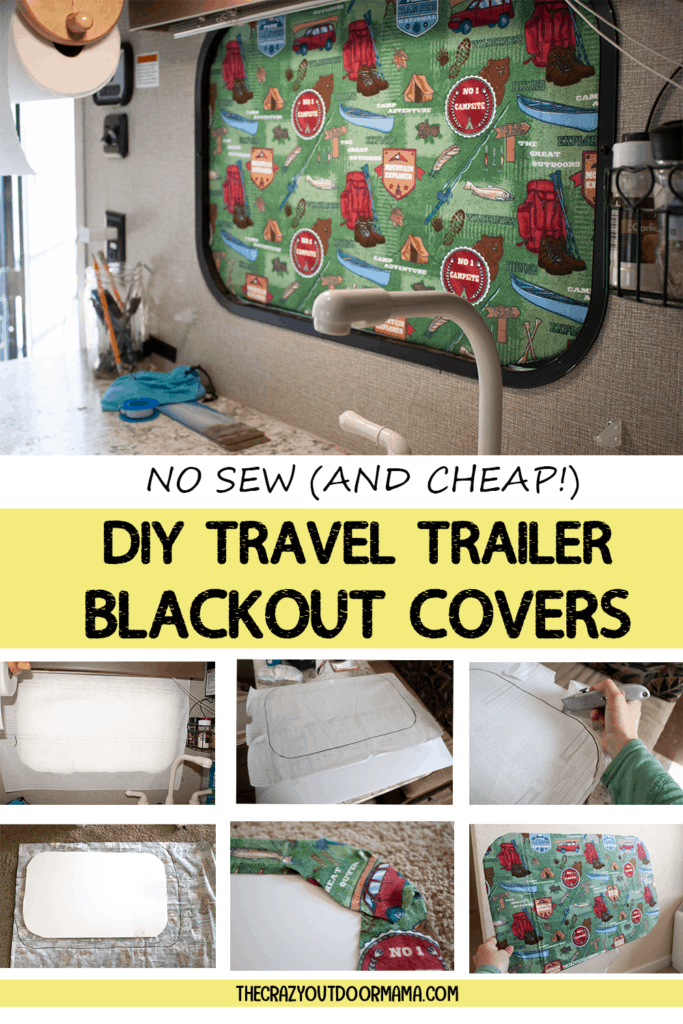
Do you like RV stuff? Then you will love these other travel trailer articles!
With 3 kids, myself and my husband all in our little 18 footer Keystone Hideout, we try to make everything count when it comes towards organization, purchases, and function! Here’s some cool stuff we’ve learned!
RV Tips and Tricks
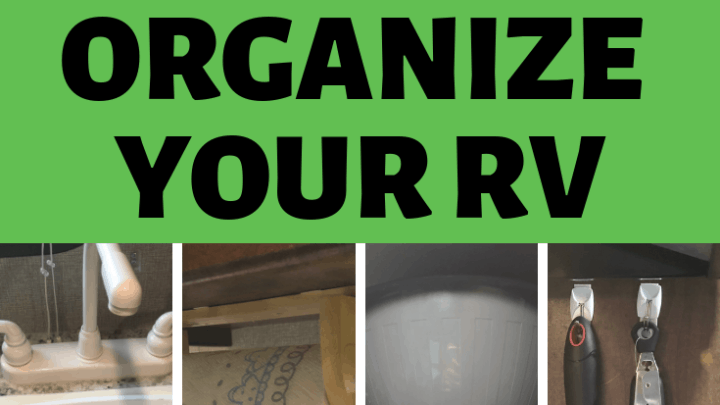
41+ Best RV Space Saving Organization Accessories and Hacks of 2019 + Video Walkthrough!
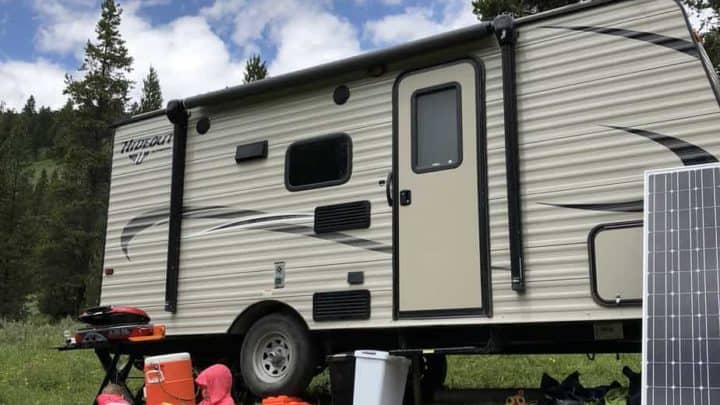
27 Must Haves for your Camper on a Budget!

RV Camping with Toddlers - How to get some sleep!
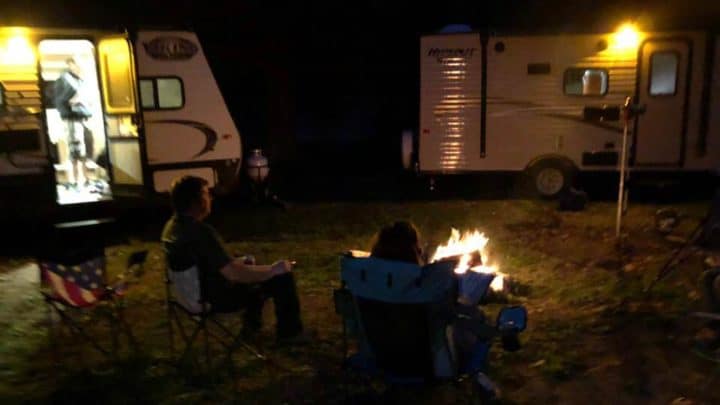
13+ RV Luxury Items You Don't Need... BUT WILL LOVE!
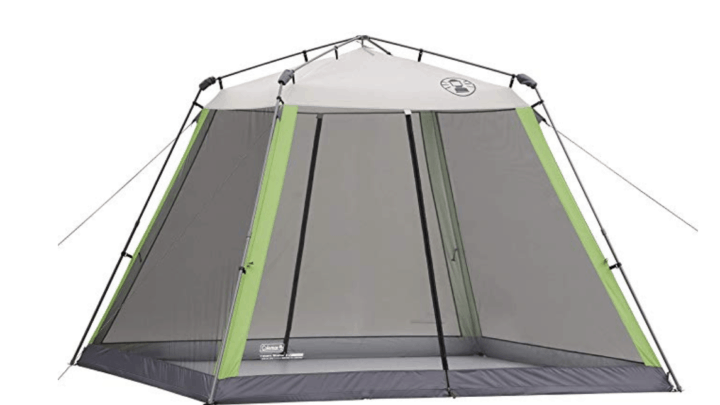
11 Most Helpful Outdoor RV Products That You Don't Need... But Will Make Your Camp Trip WAY Nicer!

7 BEST Tips for Sleeping in a RV with a Baby + DIY Baby Tent
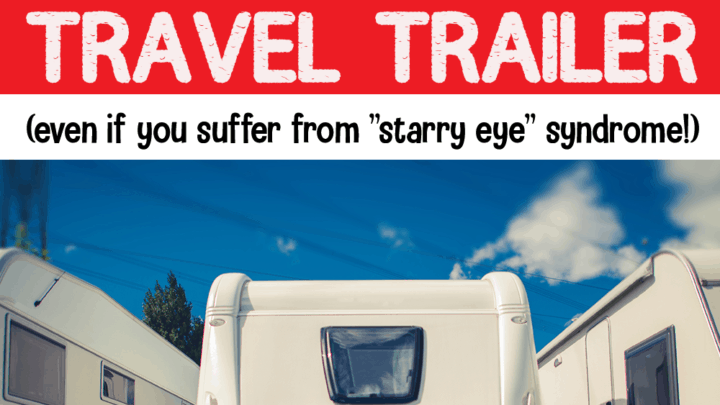
What to Expect... When You're Expecting to Buy a Travel Trailer! (+FREE PDF Workbook! )

Don't Do These 13 Annoying Things At Your Next Campground!
- Latest Posts
- Solar Eclipse 2024 Kids Printable Activity Pack! - April 8, 2024
- 11 RV Bathroom Makeovers to Inspire You! - April 7, 2024
- 13 Dreamy Hammock Camping Set Up Ideas + Pics - February 22, 2024
41 thoughts on “How to DIY RV BlackOut Window Covers for Your RV or Camper (NO SEWING Involved!)”
Hi, Thanks for this idea for the camper window! I might use it for blackouts someday, but I think you inspired me to do something else with the idea. I want to have removable screens for the little no see ems. Those teeny tiny little bugs that get through the regular screening! I think I will use your idea but modify the screen. I’ll use 2 pieces of foam board that are identically cut like a screen shape would be. So, I’d cut like you did, but then cut inside to make the screen frame. I’ll use fine sheer curtain material hot glued between the two pieces. Then I can pot it in and out whenever the no see ems are getting into the camper. Then when I’m not using them I can lay they flat under a mattress. I was trying to figure out how to do this and your idea is the answer! Thank you!
Hi Cathie! That sounds like an AMAZING idea! I might try that too, those little guys are so annoying! I’d love to see a picture of it when you’re done if you get the chance! Other people might be inspired by you! I’m so happy you found this useful – you’re welcome! -Stacy
I’ve personally used the silvery windshield sunblocks that can be inserted inside between the windshield and rear view mirror. They can be easily cut to fit, can fold up or lay flat for storage, and are reflective. Helped cool our bathroom down when I put one in the skylight above our shower!
Awesome! I’ve thought of cutting one up and then sewing it around a throw pillow (for more insulation) to stuff in that exact spot!
I like this idea. I just went car-camping in my Toyota RAV4 and had seen a YT video showing someone using black construction paper to cover their windows…complete with a little peek hole just in case someone comes knocking on your window. It worked well for short-term usage, but was not easily removed if I needed to drive. I think I will use your basic idea of using the foam core board, but I will paint it black and then put pieces of velcro on it to stick to the ceiling of my car when I’m not using it. 🙂
Car camping is the best! We used to do that with our son (until two more came along :P) Yes, the foam board might help insulate a little better and will definitely make it easier to reuse! Let me know how it goes! (P.S. that’s genius to use velcro on the ceiling – I would have never thought of that!) – Stacy
Out trailer is a rockwood which has the whole front of the bedroom is one large window. I purchased black foam board from Hobby Lobby so there was no need to do both sides ( my window has black tint on it). I used a navy blue sheet and made 3 covers across the window. It looks like I have a padded headboard now. I used command velcro to attach it and whola…no light comes through and they have never fallen down while traveling the country.
Teresa, Holy cow, that’s genius! I always wondered how I would modify this to work for a large window… and you did it! AND it sounds like it looks good too! I’m hoping to upgrade our camper next year to one that has either a large back or front window… I have to keep this in mind! Thanks so much for sharing! -Stacy
Did you make the camper awning? If so , I would love to see a blog on that.
Llda, No, I’m sorry! Though I should figure out how to do it, that would be very interesting!
I shopped the Dollar store for window shades in the automotive section. Trimmed to size…done and done
Ruth, Awesome!!! I’m happy that worked out for you! =) -Stacy
Instead of hot glowing the material if you can sew or knew someone that can sew them then hot glue the end piece that would make it go all the way around.
I would do this and add window car cover shields to the board and then put the sew the material on. Then you have double protection and no lights getting in.
Jesarae, I have to say, having a hybrid like that would likely work better than just what I wrote above. I need to do an update – we built second ones with an additional barrier and it did work better (but the hot glue didn’t feel as sturdy so I just sewed it) -Stacy
As someone who hates to sew, this is a great idea! My husband and I have been converting a Ford Transit Van to a camper, and since our interior is heavily metal, what I did was cut some blackout-curtains down to size , hem the edges when I had to (I tried real hard to use the existing hemmed sections), and stick magnet tape on the fabric to attach the curtains to the metal walls/windows trim. I bought 100′ of 1″ magnet tape (magnet on one side, adhesive on the other) for about $33 on the amazon, and have almost half left over, as I’m sure I’ll need repairs. But it works , it was easy, and they actually look okay!
My total cost was just for the magnet tape, as I got the curtains using my TJ Maxx MasterCard rewards points for the two sets, but didn’t like the curtains in the house and was too lazy to return them. A year later, my husband decides to build the camper, and lo and behold, the curtains were a perfect match! This is why I keep things, even when I should Marie Kondo them.
Also because I hate cleaning. But we’re going to go with “visionary” on this one, because it worked out so well. 😉
That is an awesome idea! I want to do something similar (but with velcro) on some windows that have the handle in the middle that prevents this design from working (it won’t lay flat). I did have to sew this other one I’m making, but I’m wondering if magnets might be better than velcro because they don’t get worn out as fast. I love this! And how lucky is that that they matched! I can’t count the amount of times I’ve saved stuff “just incase” I can use it for a project later… and I always justify my habits when stuff like that happens =P -Stacy
Great idea! I am so going to make these. Right now I’ve just hung up black fleece over the window shades, but it’s such a pain to put them off and on. Plus yours are prettier. Thank you so much!
Yes! I was just hanging my husband’s shirts over the blinds for a while there =P I bet they’ll turn out great! Your welcome! -Stacy
I love this and I think I will try to add thermal bubble insulation to mine. We love our trailer in the winter but have had to use the foil insulation to the windows and it looks terrible! Has anyone done this?
Hello! I just did an article on winter rv camping and it might help you out! What you could do is get this product called “3M Window insulator kit” as a first layer of insulation (it’s clear so it won’t look bad!) then see if you can do a beefed up form of this black out cover so that it still looks attractive. You might be able to fit some additional insulation in it (I was thinking something easy like buying a car sunshade and cutting it to fit). It might be better though at the point to sew it if you could, not sure if hot glue would hold it all together. Let me know what you end up doing! – Stacy
I did a similar fix for our new trailer back in 2013, although not as elaborate or pretty as yours. What would you expect from a guy? I used black foam board from the dollar store also. Instead of making templates I cut the foam boards for length and height and then used a tin can that matched the radius of the corners to mark the panels for trimming. I used sharp scissors, not blades to trim them. They are super clean panels. I didn’t add add any covering, mostly because that’s not where my talents trend. I also found that old sol can be as hard on these panels as my interior fabrics, but the panels are easy to duplicate. They stay in the windows when our trailer is resting. After some time I made one modification. Go to Home Depo and buy a roll of flextime insulation. You’ve probably seen the same material used as auto windshield shades in parked cars. Cut it to fit and glue it to the side facing out on each of you panels..Makes them even darker and helps keep the inside a bit cooler. Thanks for letting me ramble. Milt
Hi Milt! LOL if my husband had it his way we would have just duct taped an old towel around it, so I get it =P. And I love the tin can idea – even tracing it, it was difficult to get those nice clean perfect curves on the edges (why the heck can’t they just do a straight edge??) Thanks for the insulation idea tip! We actually bought some cheapo car shades and cut them up for our kids lower bunk window because we needed some extra insulation at night (and I didn’t feel like beefing up what I already made.) I should have really just use that originally! And don’t worry, you can ramble any day, I love hearing thoughts and ideas! =D I hope you’re doing well! – Stacy
I don’t know how this compares to other ideas posted for insulation, but thought I’d throw it out there. We have a partially finished basement that gets really cold in the winter. A few years ago I replaced the cushions on our dining chairs and re-covered with the same fabric, so I had squares of old, worn out foam (about 3″thick). I was ready to throw them out and my husband suggested we keep them. A few weeks later I went to his office in the basement and he had cut them to fit inside the window well. The office was MUCH warmer AND when we watch movies in the family room on Sunday afternoon it is pitch black! Easy to take out when he wants light, too.
Hi Sarah! Ohhhhh that’s a good idea! I bet I could use that for the skylight area (the right size pillow to stuff in there is hard to find). I love that idea! I bet that’d be really helpful for when you need more warmth, like maybe when camping in the RV during winter. LOL it feels so good to be validated when some random scrap you “save just in case you needed it later” actually gets used! =P Hope you’re doing well! – Sarah
Love this idea so much!! DO you think it is possible to keep the current setup (as you did yours) and add the thermal insulation/reflective material to the back where the rough edges are? The kind I have is see through and having this as a backer will make the RV cooler and more attractive!! Thank you for the great share!!
Hi Laura! YES! We’ve since redone the covers and changed the order that we add things. That would probably work fine! (I need to update this post with some pics of how we did the updated black out shades for our camper!) – Stacy
Hey thanks for posting this useful tip here about blackout window covers
Your welcome, hope it helps to black out your RV and keep it cool! – Stacy
This for posting this! My impromptu fix last time we went out were tension rods and a pillow case. It worked, but I may make a few of these for places where a tension rod won’t work.
Hi Rachel! Your welcome! I do like the tension rod idea, especially for windows that open that have the big open/close mechanism in the middle that sticks out so far that it’s hard to put one of the cover I use in them. I hope you find these help you! – Stacy
Thank you very much for how to DIY blackout window covers, it’s difficult for me to get such kind of information most of the time always… I really hope I can work on your tips and it works for me too, I am happy to come across your article. Well, I have visited another site https://foreverblinds.com.au/ having some wonderful and similar information.
Hi! Your welcome! It’s a good alternative if you can’t get something installed. I normally remove website mentions, but actually those custom blinds look super helpful (and pretty!) LOL one day I might up my game and actually get something like that installed in our camper! – Stacy
OMGosh!!!…I cant wait to make these…starting in the RV bedroom windows…thanks
Oh, I forgot to ask…what do you think of using bubble wrap between the window and core board?…it has insulating properties…and we get tons free in our shipments…
HI, when my 1 year old grandson came camping with us – I quickly realized that I REALLY needed something to cover the RV sunroof for his naps. So I used a form board cut to size (1/4 each shorter on each side), used a dark pillowcase and fit it to size and closed it with small velcro piecea so easy to take foam out and wash cover if needed. Instead of sticking velcro strips along the length and width of this foam board (pain to remove glue on window frame after) – I used the Medium size COMMAND hooks. I affix three hooks in window well, slide in my foam piece (inside fitted pillow case), put in position and then affix the last hook to have board sit on it. So easy at end of season to remove all COMMAND hooks before winter starts and easy to reput together in the spring. Happy camping!
Holy cow Franny, that’s an AMAZING solution! I might add your tip to my camping with toddler/babies posts because this is awesome! Thank you so much for taking time to type that out – I’m sure it will help many (because I’ve had people ask for an easy way to block out the sunroof windows – Stacy
I liked this idea, very simple! I cut out a cardboard box to so size and put a pretty pillow case over it! It fits perfect. I can remove the pillow case and wash when needed. Thank you for the idea.
Great to hear Kathy, thank you! That is an AWESOME idea (way easier and easier to clean!) I think we might actually make ours like that next time! Thank YOU! – Stacy
I used your blog to make window covers for my travel trailer. I out a pretty fabric on the inside and reflectix on the outside. thanks for the post! Two windows down three to go.
Hi Dena! That’s awesome to hear! Your welcome, and I hope the other three turn out just as good as the first two! – Stacy
Leave a Comment Cancel reply
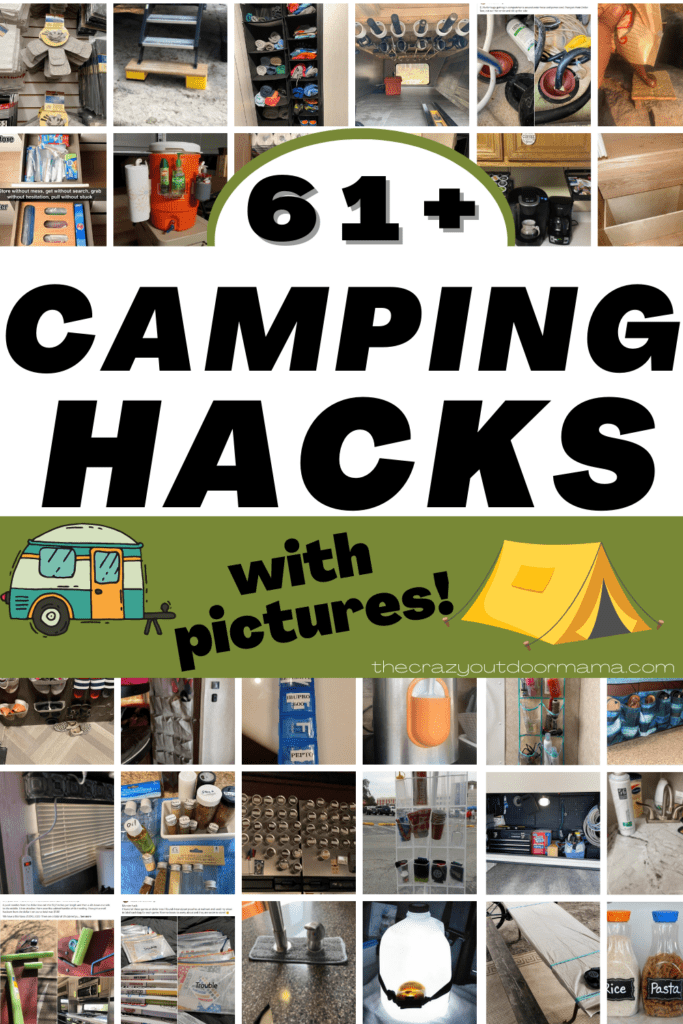
HI! I'm Stacy, AKA “The Crazy Outdoor Mama”
I'm the voice behind the website, and I hope you've found what you needed! I'm an outdoorsy married mother of three from Wyoming, and I LOVE creating resources that make camping and other outdoor activities easier!
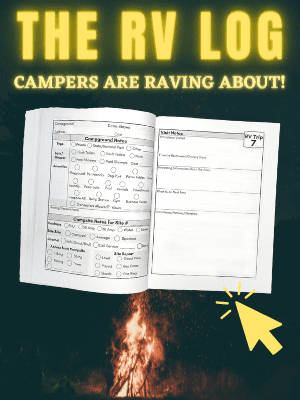

Need help or advice?
Blackout EZ RV
Introducing the all new Blackout EZ TM RV Window Cover! Designed exclusively for RV windows with radius corners, the Blackout EZ TM RV Window Cover will -
- Give you total privacy
- Keep you cooler in the summer by reflecting the sun
- Keep you warmer in the winter by insulating your windows
- Keep your interior from fading during storage
Note - custom covers ship complete with Velcro tape. Due to the custom size, we unfortunately do not offer any returns or guarantees on the custom made products.
Ships in 3-5 business days.
Tim, Here are two pics that show how well your product has worked for me. I use your Blackout EZ custom shades on my camper when I'm out doing astrophotography.
One pic show how my telescope, cameras and other gear are set up in daylight on the astronomy field at Cherry Springs State Park in the Susquehannock State Forest in Pennsylvania. Usually, I operate the telescope and camera remotely from inside my camper at night.
The second pic is one my buddy took this past June of a STEVE aurora over my camper just before I shut the door. I had lights, computers and movies running inside at the time he snapped the photo. You can also see how the BlackoutEZ shades have all the light perfectly sealed inside. No light leak complaints from my fellow astronomers! Thanks again! Leon Branford, CT

"I purchased Blackout EZ TM window coverings in the Summer of 2013 for my travel trailer. I discovered that without window coverings at night, my trailer was comparable to a fish tank. My neighbors could see in through every window if I had lights on at night. To remedy my lack of privacy, I bought nine Blackout EZ window covers and installed them easily in one afternoon. They are wonderful! I had immediate privacy! Another benefit is an additional insulating factor in the windows. The covers block out the hot sun and also the cold air in the Winters here in Reno, Nevada. They are easily removed to clean and install devices like air conditioners for seasonal use. I highly recommend this product!"
- Bradley Nottingham
People kept calling and emailing looking for blackout covers for their RV. So we started making a few by request. Then the few request became many so we added Blackout EZ TM RV Window Covers to the website. The excitement continued to grow so I decided to purchase a RV to see what the fuss was all about and to speak intelligently when asked questions about the product.
Leaving the dealer with the trailer in tow, after my hour long training session, I don't think I took one breath on the forty five minute drive home as the trailer swayed back and forth. I was so overwhelmed with the whole idea of the weight distribution hitch, trailer set-up, the holding tanks and not to mention the sewer dumping, the trailer sat in place for ten months before I mustered up enough courage to take my first trip.

Check out my youtube channel

Blackout EZ RV Window Cover

Blackout EZ RV Window Cover Graphic Prints

Reflectix® Insert

Draftout EZ RV Window Cover

RV Vent Cover
RV Skylight Cover
RV Entry Door window cover

RV Entry Door Window Cover American Flag

RV Entry Door Window Cover USA Map

RV Entry Door Window Cover American Flag 2

RV Entry Door Window Cover American Flag 3

RV Entry Door Window Cover American Flag 4
Reviews [more].
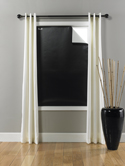
Become an Affiliate
Earn 10% per sale and get $10 just for signing up! Click the button below to find out more.
Information
Company information.
- Blackout EZ Window Covers
- Custom Sizes
- Who Needs It
- Video Testimonials
- The Gallery
- Blackout EZ PDF Sheet
- Become an Affiliate!
Customer Service
- Shipping & Returns
- Privacy Notice
- Conditions of Use
Follow Us for Great Offers!
Secure shopping guaranteed.

blackout EZ Order Wizard
Based on the dimensions given, the following options are available, standard sizes, fabric/hook & loop tape.
- Ebook/Downloads
- Madison, AL
- Huntsville, AL
- Merrimack, NH
- Kingston, NH
- Raynham, MA
- Louisville, KY
- Pittsburgh, PA
- Philadelphia, PA
- Fredericksburg, VA
- Mocksville, NC
- Kings Mountain, NC
- Raleigh, NC
- Myrtle Beach, SC
- Acworth, GA
- Jacksonville, FL
- Leesburg, FL
- Jacksonville North, Fl
- Richmond Hill, GA
- St. Augustine, FL
- Preowned RVs
- Blowout RVs
- Shop Online Parts
DIY RV Bathroom Skylight Blockers
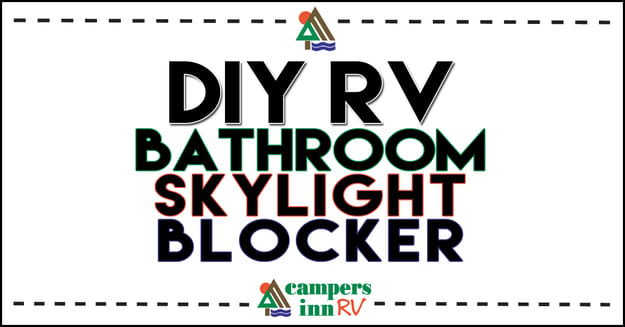
This creative solution will prevent unwanted light from shining through your RV’s bathroom skylight.
One of our followers and proud RV owner, Sharon from Pennsylvania shared her stylistic solution for blocking unwanted light from an RV’s bathroom skylight.
First of all, why would you want to block your RV’s bathroom skylight?
You may find that the light shining through your RV’s bathroom skylight can cause a significant increase or decrease in temperature in your bathroom depending on the climate of your camping location. During a hot summer day, the light shining through your skylight can transform your bathroom into a stuffy sauna. On a cool fall day, your skylight can leak in cool air transforming your bathroom into a freezer. In addition, your RV’s bathroom skylight may leak unwanted light into your bedroom in the morning when you’re trying to sleep. This is where Sharon’s DIY skylight blockers save the day!
Sharon blocks her RV’s bathroom skylight with her timeless quilt squares she hand sewed in the comfort of her own home. Sharon said she also uses her quilt squares to block her RV's vents from leaking warm or cool air into her RV.
“The quilt pattern is an eight pointed star,” said Sharon. “It’s a pattern I love to use a lot on all my quilts. My quilt squares keep out unwanted light, heat during the summer and cool air during the fall.”
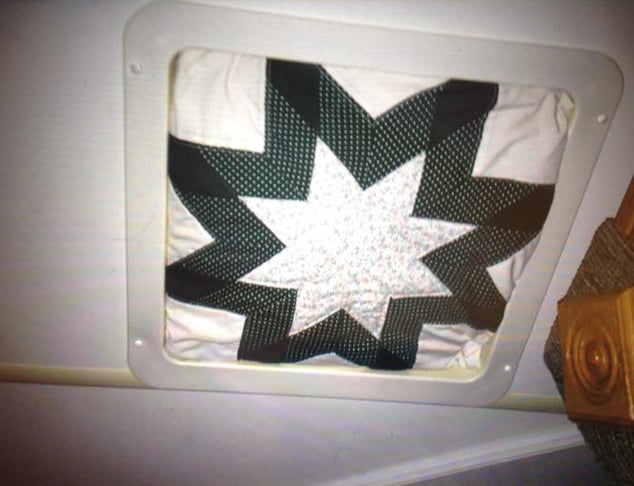
Thank you Sharon for sharing your RV bathroom skylight and vent blockers with us! We encourage every one to share their DIY RV projects with us. Find us on Facebook and Twitter to share your DIY RV projects!
Would you like some tips and tricks on maintaining your RV? Check out our Top 10 Tips to Successfully Maintain Your RV blog post. Protect your investment!
Tags: RV Lifestyle
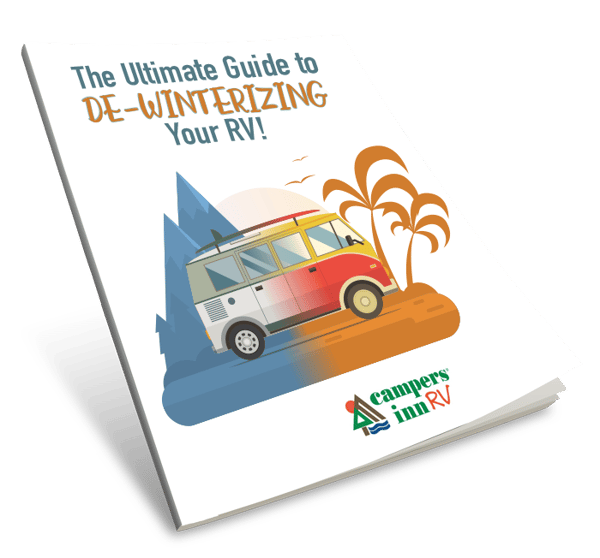
Subscribe To The Blog
Recent posts, posts by tag.
- RV Lifestyle (182)
- RV Shopping (150)
- Travel (65)
- RV Maintenance (50)
- Company News (43)
- Motorhomes (35)
- Travel Trailer (30)
- All Things RV Podcast (19)
- Fifth Wheels (18)
- Class B (16)
- Class C (11)
- Toy Hauler (10)
- Class A (8)
- Bunkhouse (4)
- Pop-ups (4)
- Boondocking (2)
- Super C (2)
- Haunted Campground (1)
the campers choice
Home About Us our mission Customer care Testimonials Canadian Buyers Corporate News Employment
Louisville, Ky Kingston, NH Merrimack, NH Raynham, MA Union, CT Philadelphia, PA Bismarck, ND Minot, ND Fredericksburg, VA Mocksville, NC Kings Mountain, NC Raleigh, NC Myrtle Beach, SC Charleston, SC Conway, SC Pittsburgh, PA Huntsville-Madison, AL Acworth, GA Atlanta, GA Macon, GA Richmond Hill, GA Jacksonville, FL JACKSONVILLE SOUTH, FL Leesburg, FL Ocala, FL
new rvs Pre-Owned RVS Blow-Out RVs Parts Service TOW Guides
financing & insurance
Financing Extended Service Plans tire & road hazard Gap Protection ECORVPRO
Blog E-books Video Library Events
Copyright © 2018 Campers Inn • Sold RVs • Privacy Policy Powered by: Interact RV - Website Marketing, Design and Development

- Skip to primary navigation
- Skip to main content
- Skip to primary sidebar
- Skip to footer
Journey With Confidence
10 Best Lightweight Travel Trailers For 2023

- RV Trailers and Motorhomes
![travel trailer light blocker The Rove Lite small travel trailer. (Image: travelliterv.com)[/caption]](https://rvlife.com/wp-content/uploads/2022/11/Rove-Lite-Scene-3.49.15-PM.jpg)
Consider the GVWR (not the UVW)
Many RV manufacturers tout the UVW (unloaded vehicle weight) of their trailers. But adding cargo like fresh water, propane tank(s), food, clothing, bicycles, and other camping equipment to the trailer can add hundreds of pounds to that UVW number.
GVWR is the weight to know when buying a trailer for a lightweight truck or passenger car tow vehicle.
Knowing the GVWR of small campers is the key to safe towing on road or while off-the-grid camping. Now, let’s dive into our list of the best lightweight travel trailers for 2023.
The 10 Best Lightweight Travel Trailers (Under 6,000 Pounds GVWR)
Our top small travel trailers for 2023 are listed in order by cost in US dollars, from least expensive to most expensive.
1. Vintage Trailer Works XTR: An Off-Road Lightweight, Customizable Camper
The Vintage Trailer Works team builds custom teardrops, retro campers, and toy haulers in Dothan, Alabama. The 5’x8′ model XTR is one of VTW’s four off-road, customizable lightweight teardrop trailers.
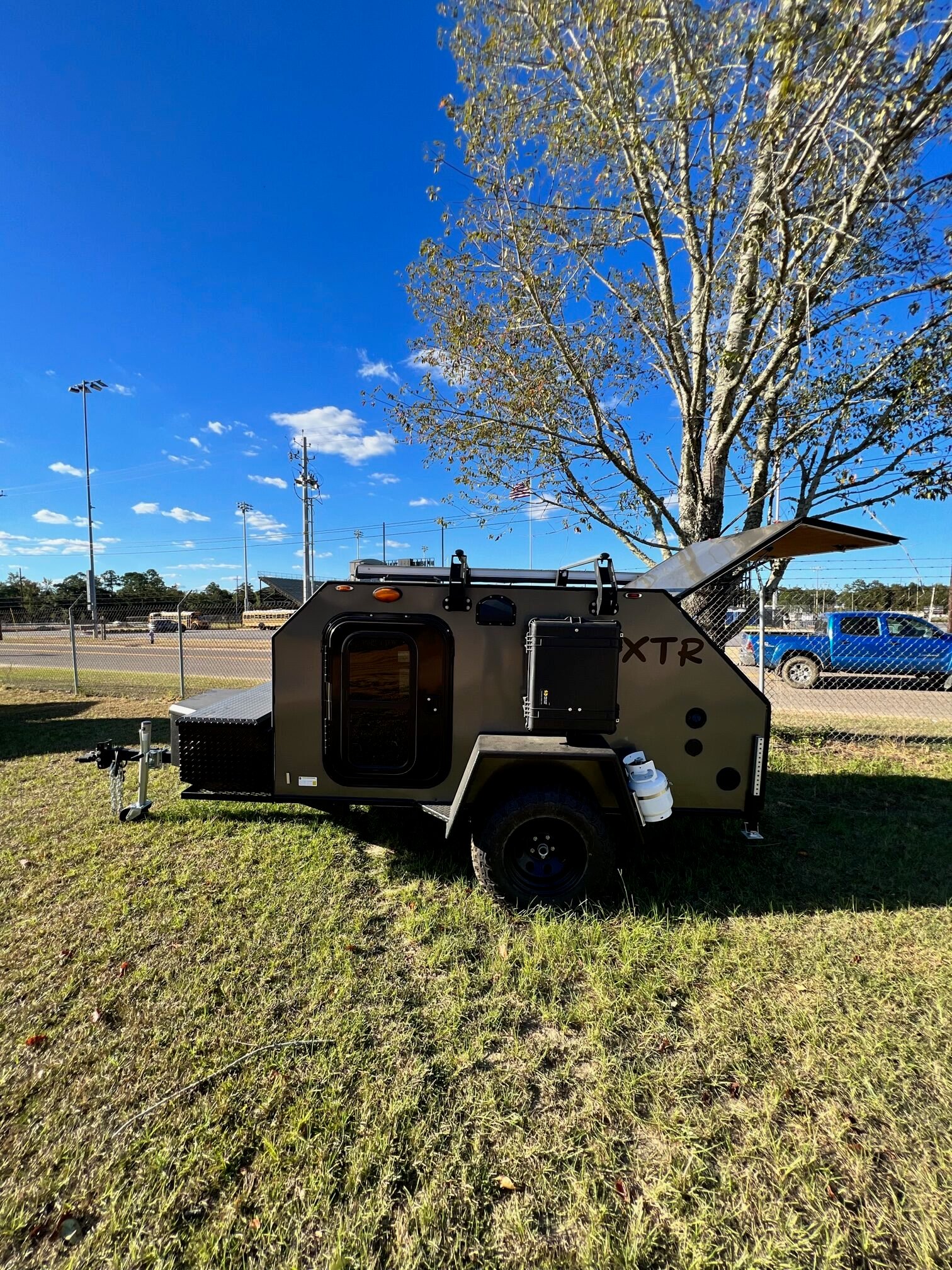
This mini travel trailer features dual doors with sliding windows, a tri-fold queen bed mattress and couch, 30″ A/T tires, and a beautifully designed galley under the rear hatch that’s ready for the best camping coolers and grills and outdoor cooktops of your choice.
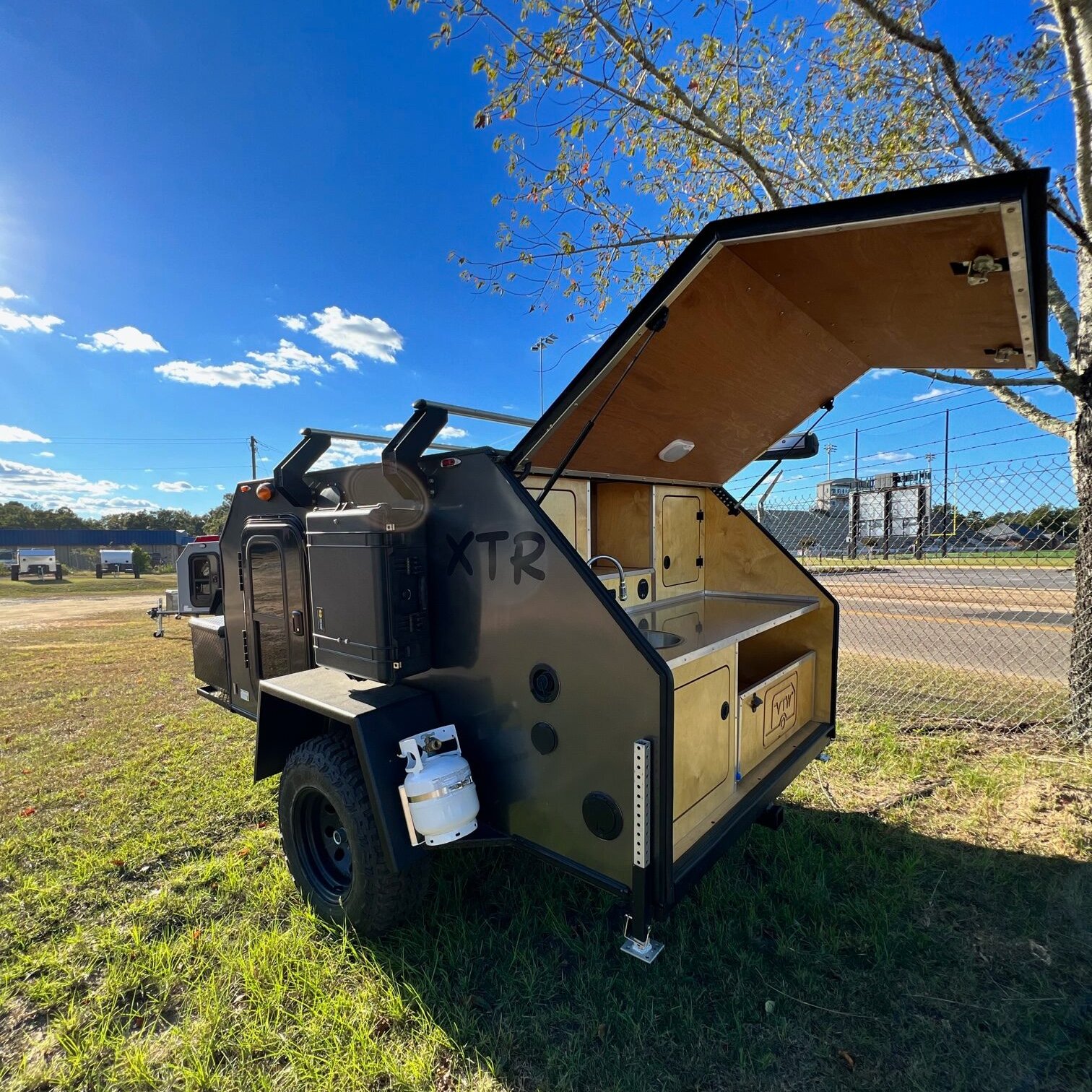
All XTRs are custom built per buyer’s choices, starting with 4’x8′ to 5’x10′ floorplans, tailored kitchen layouts, an optional roof rack, awnings, cargo storage system choices, electronics, and more.
Vintage Trailer Works XTR Features
- Hitch weight: 275 lbs.
- Gross vehicle weight rating: 2,990 lbs.
- Unloaded vehicle weight: 1,600 lbs.
- Exterior length: 14′
- Full exterior height: 5′ 8″
- Exterior width: 7′ 5″
- Freshwater capacity: 10 gallons
- Optional roof rack and awning
- Base MSRP: $11,695
2. Riverside RV Retro 135: Vintage Style Small Trailer with Full Bath
There aren’t many small travel trailers with a full bath on the market today. But one trailer stands out from the rest: the Retro 135 from Riverside RV.
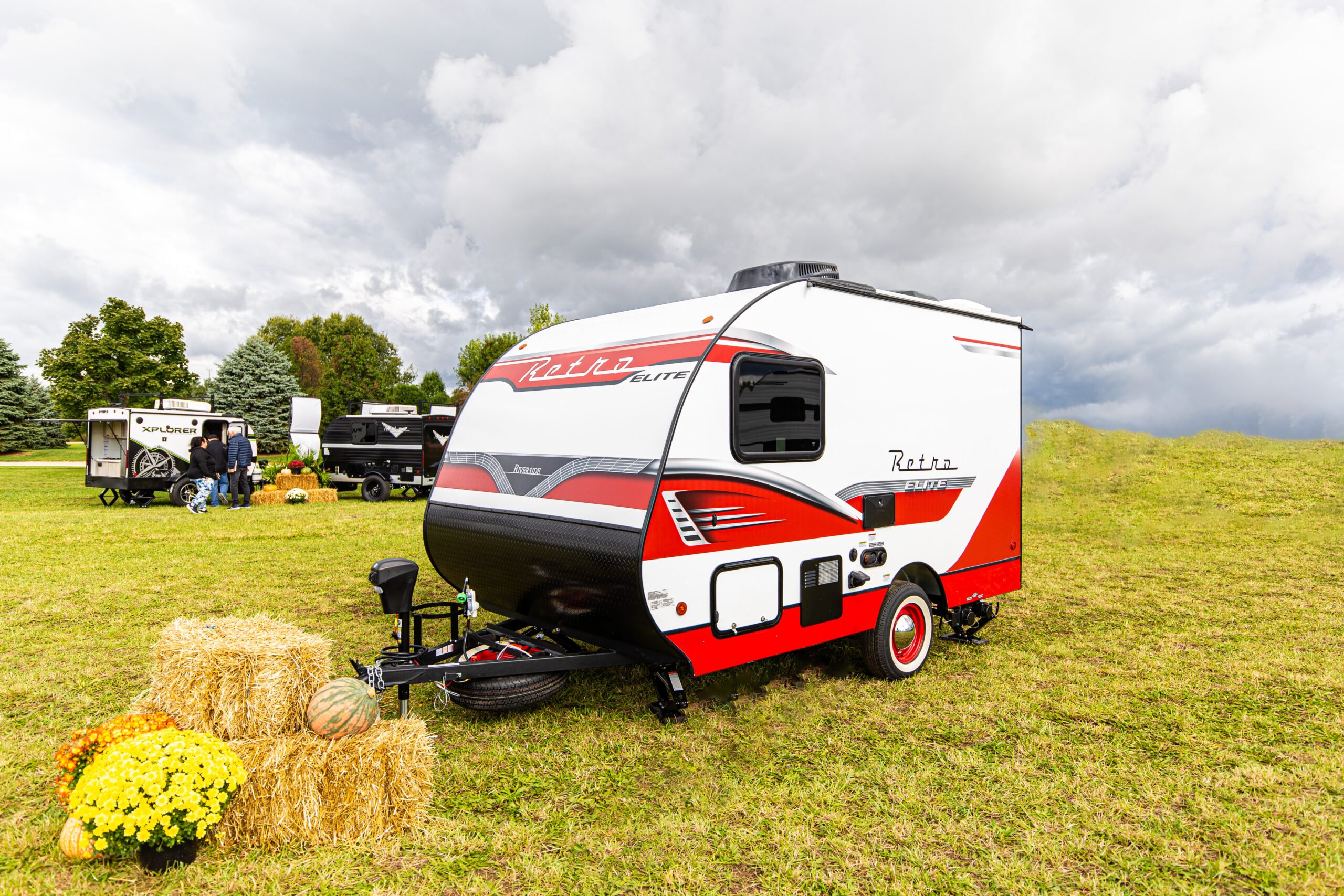
The retro vibe starts on the outside with a colorful fiberglass exterior and continues inside with an eye-catching 1950s-style vintage trailer interior.
It features a black-and-white checkerboard flooring; dinette cushions in aqua, red, or seafoam green; and bright birch wood interior walls and cabinetry.
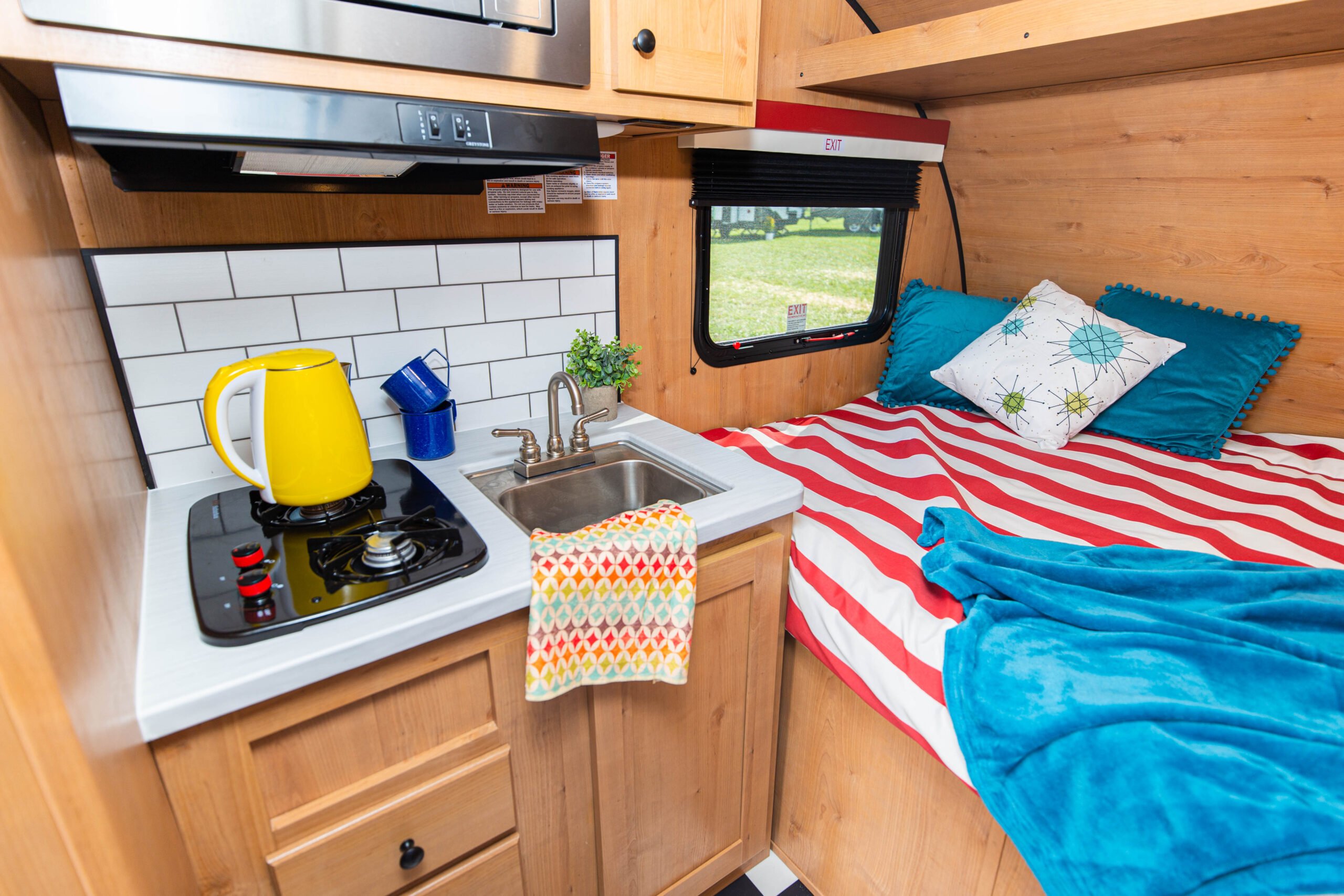
The ceiling is 6′ 3″ with an airy feel, despite being one of the smallest camper trailers on our list. The Retro has plenty of room for a 20K Btu furnace and 13.5K Btu A/C, a full wet bath, and a kitchenette with a refrigerator and cooktop.
Riverside RV Retro 135 Features
- Hitch weight: 140 lbs.
- Gross vehicle weight rating: 3,730 lbs.
- Unloaded vehicle weight: 2,640 lbs.
- Exterior length: 15′ 9″
- Full exterior height: 9′ 6″
- Exterior width: 7′ 6″
- Interior height: 6′ 5″
- Freshwater capacity: 36 gallons
- Gray water capacity: 32 gallons
- Black water capacity: 17 gallons
- Optional dinette
- Base MSRP: $24,317
3. 2023 Travel Lite Rove Lite 16RB: A Versatile and Lightweight Trailer
You will love the new Rove Lite 16RB ultralight travel trailer from Travel Lite . This is the largest in the company’s offerings. Yet, it’s one of the most affordable small travel trailers on the market and light enough to pull behind many small cars and tow vehicles.
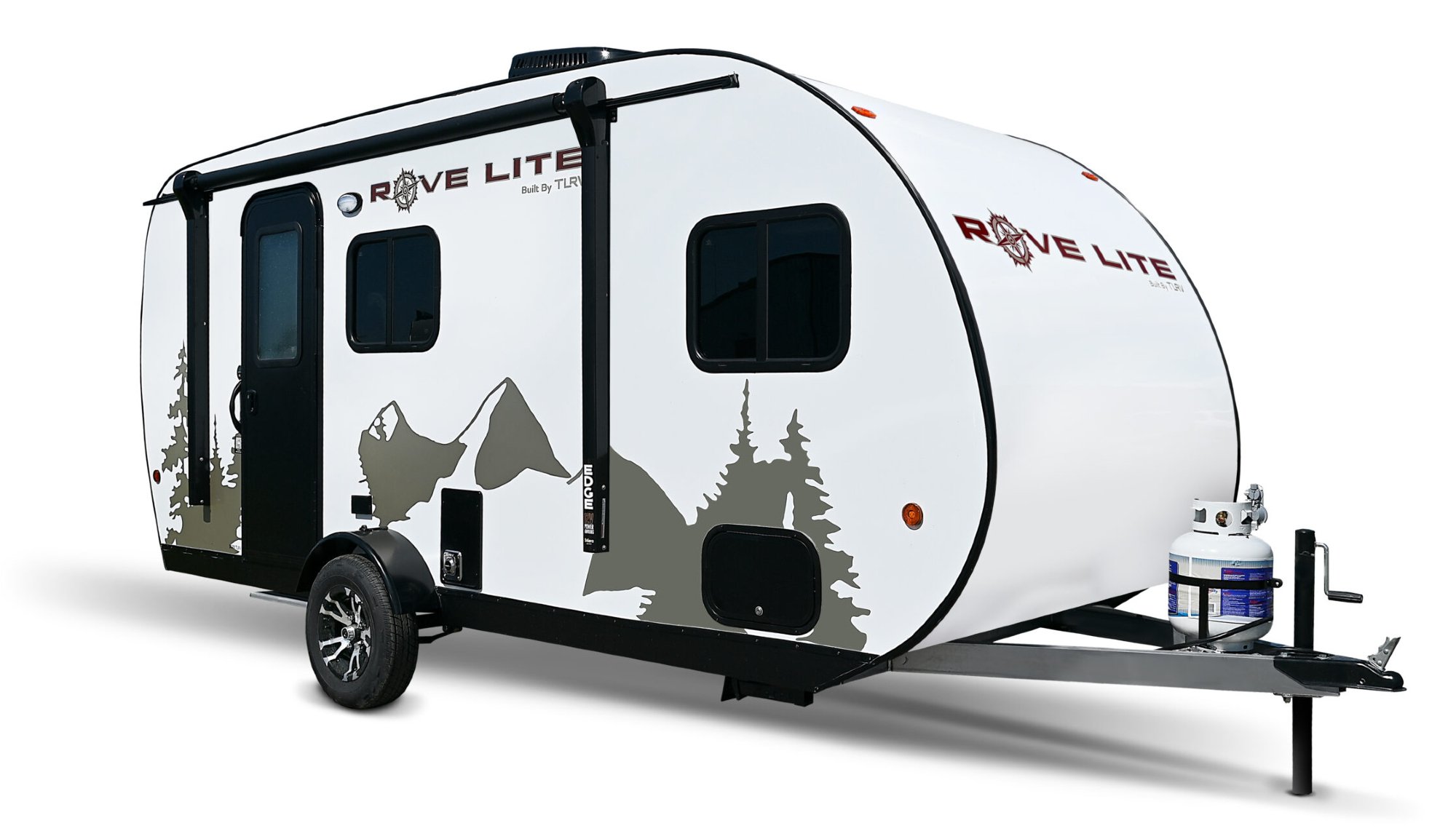
The sleek Euro-style design, use of state-of-the-art composite materials, aluminum chassis, and seamless poured resin fiberglass roof are industry-leading materials.
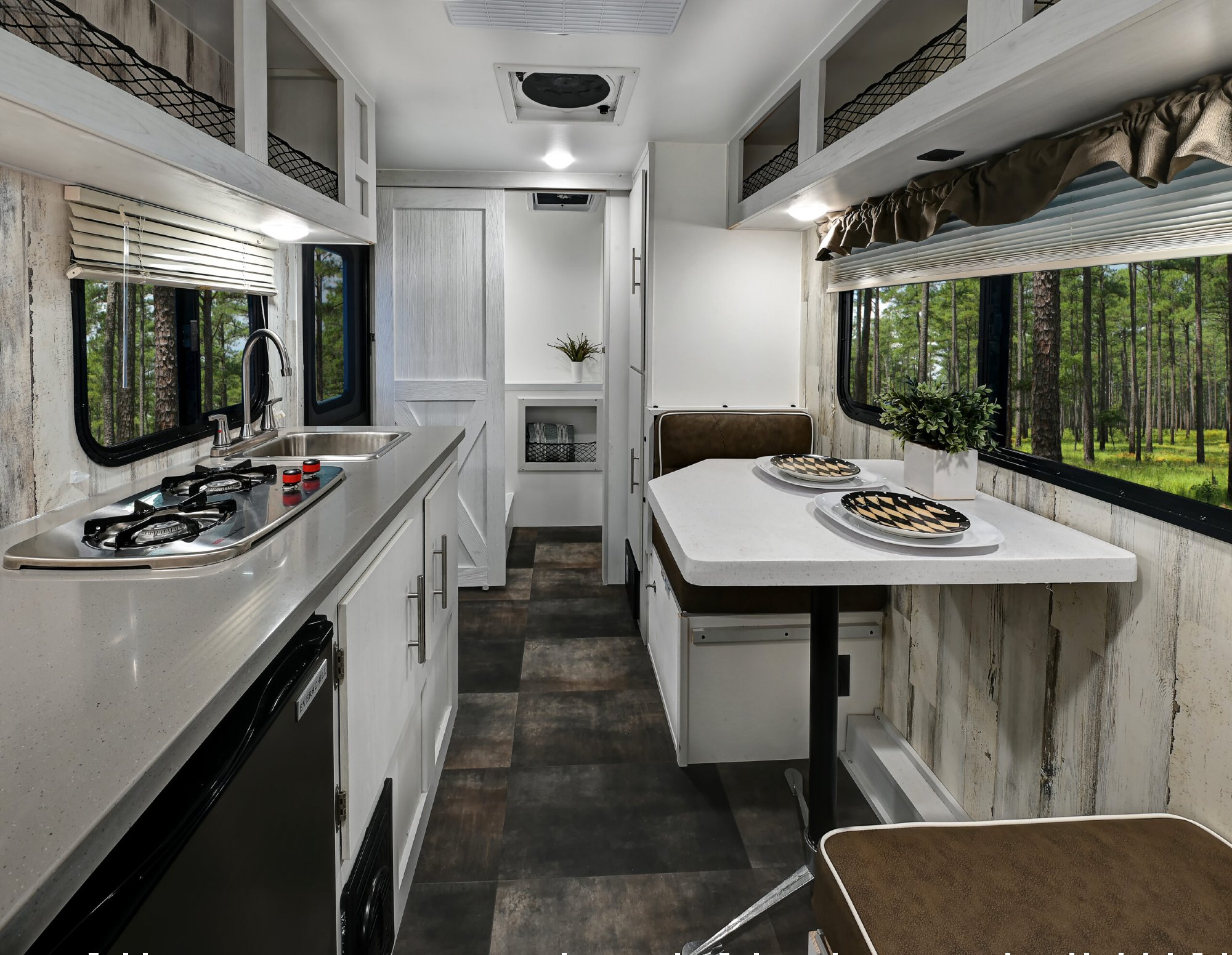
Interior features include a convertible bed and one of the only lightweight travel trailers with a full bathroom (and an outdoor shower, too). RVers love the unexpected space-saving functionality of this ultra-light travel trailer.
2023 Travel Lite Rove Lite 16RB Features
- Hitch weight: 154 lbs.
- Gross vehicle weight rating: 3,500 lbs.
- Unloaded vehicle weight: 2,044 lbs.
- Exterior length: 18′ 9″
- Full exterior height: 8′ 11″
- Exterior width: 7′ 11″
- Gray water capacity: 30 gallons
- Black water capacity: 5 gallons
- Optional exterior shower and electric side awning
- Base MSRP: $30,236
4. 2023 Keystone Passport Solo 15FK: An Elegant Small Trailer with a Full Kitchen
Keystone RV’s new Passport Solo 15FK is the smallest of the five Solo Series (single-axle) lightweight travel trailers. It’s in prototype phase now but will be out in 2023.
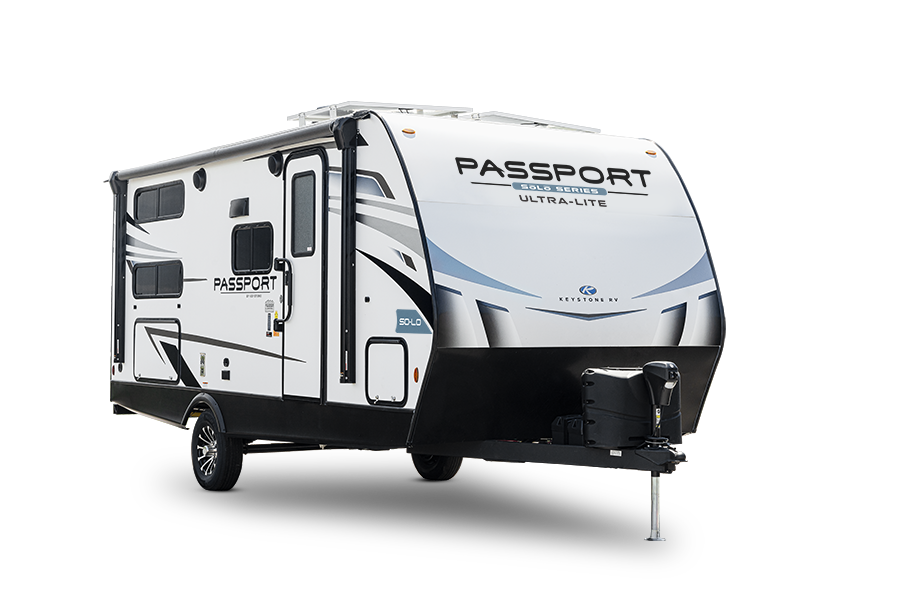
This ultralight travel trailer is loaded with standard features usually not found on single-axle campers, including an outdoor kitchen, tongue jack, stabilizer jacks, and a 10-foot awning.
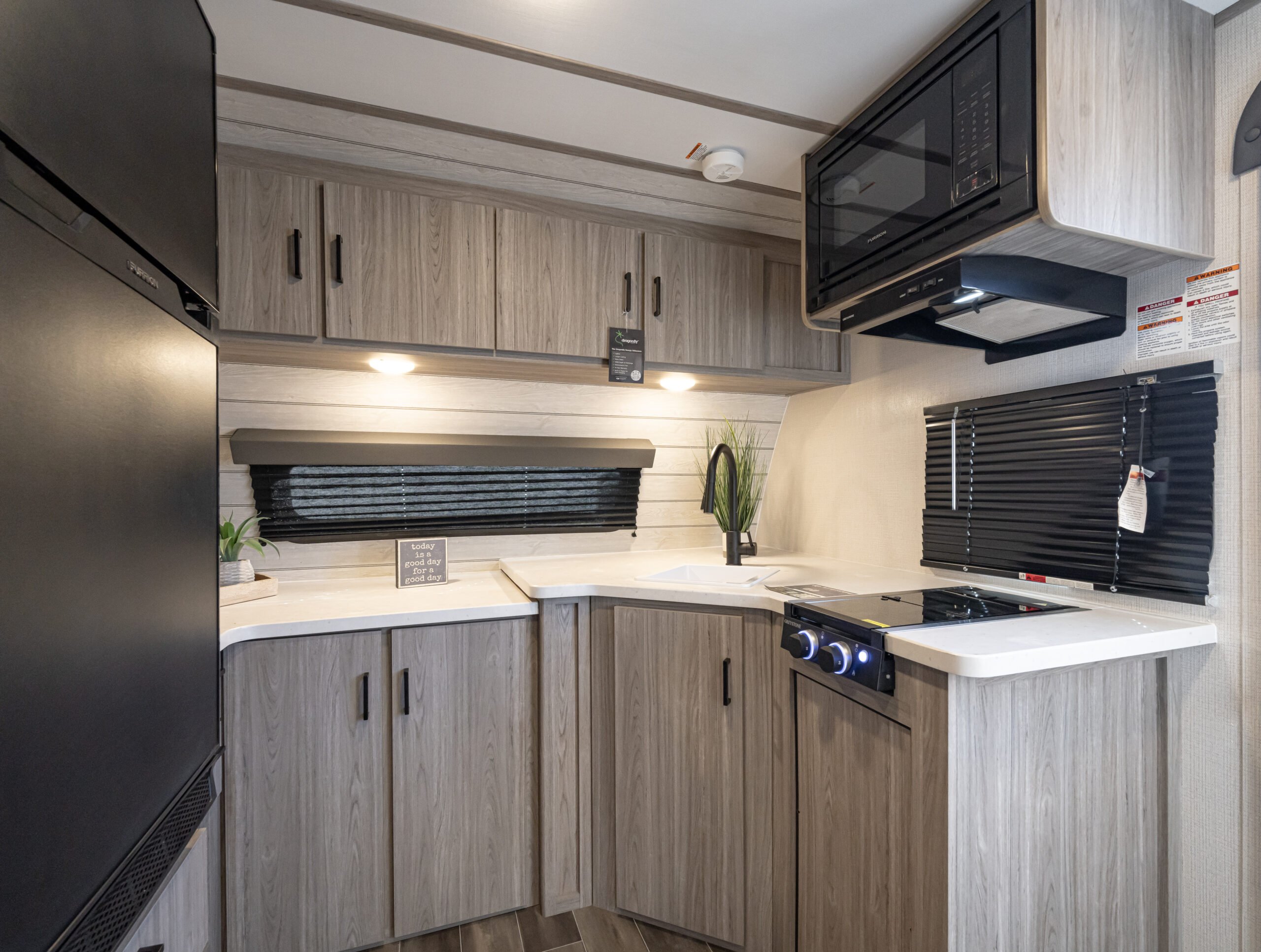
This compact travel trailer features Keystone’s exclusive HyperDec flooring (composite and water-resistant), a rear wet bath, a 60″x80″ tri-fold queen-size bed, plus a beautiful wrap-around kitchen in the front with a large pantry, an 8 cu. ft. 12V fridge, plus a microwave and two-burner LP stove. There’s also an outside kitchen with a pullout griddle to accommodate hungry family members.
2023 Keystone Passport Solo 15FK Features
- Hitch weight: 595 lbs.
- Gross vehicle weight rating: 5,650 lbs.
- Unloaded vehicle weight: 4,410 lbs.
- Exterior length: 19′ 5″
- Full exterior height: 10′ 4″
- Exterior width: 8′
- Freshwater capacity: 37 gallons
- Black water capacity: 30 gallons
- Optional solar panel packages and lithium batteries
- Base MSRP: $34,350
5. L’Air Camper Company Trillium Lion 1300 GT: Classic Styling in a Lightweight Pull-Behind Trailer
Want to tow a small trailer with a small SUV or crossover? This is it!
L’Air Camper’s new Trillium Lion 1300 GT is a great small camper for couples and solo RVers who love the look of classic ’50s styling.
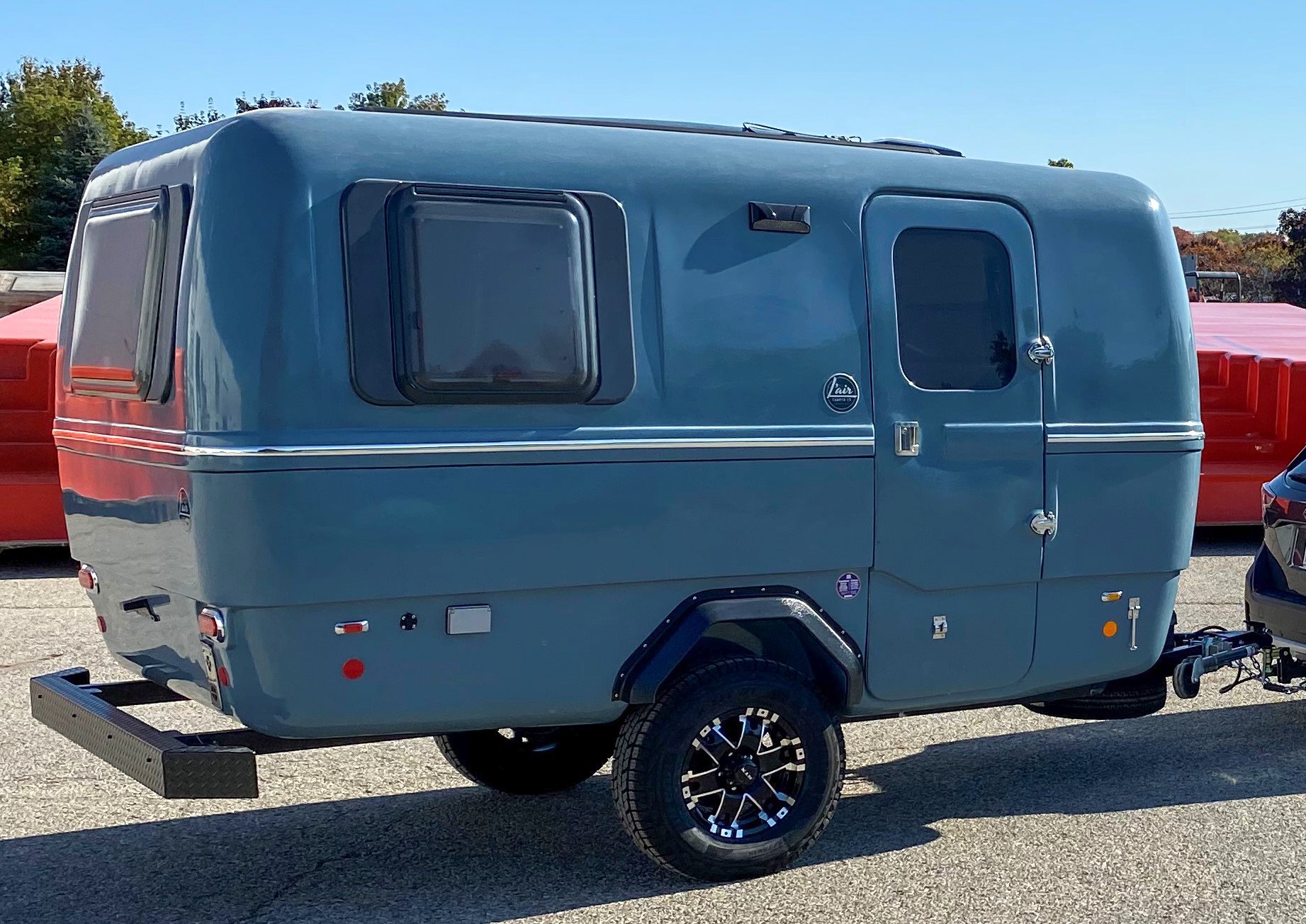
The molded fiberglass, 13-foot, 2,200-pound Lion GT model with the bathroom layout has everything needed to camp comfortably anywhere.

This small pull-behind camper features a 46″x76″ foam bed, two-burner cooktop, microwave, fridge, 12V/110V and solar power , A/C, furnace, hot water, inside shower, cassette toilet, 8-foot awning, and decent storage.
The Lion version has 15″ wheels, all-terrain tires, fender flares, gray marine upholstery, and roof rails for gear racks.
L’Air Camper Company Trillium Lion 1300 GT Features
- Hitch weight: 165 lbs.
- Gross vehicle weight rating: 2,200 lbs.
- Unloaded vehicle weight: 1,500 lbs.
- Exterior length: 13′ 5″
- Full exterior height: 7′ 6″
- Exterior width: 6′ 6″
- Interior height: 6′ 2″
- Freshwater capacity: 13 gallons
- Gray water capacity: 13 gallons
- Black water capacity: N/A
- Base MSRP: $39,500 USD
6. 2023 InTech Sol Horizon: A Stylish, Luxury Ultralight Trailer
InTech’s new Sol Horizon is a luxurious aluminum ultralight travel trailer with a full-width U-shaped dinette up front. The big windows on three sides give expansive views of your surroundings.
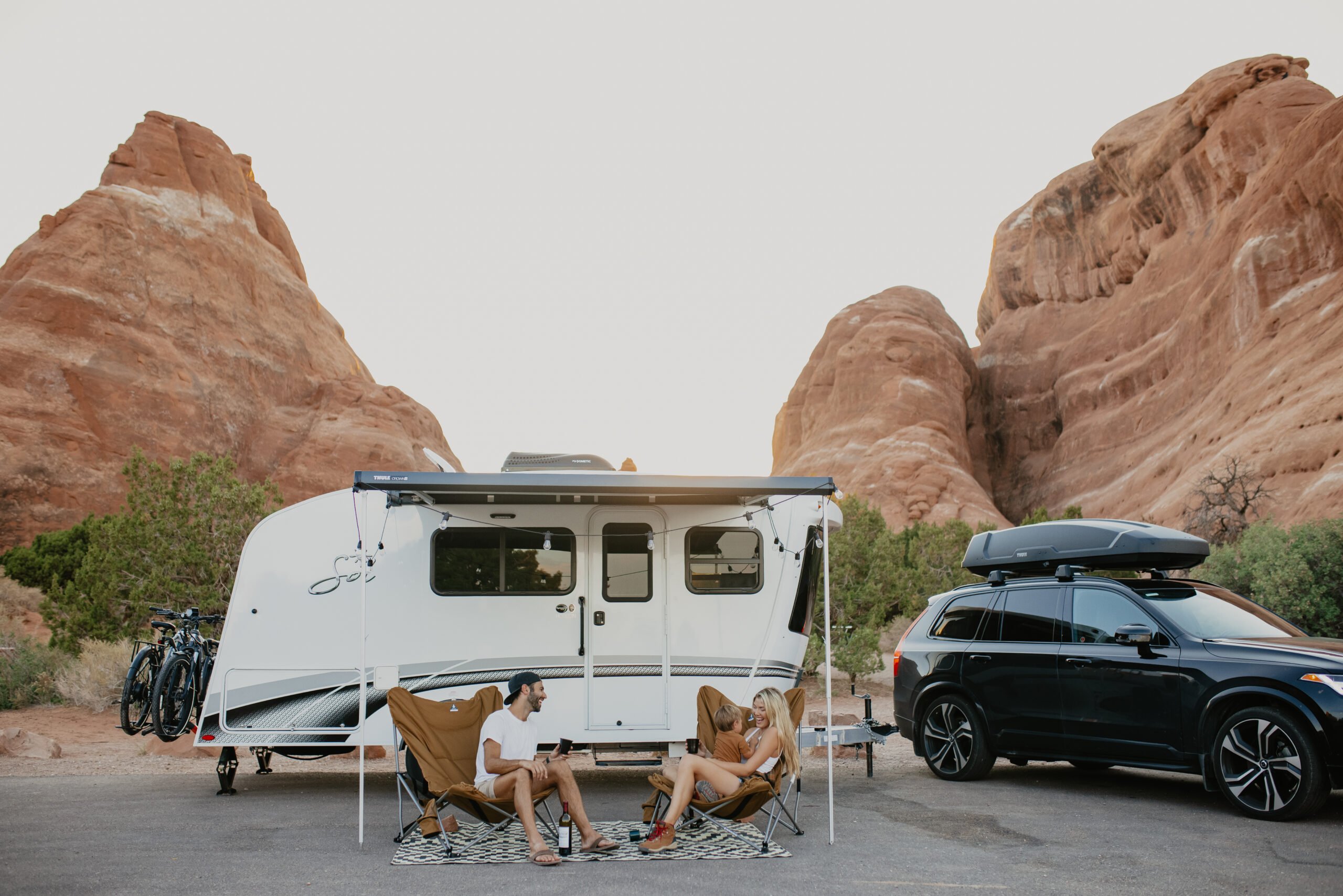
The roomy interior has a unique “tilt-forward design” that allows use of the area over the trailer’s tongue to increase sleeping/lounging space.
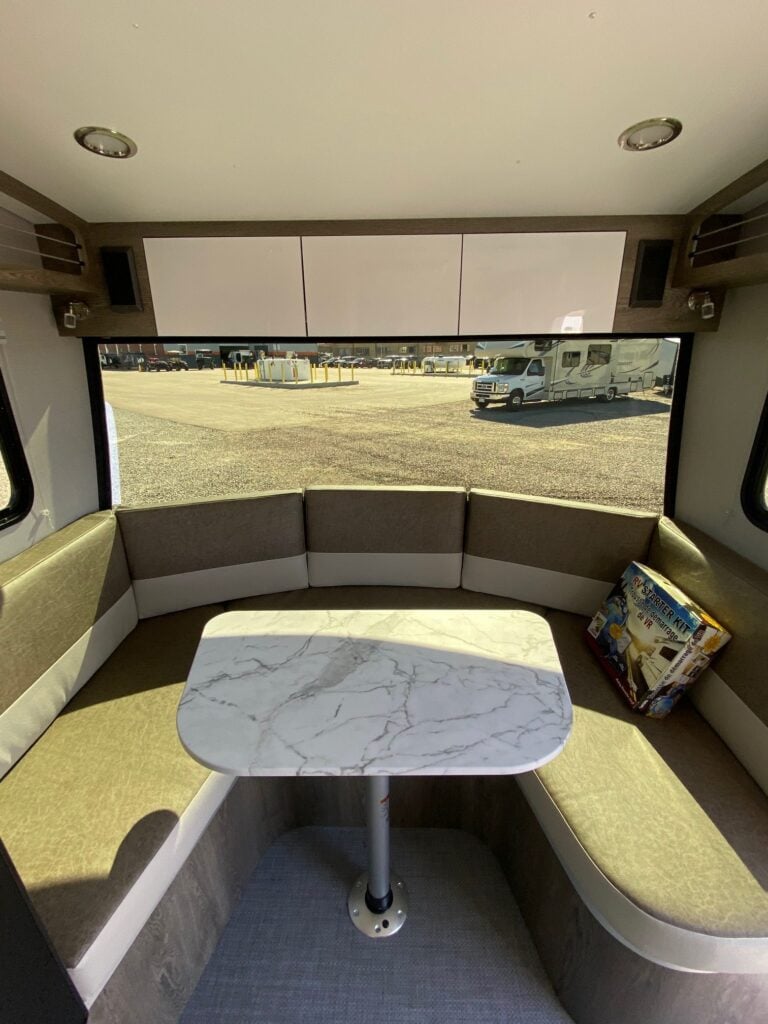
The Sol Horizon also sports a sizeable wet bath; a luxurious kitchen with an enormous farmhouse sink, commercial-grade faucet, and two-burner LP-gas stove; and an adjacent entertainment center. A 10′ awning is standard, with options such as a slide-out kitchen and solar power.
2023 InTech Sol Horizon Features
- Hitch weight: 465 lbs.
- Gross vehicle weight rating: 4,000 lbs.
- Unloaded vehicle weight: 3,372 lbs.
- Exterior length: 19′
- Full exterior height: 9′ 5″
- Exterior width: 8′ 6″
- Interior height: 6′ 6″
- Freshwater capacity: 28 gallons
- Gray water capacity: N/A
- Black water capacity: 32 gallons
- Optional dual LP-gas tanks and off-grid package
- Base MSRP: $42,539
7. Vorsheer XCT: Rugged Off-Road Campers
From the ground up, Vorsheer’s 2023 Xtreme Camp Trailer (XCT) is an adventure-style off-road trailer designed with longevity and quality in mind.
Made in Utah, the XCT has hot and cold season insulation, a composite shell, aluminum-body subframe, high-strength steel main frame, a full trailer kitchen in back, queen-size bed inside, and much more in a unique, head-turning design.
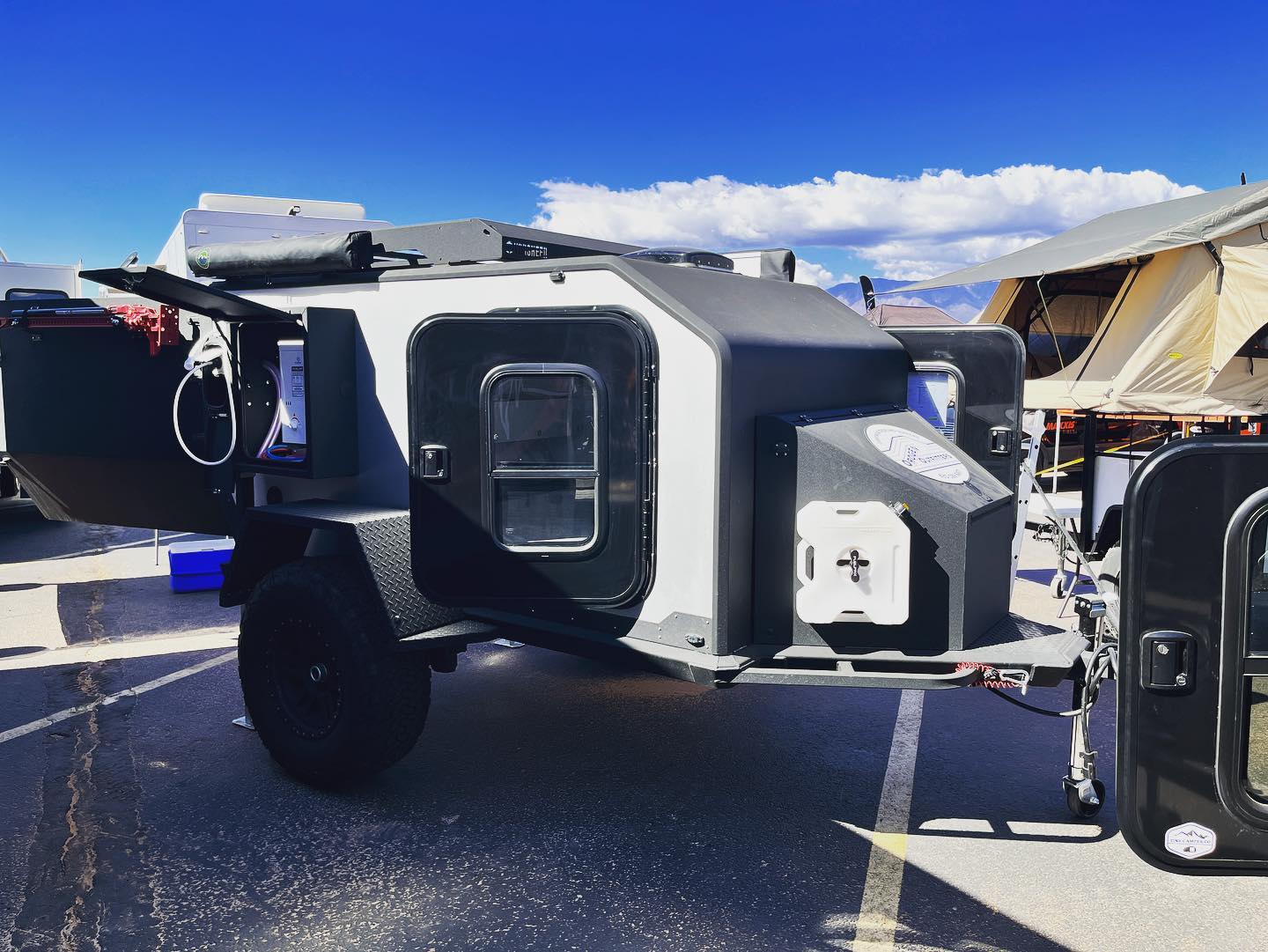
This small off-road trailer will carry a rooftop tent for added sleeping options. In addition, you can also carry adventure toys such as kayaks or a canoe.
It stands tall to handle the tougher 4×4 trails with nearly 20″ of ground clearance. If your tow vehicle can clear the obstacle, you know your trailer will too.
Vorsheer XCT Features
- Hitch weight: 260 lbs.
- Unloaded vehicle weight: 1,995 lbs.
- Full exterior height: 6′ 11″
- Freshwater capacity: 27 gallons
- Extra large 270° awning (Bat Wing)
- Optional exterior water heater and shower
- Base MSRP: $44,560
8. 2023 Mars Campers Mars 15 Deluxe: Off-Road Trailer with a King Bed and Full Bath
Mars Campers is the sister company to Black Series Campers and closely resembles their off-road campers imported from Australia into North America.
The Mars 15 Deluxe is a full-featured hybrid trailer. For example, it has a metal roof that lifts up to add headroom and a rear slide-out adds living space.
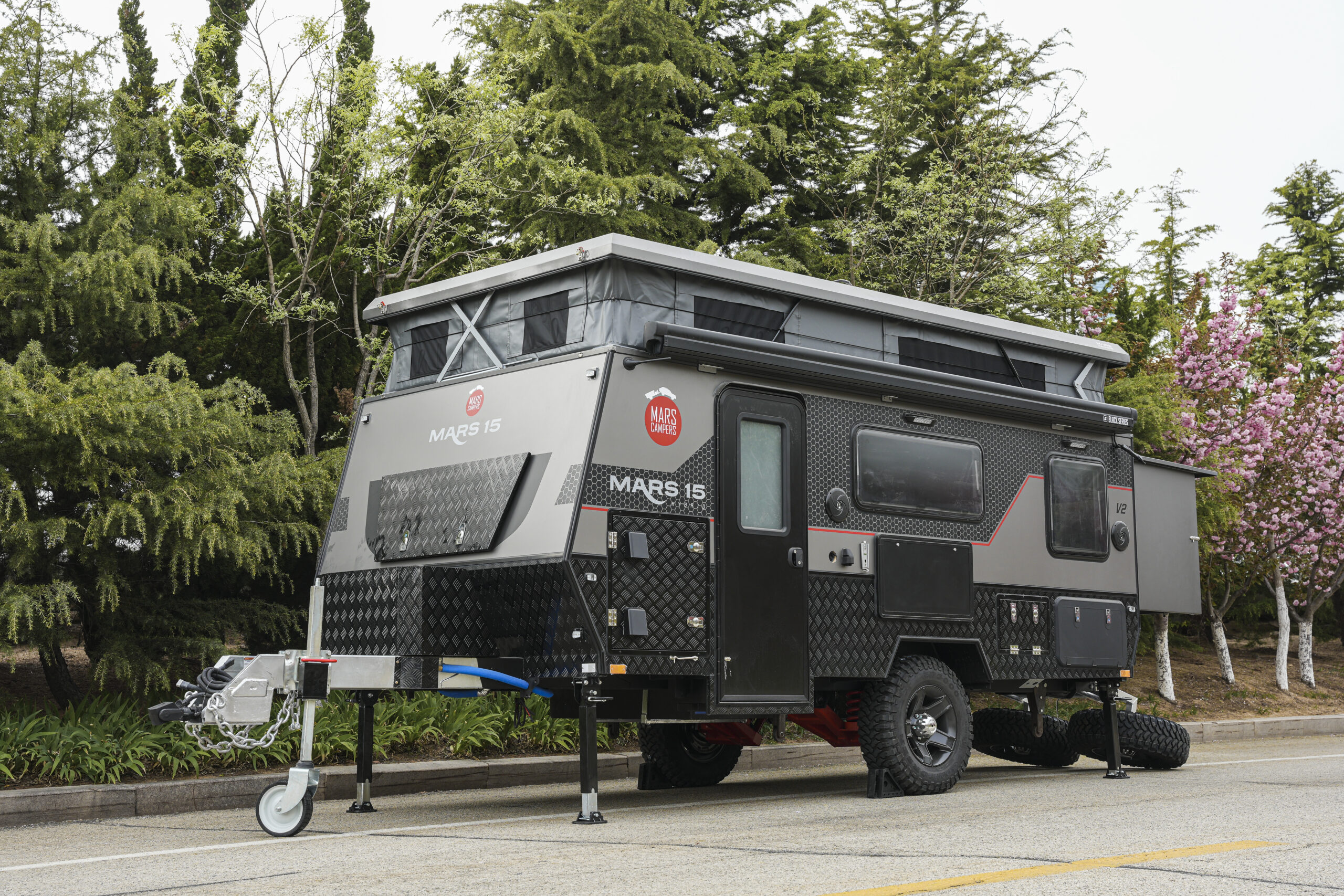
This small pull-behind trailer is solid. For instance, it’s built with rock sliders and skid plates to protect every vulnerable area. Additionally, it has an independent suspension to smooth out the ride over rough terrain.
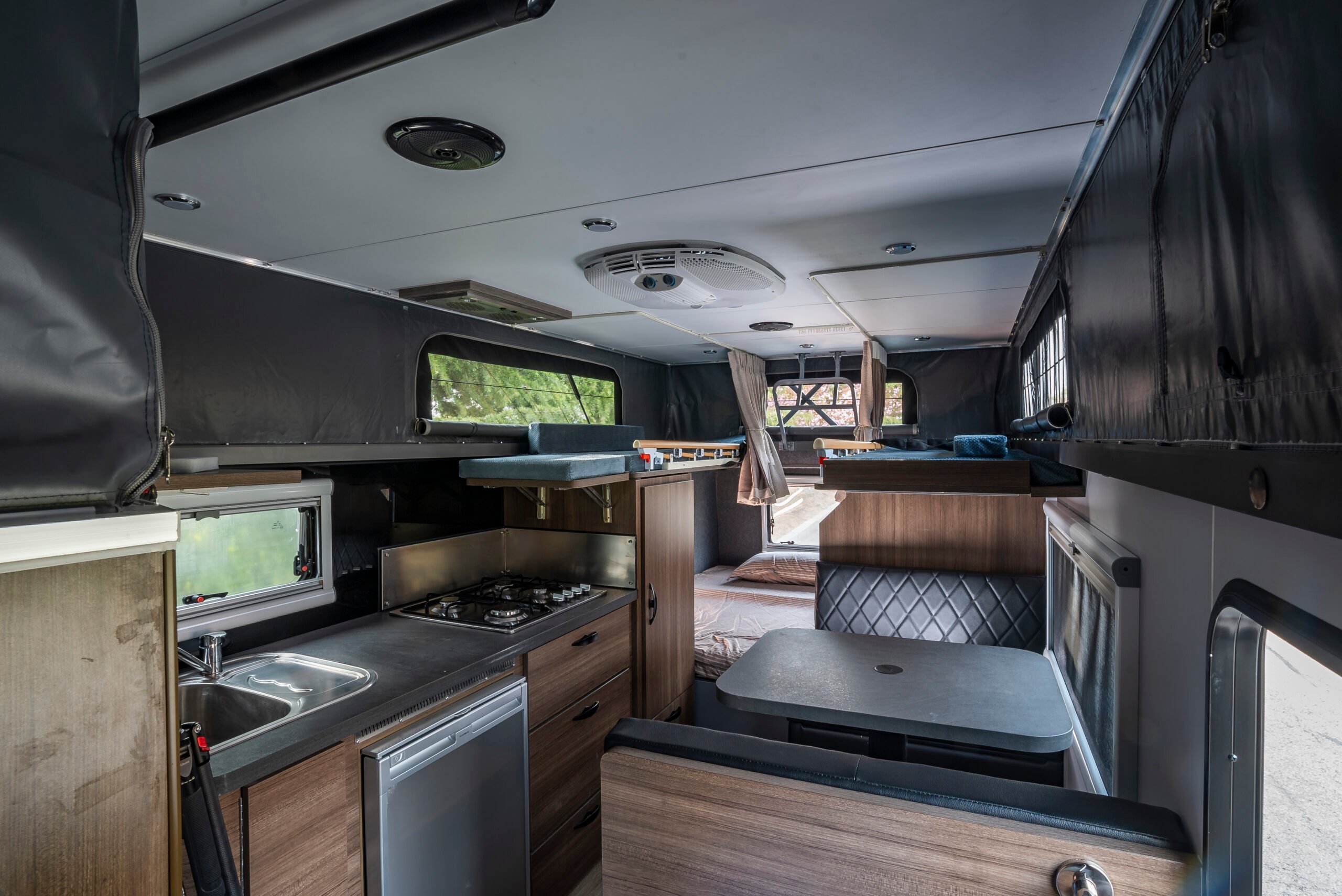
The interior is large, with a big kitchen, four-burner cooktop, fridge, and lots of storage. It also has a wet bath and the rare feature of a lightweight travel trailer with a king bed.
Additionally, the pair of fold-up bunks makes it family-friendly. You’ll love the huge slide-out kitchen and 13-foot awning too.
If you can’t get to Australia to buy it, don’t worry. The Black Series HQ12 small 4×4 trailer is a great alternative.
Mars 15 Deluxe Features
- Hitch weight: 320 lbs.
- Gross vehicle weight rating: 5,291 lbs.
- Unloaded vehicle weight: 4,409 lbs.
- Exterior length: 18′
- Full exterior height: 8′ 2″
- Exterior width: 7′ 4″
- Interior height:6’4″
- Freshwater capacity: 26.4 gallons
- Gray water capacity: 26.4 gallons
- Black water capacity: 26.4 gallons
- Base MSRP: $55,990
9. 2023 Lance Camper Enduro: An Equipped and Innovative Overlanding Trailer
This off-grid camper is built for RVers who love off-road outdoor adventures. The all-new 19′ 1″, 4,500-pound (GVWR) Lance Camper Enduro is centered around an interior wet bath with a cassette toilet, a U-shaped convertible dinette, kids drop-down bunks, and a large exterior kitchen under the rear hatch with a two-burner cooktop.
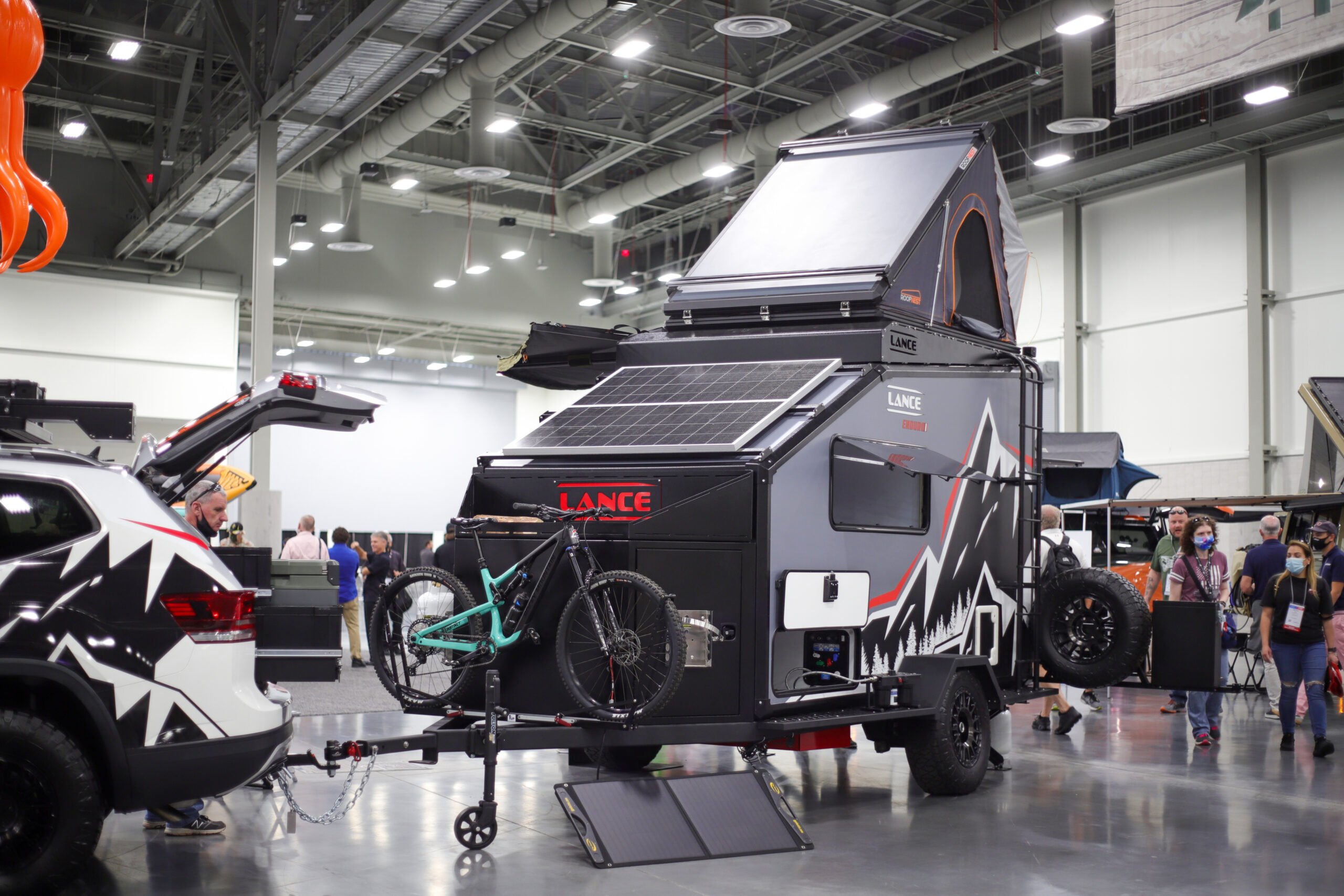
Robust solar and lithium battery technology handles the power for dry camping. Additionally, having 40 gallons of onboard freshwater and a remote filtering system gives you independence.
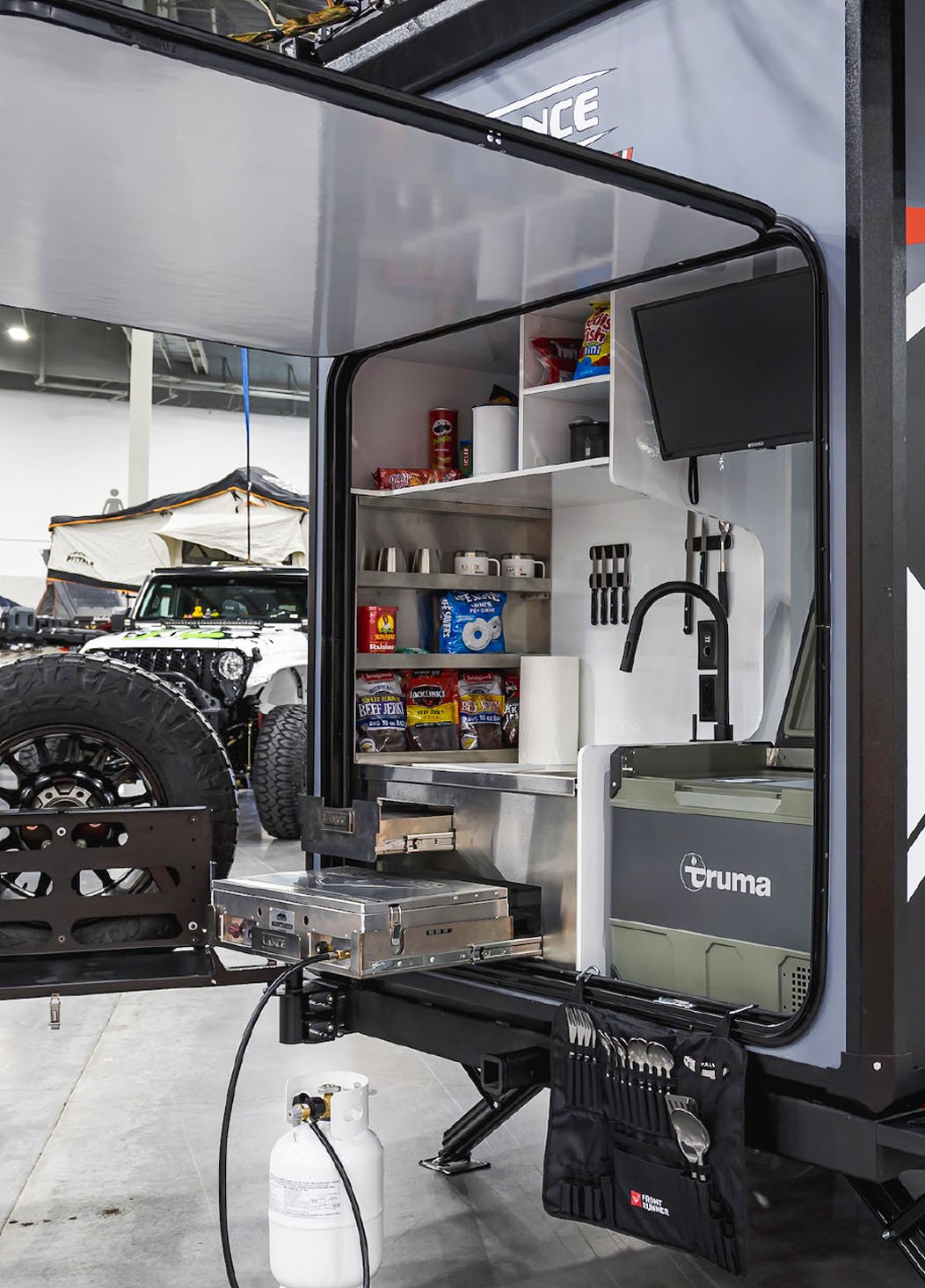
Back kitchen galley of the Lance Camper Enduro.
The prototype campers have been in development for almost two years and will hit RV dealer lots in early 2023.
2023 Lance Camper Enduro Features
- Hitch weight: 350 lbs.
- Gross vehicle weight rating: 4,500 lbs.
- Unloaded vehicle weight: 3,500 lbs.
- Exterior length: 19′ 1″
- Exterior width: 8′ 5″
- Freshwater capacity: 40 gallons
- Gray water capacity: 26 gallons
- Base MSRP: $59,000
10. 2023 Kimberley Kampers Kruiser E-Class: Small Camper with a Composting Toilet
The Kimberley Kampers Kruiser E-Class is a full-featured travel trailer from the company’s Ohio location. This luxury small camper is loaded with high-tech features, particularly the adjustable air bag suspension and the diesel-powered hot water system.
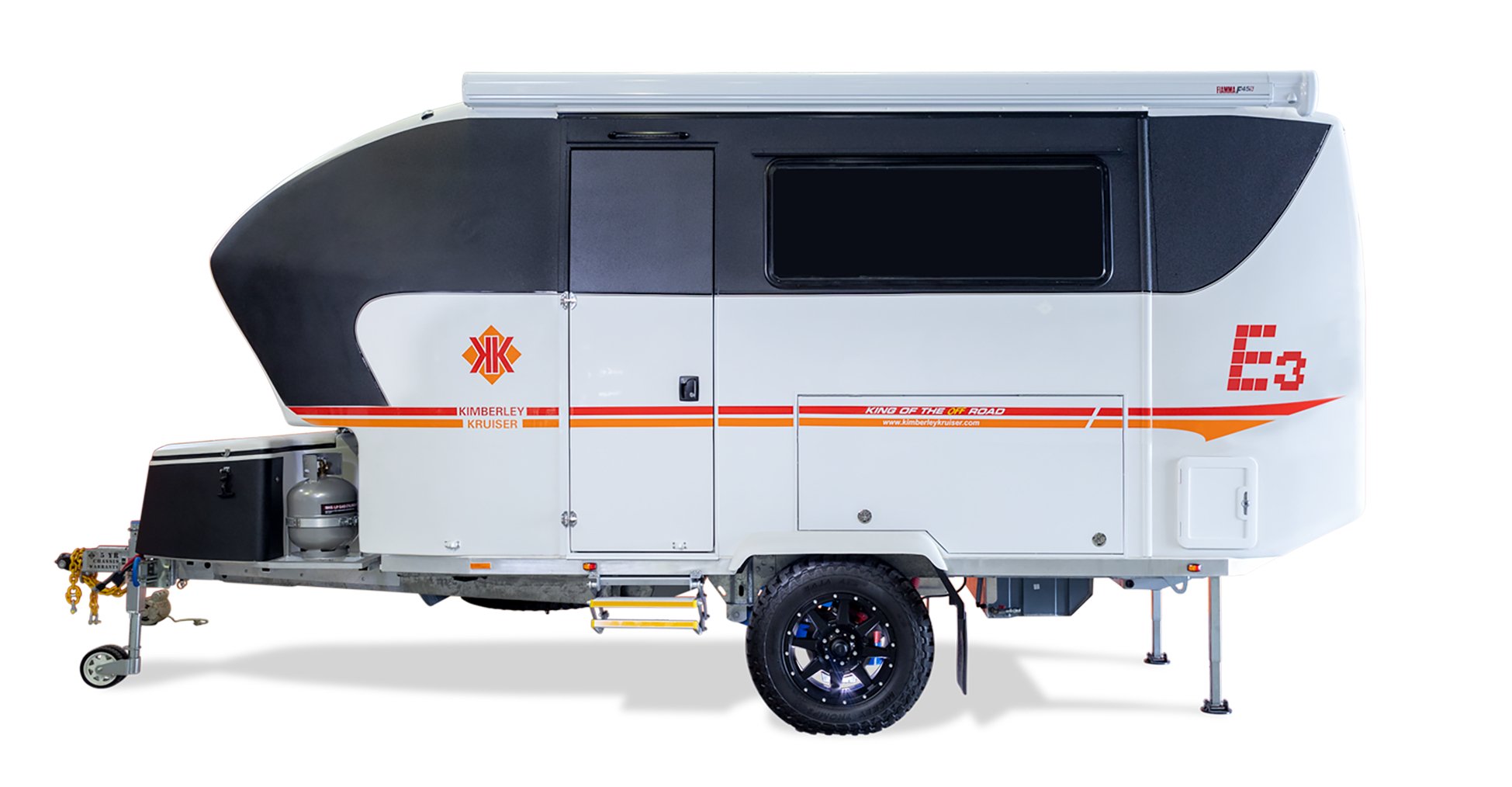
Additionally, there is a retractable island queen bed and an RV composting toilet . These travel trailers keep RVers comfortable in the outback or anywhere in North America.
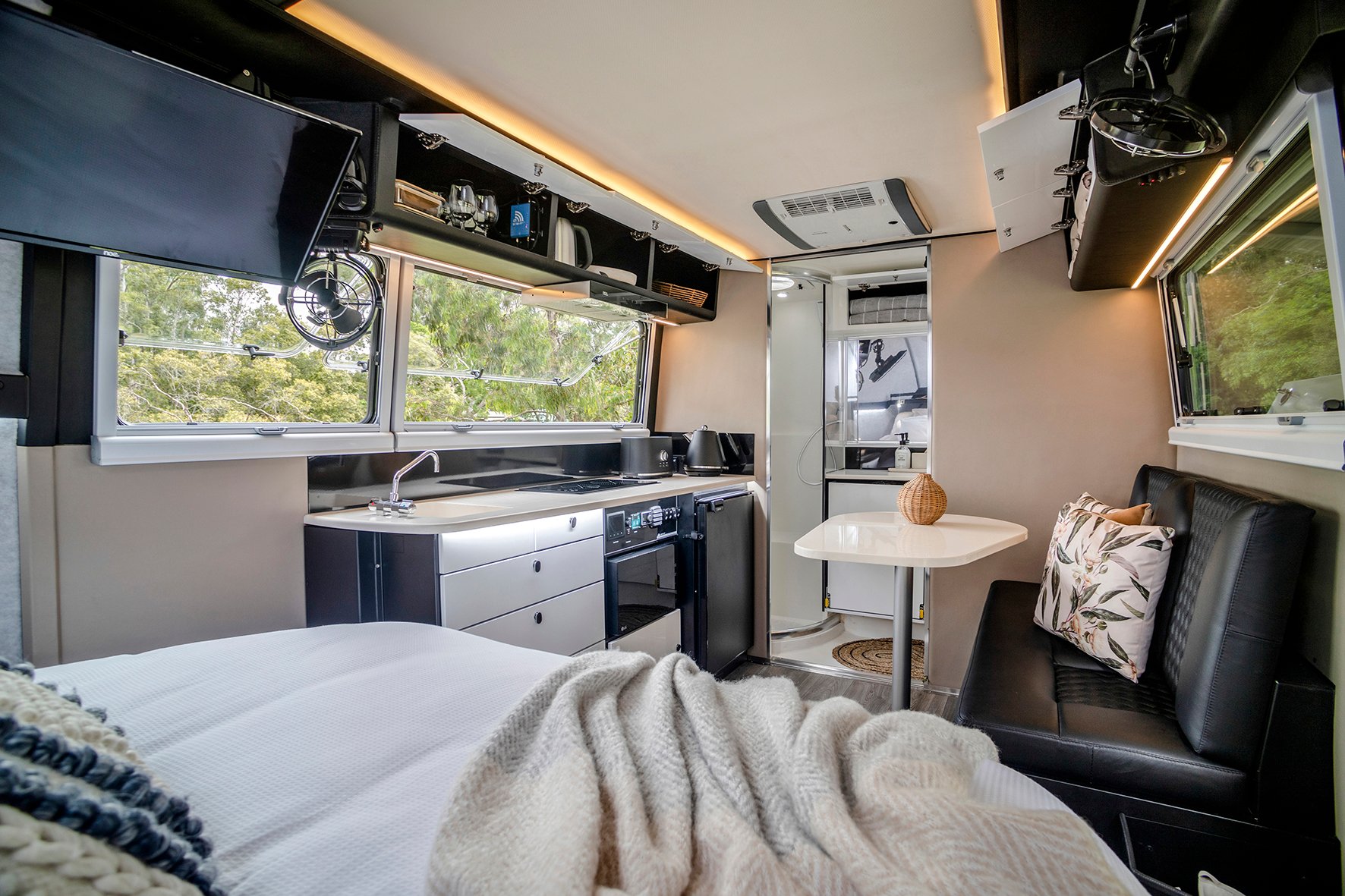
The E-Class Kruiser model has more options than many small campers . It’s easy to tailor this camper to fit any RV lifestyle.
2023 Kimberley Kampers Kruiser E-Class Features
- Hitch weight: 265 lbs.
- Gross vehicle weight rating: 5,500 lbs.
- Unloaded vehicle weight: 3,836 lbs.
- Exterior length: 17′
- Full exterior height: 9′ 8″
- Freshwater capacity: 50 gallons
- Gray water capacity: 16 gallons
- Black water capacity: Waterless Composting Toilet
- Base MSRP: $89,268
Editor’s note: RV production costs are in flux. Base costs for these small towable RVs may have changed since Q4 2022 (when we created this list of the best lightweight travel trailer reviews for 2023).
Meet other lightweight travel trailer owners
One of the best parts about RVing is meeting other camping fans. Learn more from owners of expandable, hybrids, & light travel trailer campers in the iRV2 Discussion Forums . Get other perspectives on the best small travel trailers, light tow vehicles, RV products, great camping spots, hacks and mods, and much more.
Related articles:
- 10 Best Lightweight Travel Trailers of 2022
- What Is Your Gross Vehicle Weight (And Why Does It Matter)?
- Motorhome Classes
- Travel Trailer
- Fifth Wheel
- Pop Up Camper
- Teardrop Camper
- Hybrid Camper
- Truck Camper
- RV Manufacturers
- Best RV Brands
- Buying An RV
- Backup Camera
- Electric Trailer Jack
- Portable Generator
- Portable Refrigerator
- Portable Solar Panel
- RV Power Cord
- RV Surge Protector
- RV Vent Fan
- RV Camping Chair
- Camping Table
- Portable Dog Playpen
- Propane Fire Pit
- RV Leveling Block
- RV Patio Mat
- RV Wheel Chock
- Wood Burning Fire Pit
- Portable Camping Toilet
- RV Black Tank Treatment
- RV Macerator Pump
- RV Portable Waste Tank
- RV Sewer Hose
- RV Shower Head
- RV Toilet Paper
- RV Water Pump
- Towed Vehicle Braking System
- Weight Distribution Hitch
- 12-Volt Air Compressor
- Collapsible RV Ladder
- Discount Camping Club
- Good Sam Club Membership
- Portable Propane Heater
- RV Mattress
- RV Step Cover
- Quick Reviews
- Full-Time RV Living
- RV Upgrades
- RV Boondocking
- Public Lands
- Overnight RV Parking
- Amazon Storefront
- Must-Have RV Accessories
- Travel Trailer Accessories
- Pop-Up Camper Accessories
- RV Kitchen Accessories
- Luxe RV Accessories
- Gifts For RV Owners
- RVers Online University
- Talk To RV Mechanic
- About Camp Addict
- Events & Press
We may earn money when you make a purchase via links on this page. Learn more
- Camp Addict
- 🏕️ RV Leveling Block Reviews
Best RV Leveling Blocks in 2024
(Camp Addict does NOT accept payment from any company to review or endorse their products.)
It shouldn't be shocking if we tell you that living in a camper that is not leveled with RV leveling blocks is potentially dangerous as well as awkward (on un-level terrain).
Trying to walk on a floor that isn't level is the strangest feeling. And it can be a fire hazard for your absorption refrigerator.
Not fun.
And camping should be safe and fun, shouldn't it?
RV leveling blocks get your rig level at your favorite campsite. Additionally, RV levelers are a pretty simple tool that every camper needs.
Read the RV leveling block reviews below to learn which we consider to be the best.
If you want to learn more about this equipment, read our RV Levelers Guide .
RV Leveling Block Guide
Which type of leveling block is best for your RV?
What are the options available?
Read our RV Levelers Guide to learn about the different types of RV blocks and which style might work best for your rig.
Best RV Leveling Block Reviews
The ins and the outs, the good and the bad, it's all here in our reviews of the best leveling systems you can get.
Undeniably, your rig needs to be level if you have an absorption refrigerator. This type of fridge kept unlevel long enough, will kill it, OR cause it to catch fire. As we have noted, most RV's use absorption refrigerators.
Besides, who wants to walk around and sleep in a tilted environment?
At any rate, these levelers will keep you nice and level in the most questionable spots and for most people, these are must-have accessories for a camper .
Easiest RV Leveler to Use
Andersen Camper Leveler
- Very simple design makes it the easiest to use/get right
- Eliminates possible multiple changing of height when using RV leveling blocks
- Doesn't take up much space
- Available in single or 2-pack
- Lifetime warranty
- Weight and tire size restrictions
The Andersen Camper Leveler system is an ingenious design in the RV leveler world.
Gone are the days you have to GUESS how many RV leveling blocks to put under your tires to get level.
Continue Reading Andersen Camper Leveler System Review
Both Kelly and Marshall of Camp Addict use (and LOVE) Andersen levelers.
We still have block-style levelers as there are times when the Andersens aren't high enough.
Main Benefit of Andersens Over Lynx Levelers
The issue with Lego-style leveling blocks is that if you get the number of RV leveling blocks you stack wrong, there's a lot of re-organizing necessary to get it right.
It's a PITA to change and it takes time.
First, you have to get back in your rig or tow vehicle, back off of the blocks, get out, re-stack, get back in, pull forward and try again.
Needless to say, it's a pain.
Single Andersen Camper Leveler
Using the Andersen Camper Leveler RV ramps system is very simple.
You only have to put the wedge in front of or behind your wheel(s), get in, and move until your partner tells you that you are level.
Even if you are solo, you can easily get out, check and get back in to either go forward or backward to adjust the height without having to remove or add blocks.
It works like a charm!
(Or you can get a leveling system that will tell you on your phone when you are level. The LevelMate Pro works very well for this. See more in the guide section.)
Do They Work With Large Motorhomes?
Yes, Andersen Levelers can be used on motorhomes with a couple of considerations.
1) Works if your rig weighs 30,000 pounds or less.
2) They fit tires up to 32 inches in diameter.
Also, if your motorhome has dual rear tires (most do), then you will want to use two Andersen Levelers per side in the rear so that each of the tires is on a leveler.
Video Proof of Safety and Ease of Use
We found a very detailed online video by The Fit RV (James).
In the video, James talks about how he was afraid to pull too far forward with his Travato Class B motorhome while testing the Andersen Levelers.
His thinking was that if he pulled off the 4" end, the Anderson Leveler might damage his rig by hitting his running boards or something else.
This was a legit fear.
James tests things very thoroughly most of the time, and we certainly trust and enjoy his videos and conclusions.
Andersen Leveler Alternative
Consider the Beech Lane Camper Leveler as an alternative to the Andersen Levelers. They work the same way but can be purchased for a little less money.
However, in his testing of the Anderson Leveler, we question this one part which he did not test.
Because he was afraid of pulling forward too far, he did not test 'the roll-off' of the 4" edge of the Anderson Camper Leveler.
This leaves an unanswered question: would the Anderson Levelers damage a low-riding rig?
In the video below by Anderson Levelers, they do demonstrate the roll-off on the 4" end. If you watch, you can see how the tires roll off the 4" end VERY smoothly.
Additionally, the Anderson Camper Leveler seems to pretty much stay conformed to the tires until the pressure is totally off of the levelers.
You might think that the vehicle would drop off of the Anderson Levelers, but if you go slow enough, that's not the case.
The below video proof is enough to tell whether you think your rig would suffer any damage or not.
After we watched, we don't see how ANY rig could get damaged.
The Anderson Levelers stay conformed to the tires until the weight is totally off of them.
The worst they can do once the weight is off the levelers is to tip over and lean against whatever they may touch.
By then your rig has stopped moving.
Additionally, these RV levelers can be cut shorter at the narrow edge of the device, per the manufacturer ( instructions here - PDF).
That's exactly what Marshall did with his since his tires are so close together.
Marshall cut the one on the right.
Even cut, it still barely fits in between his tires.
This will also keep it from being able to stab into any part of your unit once you drive off of it.
It would also help if you have tires that are very close together just like Marshall's rig.
This shows how much Marshall cut off in order to get the leveler in between the tires.
As long as you don't keep pulling forward once your rig is off, it looks to us that any kind of rig is safe from damage.
Here's the video proof.
If you are strapped for time, fast forward to the 1:10 mark.
Andersen Camper Leveler Manufacturer Demo
Also, James brings up the issue of the degree of change when trying to level from front to back.
But wouldn't this be the case with leveling blocks as well?
Because the wheelbase is wider front to back, the lift of the tires will be of a lesser degree than the lift will be side-to-side.
With a travel trailer, this is compensated by using the tongue jack to raise or lower the front end.
In that case, the tongue jack can be raised or lowered much more than you could raise or lower it simply using blocks or the Andersen Camper Leveler.
Here's the FitRV video (James) explaining his testing the Andersen Camper Leveler with his Travato Class B motorhome:
Anderson Camper Leveler Demo by The Fit RV
We included both videos so you can decide for yourself if the Anderson Levelers will or won't work with your rig.
And to clarify about the roll-off of the high end, we both have pulled off of that end and had zero issues.
(In the guide section of this page, below, you may read Amanda Watson's review of her Anderson Leveler)
- Download the Anderson Leveler di mensions and trim guide here (PDF).
Andersen Leveler Purchase Options
There are a few different ways to purchase the Andersen Camper Leveler.
Here is a brief rundown on the purchase options:
- Individually, or as a set of two
- With the optional rubber mats (only available in a 2-pack) which help keep the levelers from sliding on a slick surface
- Purchase a carry bag either by itself or with a two-pack of levelers (with or without the rubber mat)
Whew! That's a lot of options!
Here are the links to purchase via Amazon:
Just the Andersen Levelers
Single Andersen Leveler
Andersen Levelers w/Rubber Mats
(Only Available in a Pack of 2 RV Levelers)
Andersen Leveler with Rubber Mat
2-Pack w/Rubber Mats
Andersen Levelers w/Carry Bag
Andersen leveler carry bag only.
Carry Bag Only
Anderson Camper Leveler Features and Specs:
- Each Andersen Camper Leveler comes with the leveler itself and a chock
- Available to purchase as a single leveler or as a 2-pack, as well as with optional rubber pad and/or carrying bag
- Fits tires up to 32" in diameter
- Levels anywhere between 1/2 to 4" increments
- For tires close together, up to 4" can be sawed off of the narrow end of the leveler. Instructions here (PDF).
- Weight Limit: 30,000 lbs
- Dimensions: 15 5/8" Long x 6" Wide x 4 1/4" Tall
- Made in the USA
- Lifetime part replacement warranty
Best RV Leveling Blocks
Lynx Levelers
- Fairly easy to set up
- Can start to crack and fail
- You have to guess how many blocks to use, must change out if you get it wrong the first time.
Lynx Levelers are extremely popular RV leveling blocks. It's likely something you have seen before at the campground.
You know, those bright orange stackable thingys you see under tires.
Those are usually Lynx Levelers and they are leveling out the RV they are under.
Continue Reading Lynx Levelers Review
Lynx Levelers 10 Pack
RV leveling blocks are arguably the most common system of manually leveling your ride. Lynx Levelers are arguably the most popular brand of this type of RV leveler.
In addition to leveling, they are made in a way to allow water pass through but also to grip the ground.
How Lynx Levelers Work
These are designed like building blocks that stack on top of each other securely. (They work much like LEGOS.) Or, use just one leveling block under each tire. It depends on how off-level you are.
If needed, use multiple leveling blocks. You can even build a 'pyramid' of sorts to roll up onto. Get on top of the levelers and then check your level.
If you misjudged the number of 'blocks' to use, you have to pull off of the Lynx Levelers and re-stack until you get it right.
Learning Your Lynx Levelers
Each Lynx Leveler will give you approximately 1 inch of 'lift'.
You will get pretty good at estimating how tall of a stack of Lynx Levelers you need if you know how many inches from level you are side-to-side.
If you have a bubble level installed, it will give you a very good idea of where to start.
Kelly's Lynx Levelers. Not centered on the top just yet.
These work great for single axle trailers as well as double axle trailers. However, it can be an issue if you have double axles set very close together.
There may not be enough room in between the axles to set up more than a height of 2 levelers.
You'll do a lot of back-and-forth maneuvering to get them stacked.
(Or, you can follow the instructions in the below video on how to level your tandem/dual axle RV with Lynx Levelers.)
Or, you might need to get two sets of RV leveling blocks.
You can build one solid ramp in front of your wheels so you can drive onto the solid stack of levelers.
Normally, this requires more than just the 10 blocks that come in one Lynx Leveler kit.
How to Level Single Axle RV with Lynx Levelers
How to Level Dual Axle RV with Lynx Levelers
Possible Issues
On rocky ground, Lynx Levelers may develop stress cracks due to their honeycomb construction.
Well, they are made to be on unlevel ground, aren't they? Sure, but this doesn't stop them from cracking. Even so, they do tend to last quite a long time.
And yes, they will fade if kept out in the sun quite a bit.
Optional Lynx Leveler Accessories
There are a couple of optional accessories you can purchase to use with your Lynx Levelers:
Lynx Caps are used on top of Lynx Levelers to provide a smooth surface for your tires to be on.
Additionally, they provide a flat surface for your tongue jacks or stabilizers. Lynx Leveler Caps come in a pack of 4.
Lynx Caps 4-Pack
Lynx Leveler Cap Used At Trailer Front Jack
Lynx Caps (4-pack)
Lynx Stop 'N Chock
Lynx Stop 'N Chock are used as wheel chocks and/or stops (when pulling up onto your Lynx Levelers) and 'lock' into the Lynx Levelers.
Lynx Stop 'N Chock come in a 2-pack.
Lynx Stop 'N Chock In Use
Lynx Stop 'N Chock (2-pack)
Lynx Leveler Warranty
This leveling block system comes with a 10-year warranty. The Lynx Levelers website has a place to register your product.
If something happens and your levelers break within the first year, you will not have to pay for shipping on the new product.
Because they are durable, pretty easy to use, and they are economically priced, Lynx Levelers get very good reviews and are well received.
Presently, they are also the type of RV leveling blocks that both Camp Addict's co-founders have and sometimes use in situations when the Andersens aren't tall enough.
Stabilizing Your RV With Lynx Levelers
You can use Lynx Levelers (and optionally Lynx Caps) to create a stable 'landing pad' for your RV's stabilizers.
This is particularly useful when you are parked on a softer surface that your stabilizer might sink into.
How To Stabilize Your RV With Lynx Levelers
Lynx Levelers RV Leveling Blocks Features and Specs:
- Sold in a 10 pack
- Comes in a blue nylon zipper bag
- Very lightweight: Bag of 10 Lynx Levelers weighs just a few pounds
- Can also be used as a support base for hitch, jacks
- Dimensions: 8.5 x 8.5 x 1.5"
- Weight Limit: 40,000 lbs
- Warranty: 10 years
Runner-Up RV Leveling Blocks
Camco Leveling Blocks
- Fairly easy to use, locks in place
- Camco doesn't specify a weight limit
- 1-Year warranty versus Lynx's 10-year warranty
Camco is our-runner up for RV leveling blocks. While still a nice product, the downside of the Camco is its very limited warranty.
Additionally, they only a one-year warranty compared to Lynx Leveler's 10-year warranty.
Camco FasTen Leveling Blocks
Continue Reading Camco RV Leveling Blocks Review
Camco's RV leveling blocks run pretty close to the same price as our #1 choice, the Lynx Levelers . This makes them a great alternative.
You really cannot go wrong with either choice.
We only have personal experience with the Lynx Levelers. Moreover, Lynx Levelers state the weight rating, while these Camco levelers do not.
Camco also has a version (FasTen) that is twice as wide as the Lynx Levelers.
Camco RV Leveling Blocks
Lynx is not the only producer of leveling blocks in the game.
Camco has fairly similar reviews and does offer the FasTen version (wide).
We leave the decision on which you prefer up to you.
Camco FasTen Levelers for Dually Wheels
Camco also makes a much wider set of RV leveling blocks for dually wheels.
It's a GREAT solution for campers with this type of wheel system, though it's unclear why Lynx has not stepped up and made a similar product.
Here's a great video below showing them in action.
Camco FasTen 4x2 Blocks for Dually Wheels
Camco FasTen RV Leveling Blocks (For Dual Wheels)
Camco RV Leveling Blocks Features and Specs:
- 10 leveling blocks to a pack
- Comes with zippered storage bag ( smaller sized 'normal' Camco RV leveling blocks )
- Comes with carrying handle ( larger sized FasTen RV leveling blocks )
- Solid bottom resists sinking into the ground
- Plastic resin is UV stabilized
- Regular Camco Leveling Block Dimensions: 8.5" Wide x 8.5" Deep x 1" Tall
- FasTen Dually Leveling Block Dimensions: 17" Wide x 8" Deep x 1" Tall
- Weight Limit: Per Camco tech support, they don't specify a weight limit as different limits will apply depending on what terrain the blocks are used on. For example, if the leveling blocks are used on concrete they can withstand a lot more weight then if they are used on rocky, uneven terrain.
- Warranty: 1 year
Best 'Different' Leveler
BAL Light Trailer Tire Leveler
Suitable for VERY Light Trailers Only!
- Easy to set up - easier than blocks
- People seem to like it in reviews
- Eliminates trial and error of RV leveling blocks
- Might sink into soft dirt/mud
- Only for lightweight trailers
We have not ever used this type of system and don't have any friends who have used it.
But because it's out there and it's well-reviewed, we decided to list it as an option.
The BAL Light Trailer Tire Leveler looks pretty easy to use and mechanically functional, but only for lighter, smaller trailers such as popups ( average weight of a pop up camper ), teardrops, and Casita campers under 1,700 lbs .
Continue Reading BAL Light Trailer Leveler Review
The BAL Light Trailer Tire Leveler only has you backing onto it once, or you slide it around your tire.
From there, you ratchet the scissor-style unit to lift your tire.
We don't see any flaws aside from the annoyance of the ratcheting that one has to do to lift and lower your rig.
Oh, there is also the 'minor' issue of this system sinking into soft ground, so it's probably best to use on hard surfaces only.
Moreover, this system also COULD alleviate having to chock the other side, but we still recommend sticking with a separate chock.
Consequently, due to the size, the BAL Light Trailer Tire Leveler can only be used with lightweight rigs (1,700-pound limit).
BAL Light Trailer Leveler Features and Specs:
- Material: Steel with corrosion resistant finish
- Fits 13", 14" and most 15" wheels
- Weight: 14 lbs
- imensions: 22" x 19" x 3.8"
- Weight Limit: 1,700 lbs
Hopkins Towing Endurance Leveling System
There's also an RV leveling block system called the Hopkins Towing Solutions Endurance Leveling Kit.
The system requires a lot of work on your part to make them. They aren't any cheaper than the others, which don't require you to build any part of the system at all.
We aren't reviewing them, but if you are an avid do-it-yourselfer, this system might be for you. Check out the video below to have a look at what is entailed.
(It involves you using your own wood to create blocks to drive your rig on.
- Download the Hopkins Endurance Leveling System manual here (PDF).
Beech Lane Leveling System - An Andersen Alternative
The Beech Lane Camper Leveler is very similar to the Andersen Camper Leveler .
It is a wedge-style leveler with a chock to help 'lock' it into place. And they have similar dimensions to the Andersen Leveler.
It is slightly better rated.
Also, it can take 5,000 pounds more weight capacity (35,000 pounds versus 30,000 pounds).
Beech Lane Leveler Grip Tape Issues
The single pack Beech Lane Leveler comes with grip tape installed on the tire side of the leveler. Reviewers complain that this tape comes off fairly easily.
Beech Lane says to let your tires cool down before using the levelers with grip tape.
This is because tire heat can cause the tape to lose adhesion (yeah, because it's really practical to wait until your tires cool off before leveling your rig).
Or, they say you can remove the tape. Which defeats the purpose of having the tape. Sigh.
Due to the issues with the grip tape not working so great, Beech Lane has done away with it on the 2-pack version of their camper levelers.
Now, instead of the grip tape, they have included two rubber mats (just like Andersen has available) which help to prevent these RV levelers from slipping as you roll your rig up onto them.
Why they don't include the rubber mat instead of the grip tape on the single pack of their RV leveling ramps is beyond us.
The Beech Lane Camper Levelers can be purchased for a little less money than the Andersen RV Levelers. This gives a competitive reason to consider them.
Single Beech Lane Leveler with Grip Tape
2-Pack (single shown) Includes Rubber Mat
Beech Lane Camper Levelers Features and Specs:
- Each Beech Lane Camper Leveler comes with the leveler itself and a chock
- Available to purchase as a single leveler or as a 2-pack (2-pack comes with rubber pads)
- For tires close together, up to 4" can be sawed off of the narrow end of the leveler
- Weight Limit: 35,000 lbs
- Dimensions: 15" Long x 6" Wide x 4" Tall
Depending on what size and type of rig you have, the above reviews will help you select the right RV leveling blocks to fit your needs.
You can also read our RV Levelers Guide to learn more about leveling blocks.
We think that the Andersen Camper Leveler is the top dog here as it has a lifetime warranty and can be used with any size or style rig (within reason).
Still, the price tag might not work for you, so we featured other more economical options.
Whatever you do, don't get analysis paralysis. Make a decision so you can get on the road that much sooner!
Camp on, Addicts!
Authors: Kelly Beasley & Marshall Wendler
Kelly Beasley
He-llllo. I'm the co-founder of Camp Addict , which my biz partner and I launched in 2017. I frigging love the RVing lifestyle but in December of 2020, I converted to part-time RV life. Heck, I lived in my travel trailer for over 5.5 years, STRICTLY boondocking for pretty much all of it. Boondocking is a GREAT way to live, but it's not easy. Anyway, I'm passionate about animals, can't stand campgrounds, I hardly ever cook, and I love a good dance party. Currently, I can be found plotting and scheming whether or not to start collecting farm animals (or plotting my next RV trip!) at my beautiful new 'ranch' named 'Hotel Kellyfornia', in Southern Arizona.
Marshall Wendler
Camp Addict co-founder Marshall Wendler brings his technical expertise to help explain RV products in an easy to understand fashion. Full-time RVing from April 2014 - December 2020 (now RVing about 50% of the time), Marshall loves sharing his knowledge of the RV lifestyle. Marshall spends the majority of his RVing life boondocking. He is the part of Camp Addict that knows 'all the things'. He's good at sharing his technical knowledge so you can benefit.
I have read so many bad reviews of the Anderson’s I decided to stay away from them (so many reviews of them breaking on grass, concrete and gravel!) Up to this point I have been using the orange leveling blocks for the last couple of years and they have been really great. They have held up well, are easy to use and also act as supports under the stabilizers (double duty!) My bubble levels on the sides of the camper tell me how many inches I am off, which corresponds to how many blocks to use (each block is an inch). It’s actually quite easy and fast. However, there is no doubt that the wedge style would be even simpler, and even faster! So, I opted for the Beech Lane’s. Overall, they have much better reviews than the Andreson’s (which seem to break really easy), were a little less expensive, and also has a life time warranty. Now I will be able to use the Beech Lane levelers on most un-level situations, but for the really off situations I can break out my leveling blocks. You know that old saying… 2 is 1, and 1 is none!
Yep, we also like the Beech Lane’s. Glad to hear they have served you well. I love my levelers, I have the Andersens.
The only time they can be annoying is on a smooth hard surface as they will sometimes slide. (I boondock full-time and RARELY ever park/need to level on pavement or concrete) Marshall got the ‘skid’ mats for his, and I once used his to stop the sliding.
Wedge levelers are a remarkable invention! (I still occasionally have to use my lynx levelers if the Andersens won’t get me level enough.)
The RV is not level, it is really uncomfortable. I think the information you provided, it’s great! I will try it with my RV. Thank you very much!
Hi Natalie,
Sure thing! Yes, and it’s also important to be level if you have an absorption refrigerator.
Feels much better when living in it, too.
Sleep level and camp on!
I’m a the brand new owner of a W Travato 2015 and have a question I think I know the answer to but just want to be sure. I’m a solo female and want to purchase the Anderson levelers. To level in all directions I will need 3 levelers, correct? Thank you !!!!!
Congratulations on your new RV!
Yes, that sounds about right – three levelers. Four would never be necessary (unless I’m missing a scenario in my mind) and hopefully you would rarely have to ever use three.
We have a good friend that doesn’t even carry levelers with his Class B. He just moves his rig (a lot sometimes!) to find level enough. Of course this is while boondocking so he usually has a decent sized area to maneuver in. And if you want ‘that view’ that requires you to be pointed in a particular direction, then levelers may be mandatory.
If you are parking at a campground, and the pad is unlevel, then you have no choice but to use levelers.
Enjoy your Travato and Camp On!
How can I use the Anderson leveler when traveling SOLO?
Both Kelly and I use Andersen Levelers solo, so it’s definitely possible (and fairly easy). There are two ways to do it:
1) Once you’ve got your Andersen Leveler(s) in position, move your RV slightly so that it goes up onto the levelers. Stop and check to see if you are level. If you are not level, move the RV in which ever direction you need to on the leveler (depends on if that side is still too low, or now too high). Just make sure you move a little at a time.
2) Use the LevelMatePro ( see in the guide ). This will tell you when your RV is level, without having to get out and get a bubble level.
Keep in mind that no matter which method you use to level your RV with Andersen Levelers while traveling solo, you need to be careful to not move the RV too much as to where it ‘falls’ off the end of the Andersen Levelers. Most likely nothing will happen but it certainly defeats the purpose of using the Andersens if you roll right off of them.
It really is simple to use the Andersen Levelers when you are traveling solo. Like everything else when you are setting up camp, just make sure to take your time.
Thanks for the comment and Camp On!
What do you recommend for levelling a class B with duelies? Seems these reviewed systems are intended more for single wheel axle set ups.
For duallies, you can either just use two of the RV leveling block of your choice, or Camco makes a FasTen leveling block set that has a width specifically designed for dual wheel axles.
I have been using the Camco blocks for 3 years and can’t imagine the amount of time I’ve spent leveling my TT. Hard surfaces are the worst because of how many time I’ve chased after the squirters. It’s time for the Andersons, thank you!
SQUIRTERS! LOL! We totally know what you mean. When boondocking, levelers rarely slide due to the rougher surfaces. We do love the Andersens. However, they will ALSO slide on smooth surfaces. It’s an easy remedy- simply glue some sandpaper or maybe even roof shingles, just something abrasive and heavy duty enough to endure the pressure, and you won’t be chasing squirters, wedge OR squared! They are so much easier to level with than the Lynx or any other lego style levelers! Enjoy your new levelers and Camp On, Phillip!
Love this site! Thank you for the info!
It’s our pleasure! Nothing makes us happier than helping out other Rv’ers. Glad you found us!
Liked the idea of the Anderson levelers, but can they be used on dualies as on my Minnie Winnie motorhome? I’m guessing not since I only see them being used on single tires or in-line tires on trailers. Bummer…
Great question! We contacted Andersen to get their opinion on the matter. Andersen Levelers can be used on motorhomes but there are two things to consider. 1) They work on tires up to a 32″ diameter, so if your motorhome has larger tires, Andersen Levelers won’t work. 2) They are rated for use on RV’s that weigh up to 30,000 pounds, so keep this in mind.
With a dual rear wheel situation (which is the case with the majority of motorhomes), you will want to use an Andersen Leveler on each tire (so 2 levelers per side).
Thanks for the question and Camp On!
Been using these – they will outlast my RV. Paid $60 (Canadian) for the 4×8 piece of barn stall mat made enough for 2 sets so sold the second set for $30 making my net cost $30. Yes you have to “guess how many” but after a year or two of using them you get to be a pretty good guesser
https://www.rv-boondocking-the-good-life.com/rvlevelingblocks.html
Yes, those are definitely an option, but they ‘suffer’ from the same problem as the Lynx Levelers and the Camco Leveling Blocks we review on this page. That is they are ‘stepped’ so, as you mention, you have to guess how many (though you do get pretty good at that with time/experience) and they aren’t infinitely adjustable like the Anderson Levelers. Sure, the Anderson’s cost money, but if you need to level your rig often, they make it SUPER easy.
I’ve been using Lynx Levelers for 3+ years and they continue to frustrate me in the lack of precision leveling (having to guess how many blocks to use and being having to deal with the thickness of a block as the smallest ‘step’ you have). Anderson Levelers are on my short list of RV accessories to get. I like simple. 😉
Session expired
Please log in again. The login page will open in a new tab. After logging in you can close it and return to this page.

Home » Product Reviews » 7 Best Travel Trailer Leveling Blocks (2022 Review)
7 Best Travel Trailer Leveling Blocks (2022 Review)

- Last Updated: Apr 11, 2024
If you’re a fan of camping, there’s a good chance you’ve considered purchasing a travel trailer. These trailers offer home comforts while in nature and can be towed by most vehicles. However, one thing that can be frustrating about owning a travel trailer is trying to get it level when setting up camp. This is where RV leveler blocks come in handy! This blog post will discuss the best travel trailer leveling blocks on the market today. We’ll also provide some tips for using them effectively.
Best Travel Trailer Leveling Blocks
Camco heavy duty leveling blocks.
Camco RV Leveling Blocks provide a level and stable base for your RV. The blocks are durable polypropylene materials that can support up to 16,000 lbs.
The Camco leveling blocks have a raised center design that helps to prevent sinking and sliding, and the built-in handles make them easy to move and stack.
The nonslip surface ensures that your RV will stay level, even on uneven ground. The blocks are weather-resistant material, and each block has a built-in handle for easy maneuvering.
These RV blocks can be stacked to create a custom height, and the textured surface helps to prevent slipping. It comes with a zippered storage bag. This is ideal for dual wheels, tandem axles, and hydraulic jacks.
In addition, the blocks are equipped with drainage holes to help keep your RV dry. The only downside of Camco RV Leveling Blocks is the short warranty time that it offers, which is only one year warranty.
Hopkins Endurance RV Leveling System
The Hopkins Endurance RV Leveling System is designed to help keep your RV level, and it has a system that includes two leveling jacks, one for the front of the RV and one for the rear. The jacks are connected to a control panel that allows you to adjust the leveling of each jack individually.
The leveling jacks can be used to raise or lower the RV, and they can also be used to stabilize the RV if it starts to tip over. It can help to prevent damage to your RV during your travels. Using these leveling blocks, your RV will prevent from sinking into the soft ground.
Lynx Levelers
Lynx Levelers is an RVs-level system allowing quick and easy RV leveling. The system has four levels that can be placed under the RV’s tires . Once the RV is level, the lynx levelers can be removed and stored until needed.
These leveling blocks are designed for use on all types of terrain, including gravel, sand, grass, and pavement. It is also easy to set up and use, making it an excellent choice for those new to RVing.
Kohree 2 Packs Camper Leveler
Kohree 2 Packs Camper Leveler has a set of two leveling blocks that help to level an RV quickly and easily, preventing potential damage to the RV and ensuring a comfortable trip.
The levelers are made of durable plastic and feature a nonslip design that helps to keep them in place. They are also stackable for easy storage.
These levelers have a built-in bubble level, so you can easily see if your camper is level. Plus, they’re easy to use – simply attach them to your camper’s frame and turn the knob to adjust the level.
Beech Lane Leveler Grip Tape Issues
The Beech Lane Camper Leveler is a set of two leveling blocks made from durable plastic and features a nonslip design. They can be stacked on top to create a taller level or used side-by-side for a broader base.
These RV leveling blocks help level an RV when parked on uneven ground. They are adjustable so that they can be used on any size RV.
These RV leveling blocks are a product that is designed to help keep the ramp in place while in use. The tape is applied to the ground, and the ramp is placed on top. The tape will prevent the ramp from sliding or moving while in use.
Before using this, allow your tires to cool down and use the leveler’s grip tape. If the instructions are not correctly followed, the tape might lose its adhesion.
It also has two rubber mats to help users prevent RV levelers from slipping as they roll the rig onto them.
BAL Light Trailer Tire Leveler
BAL Light Trailer Tire Levelers are designed to help keep trailer tires level, prolonging their life and improving towing performance. Each leveler attaches easily to the wheel rim with adjustable straps and features a built-in bubble level for precise leveling.
Once in place, the leveler helps to distribute the trailer’s weight evenly across the tire, reducing wear and tear. In addition, it can help to improve fuel economy by reducing drag on the tow vehicle.
Andersen Camper Leveler
Andersen Camper Leveler is a device that helps to level campers and RVs. It is inserted into the ground and uses bolts to secure the camper. The leveler can be adjusted to accommodate different types of terrain, and it also helps to prevent shifting when the camper is in use. Additionally, the leveler can level out an uneven surface, making it easier to set up camp . It’s durable and will last for years.
What Are Travel Trailer Leveling Blocks?
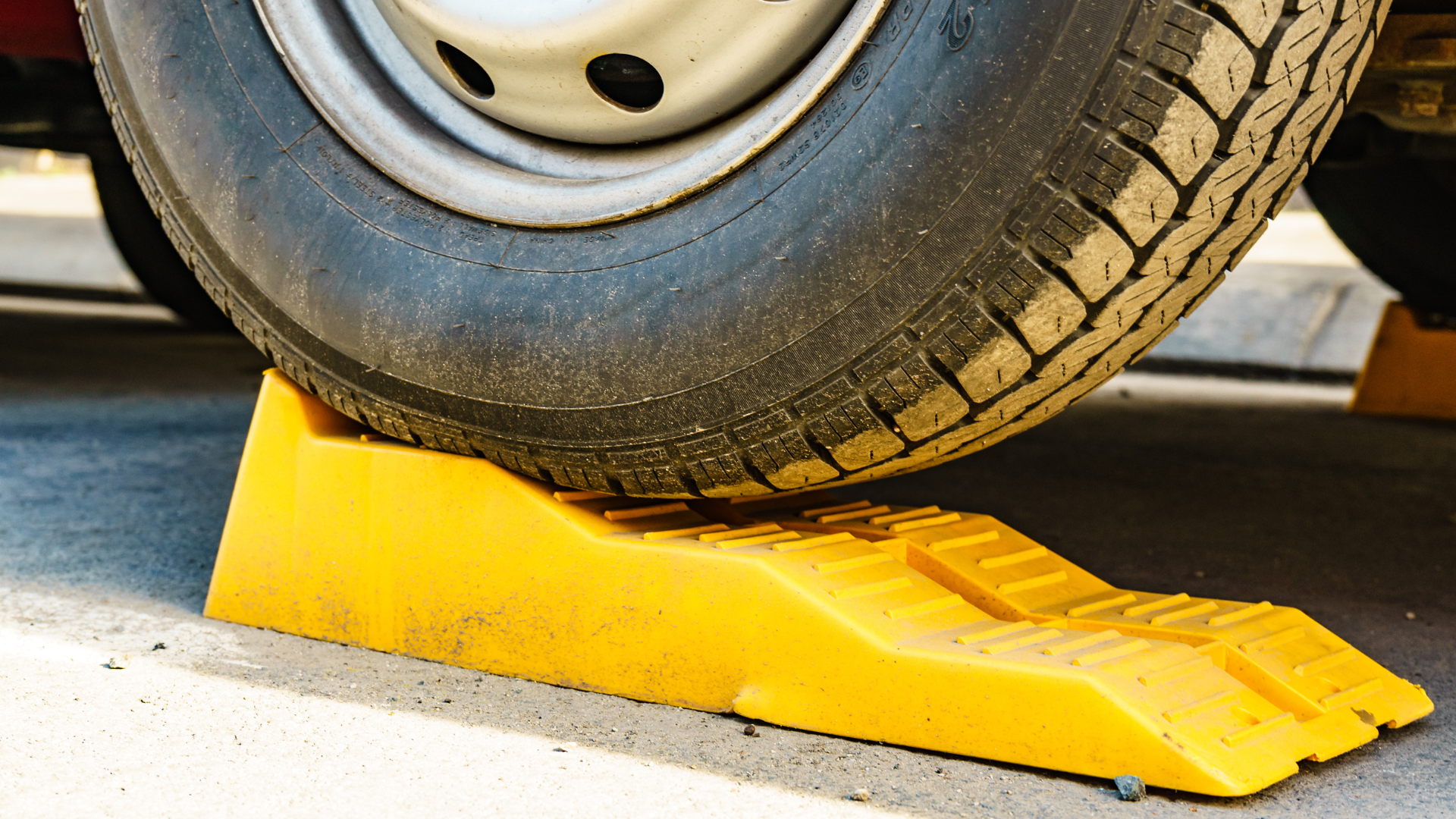
Leveling blocks are an essential part of setting up a travel trailer. Without them, your trailer will be uneven and potentially unstable. Leveling blocks help to level out the trailer by creating a firm, level surface for the wheels to rest on.
They also help absorb any shock from bumps in the road, protecting your trailer from damage. When using leveling blocks, it is essential to ensure they are placed correctly under each wheel. This will ensure that your trailer is level and stable.
Related >> How Tall is a Travel Trailer? (And Why You Need to Know)
Is It Necessary To Use Leveling Blocks?
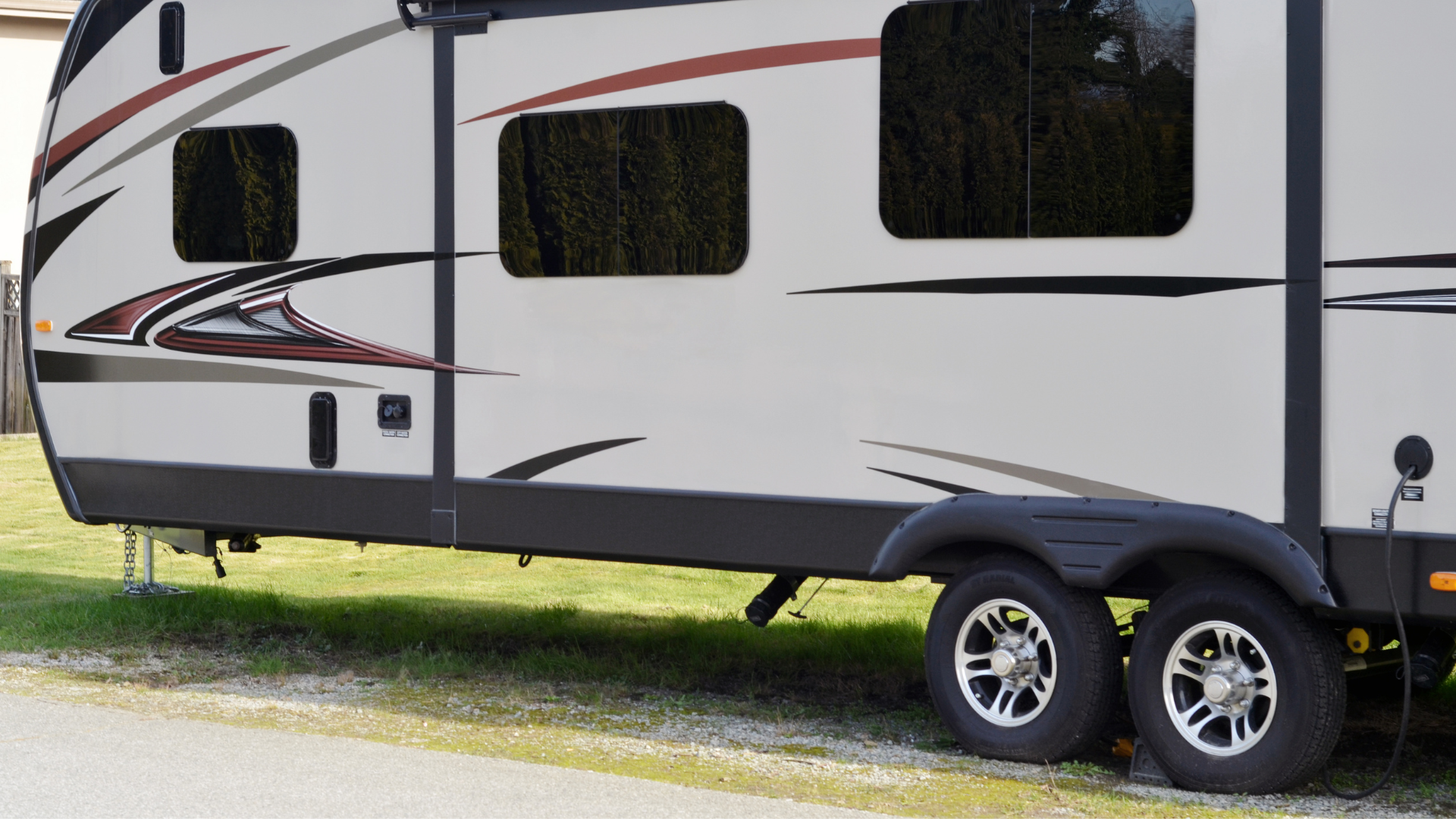
When people think about RVing, they often imagine traveling across the country in a luxurious motorhome. However, not everyone who owns an RV lives this dream. For many people, RVing is a more practical way to enjoy the outdoors.
These individuals often use their RVs for weekend camping trips or short vacations. One of the challenges of RVing is finding level ground on which to park. This is where RV leveling blocks come in handy.
RV leveling blocks are small pieces of plastic or wood used to level an RV when parked. They are placed under the wheels, and once the RV is level, the blocks can be removed.
Many people find that leveling blocks is essential for enjoying their RV experience. Without them, it would be difficult to find level ground to park, and the RV would rock back and forth, making it uncomfortable to sleep inside.
Related >> Top 10 Best Toilets for RVs (2022 Review)
Factors To Consider Before Buying Camper Leveling Blocks
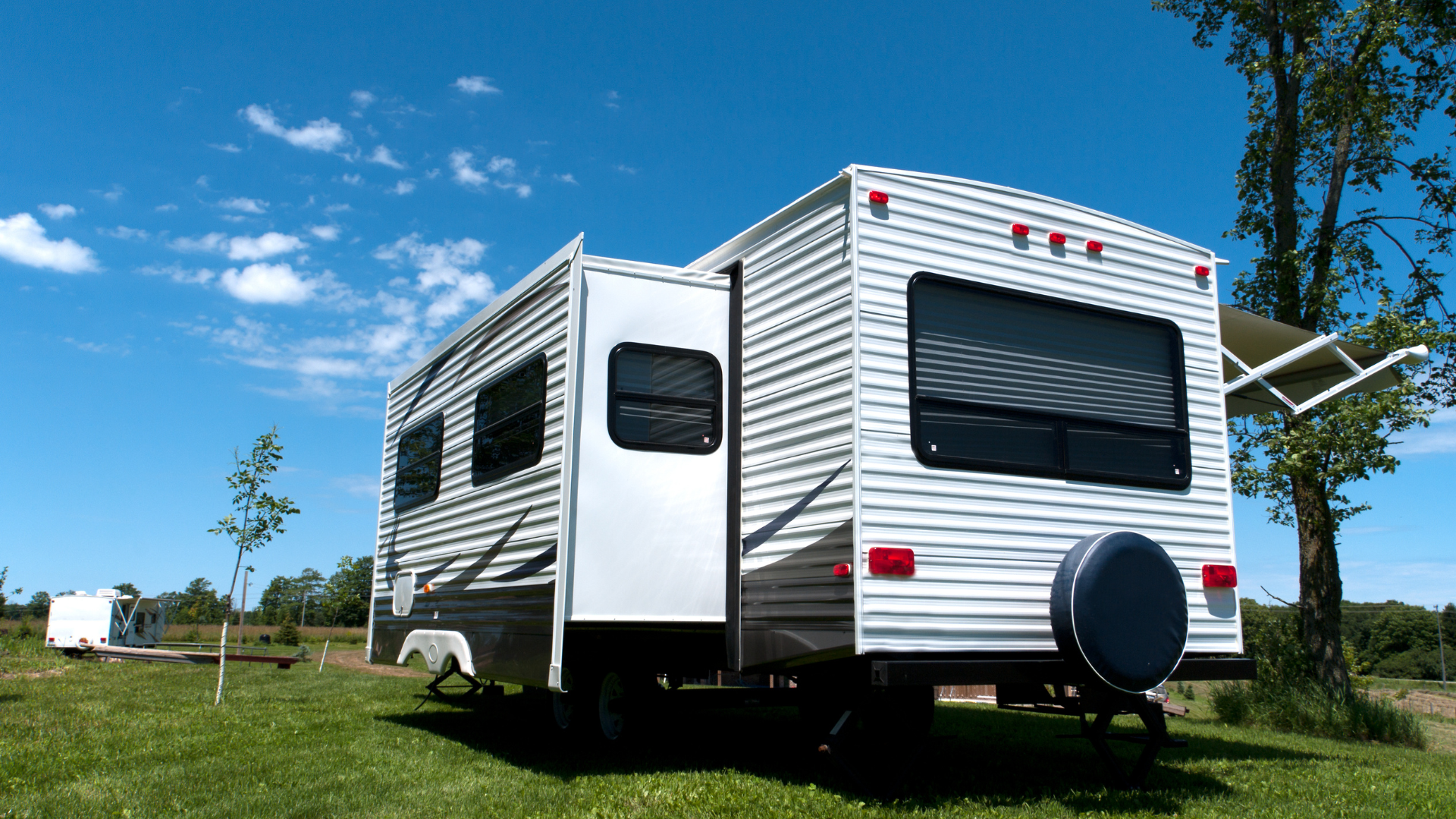
When it comes to camper leveling blocks, durability is essential. After all, you don’t want your blocks to crack or crumble after just a few uses. Many campers choose to go with blocks made from hardened polypropylene.
This material is designed to withstand heavy weights and repeated impacts, making it an ideal choice for leveling blocks. In addition, polypropylene blocks are also resistant to UV damage , so they won’t fade or become brittle over time.
Plus, they’re easy to clean and won’t absorb water or dirt so you can use them repeatedly without any worries. It’s no wonder that polypropylene camper leveling blocks are such a popular choice among campers.
If you live in an area with extreme weather conditions, it’s essential to have somewhere to store your blocks so that they don’t get damaged. Or, if you have a lot of other landscaping materials, it can be helpful to have a designated space for your leveling blocks so that you can easily find them when you need them. A good storage system will help keep your leveling blocks in good condition for longer, making them more effective at doing their job.
Weight & Size
The lighter the blocks, the easier they will be to transport and set up. However, lighter blocks may not be as effective at stabilizing your RV. Heavier blocks will provide more stability but can be challenging to move around.
So, it’s essential to find a balance that works for you. Choosing large blocks to support your RV’s weight is essential in terms of size. If the blocks are too small, they may not provide adequate support and could cause your RV to tip over.
How High Should You Stack Your RV Leveling Blocks
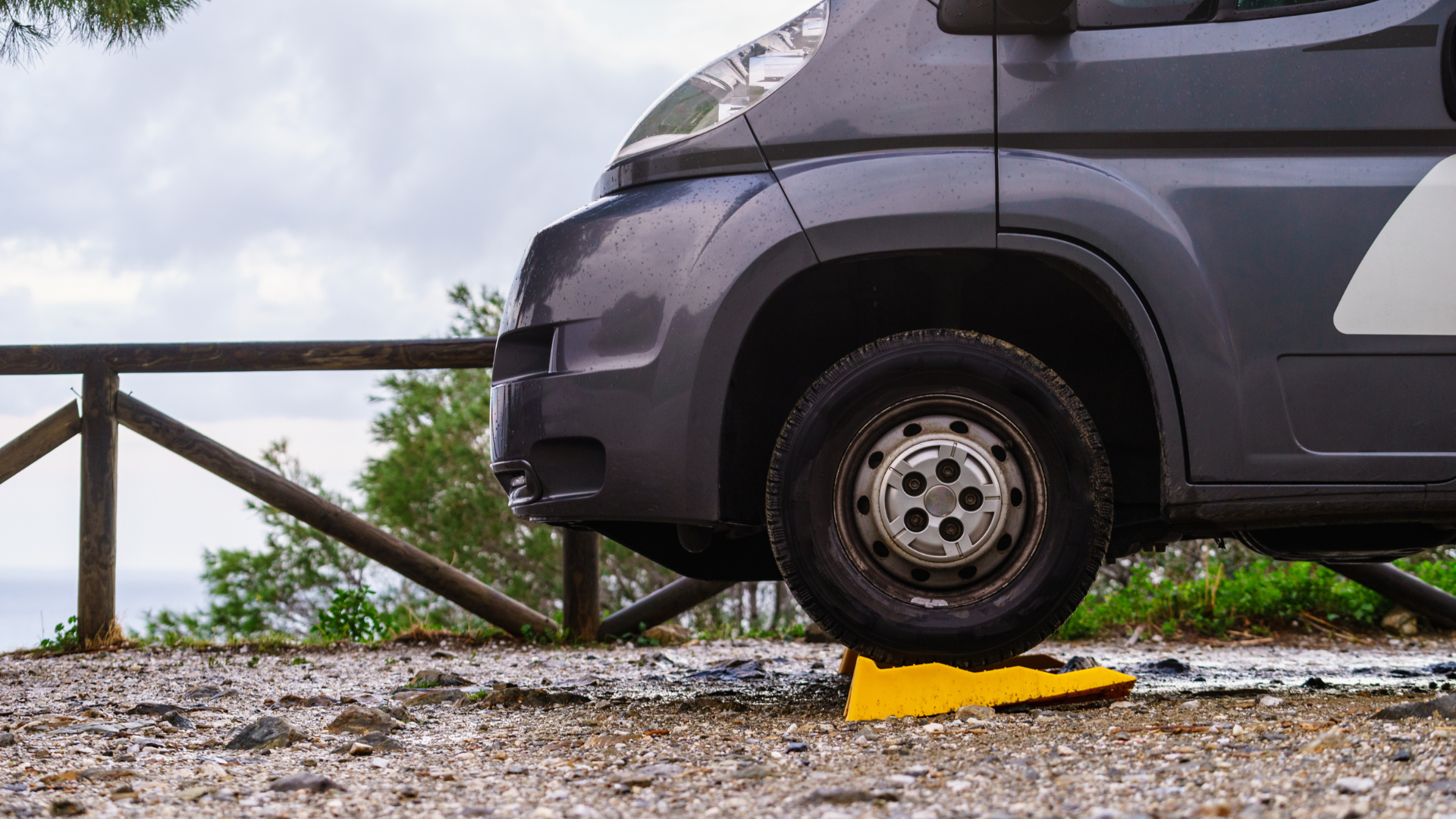
The answer depends on a few factors, including the type of block you are using and the weight of your RV.
Most stacking blocks are designed to support up to 12,000 pounds, so if your RV is within that weight range, you should be able to stack the blocks as high as you need to level your rig.
However, it is always important to check with the manufacturer of your particular leveling blocks to ensure that they can handle the weight of your RV.
Related >> Best Wheel Chocks For Travel Trailer
Wrapping Up
Leveling blocks are an essential part of owning a travel trailer. Not only do they help to keep your trailer level, but they also provide stability and prevent your trailer from shifting when you are driving.
There are various brands and types of leveling blocks on the market, so it is essential to research to find the best option for your needs. With a little time and effort, you can easily find the perfect set of leveling blocks to keep your travel trailer level and safe on the road.

Leave a Comment Cancel reply
Recently published guides.
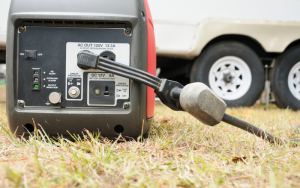
Buying a Generator for RV Life

RV Refrigerators: How Do They Work?

How to Repair Norcold Fridge Flap

RV Zone is reader-supported. When you buy through links on our site, we may earn an affiliate commission. Learn more
The Best RV Leveling Blocks to Correct Level Camping Vehicle

Writen by Tom Hank

Fact checked by Joseph Varney
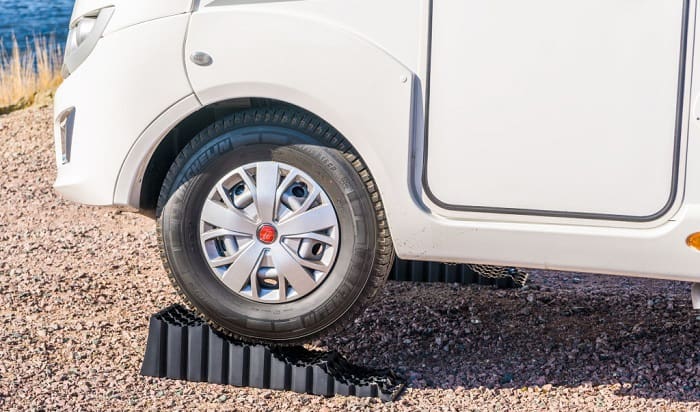
Have you tried parking your RV on soft ground or uneven terrain? If so, you should know the difficulty of parking your camping vehicle in these rough locations. First, ensure your RV, camper, or motorhome has the ideal level using the best RV leveling blocks.
Now, you might be wondering about many questions: Which leveling blocks to use? Should you opt for RV levelers for dual wheels? Should you buy an Anderson leveling system or a set of Lynx leveling blocks?
You can make your purchasing decision easier than usual by thinking about certain factors. Some of the elements you need to think about are:
- Type: RV leveling blocks often come in different types, including interlocking blocks, ramps, electric units, and inflatable models. Each kind of leveling block will have its unique pros and cons.
- Load-bearing capacity: Only use leveling blocks for campers , motorhomes, and travel trailers that can handle the vehicle’s weight. Avoid using flimsy models, which would otherwise cause your camping vehicle to maintain misalignment.
- Durability: The RV leveling blocks you choose should also withstand different dangers along with the maximum load-bearing capacity. For instance, plastic models can resist fading, while rubber options are often resistant to weather damage.
Additionally, you should also consider the prices of your preferred product. For example, you might find it interesting to purchase an electric leveling system for your RV. However, the costs for electric models are often significantly higher than plastic or rubber variants. Keep track of your spending allowance to avoid unwanted expenses.
After thinking about some of the factors, it is time to look at some of the best leveler blocks the market offers.
Table of Contents
11 Top-rated RV Leveling Block Reviews
1. tri-lynx 00015 lynx levelers.
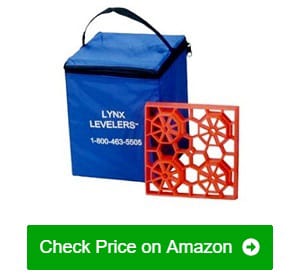
I heard many great things about the Tri-Lynx leveling blocks and decided to give it a try. However, my skepticism led to astonishment as these RV leveling blocks exceeded my expectations.
My first test with these interlocking blocks was with a 25-foot Class C camper, and the site for the vehicle had a downward slope. I knew it was a stretch since the site needed ten blocks for a proper level. But these blocks leveled the Class C RV like flat ground.
Plus, the traction on these blocks is top-notch. Unfortunately, the slope where Class C was on was a bit slippery. Yet, the blocks stayed firm, which prevented the vehicle from sliding to a nearby lake. These levelers can hold up to 40,000 lbs of weight.
The convenience is also beyond many of the leveling blocks I experienced. These units interlock with ease, and they did not require more than a few moments of my time to assemble. The package also comes with a convenient nylon bag for easy storage.
- Provides an optimal level to vehicles on sloped surfaces
- Excellent traction prevents sliding on slippery terrain
- Can carry up to 40,000 lbs of vehicle weight
- Blocks interlock and secure with ease
- Package comes with an easy-to-use storage bag
- May deform if placed on rocky terrain
2. Camco 44510 Heavy Duty Leveling Blocks
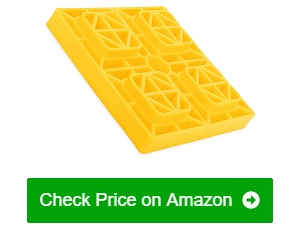
Like Tri-Lynx, Camco is a brand known by many RV campers throughout the years. I bought these Camco leveling blocks, expecting that they offer excellent features.
Campers will appreciate the compatibility presented by these Camco leveling blocks. These units work with different accessories for camping vehicles, including tongue jacks, stabilizer jacks, hydraulic jacks, and other RV stabilizer blocks.
These Camco RV leveling pieces are also reasonably easy to use. The kit only took a few minutes to assemble, plus extra moments to drive my vehicle over them. Besides, these blocks are in bright yellow, making them visible in the dark. With these features, nighttime leveling for my RV is now easier than before.
Another benefit that I experienced from these Camco leveling blocks is that they hold my RV well. With them, parking my vehicle on a reasonably soft and wet surface is not a hassle. These interlocking levelers still held fairly well when placed on that reasonably unstable terrain.
The package also comes with a zippered storage bag. Plus, this carrying case has a convenient handle, making the set ideal for RVers frequently on the go.
- Compatible with tongue jacks, stabilizer jacks, hydraulic jacks, and other RV tools
- Bright color for fairly easy use in the day and night
- Holds RVs well when used over soft and wet terrain
- Package comes with a zipper carrying case
- The blocks might slip on pavement
3. Andersen 3604 Levelers for RV
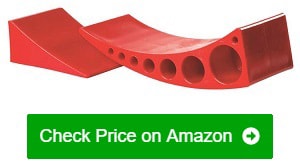
These motorhome leveling ramps are an excellent pick for campers who prefer quick-to-install pieces. We can rely on these leveling blocks for a stable hold when we park our RV.
First of all, setting up for these ramps is possible in only three steps. The first step is to push the skinny end of the leveler into the tire. Then, I drove onto the levelers (with the help of an assistant to tell me when to hit the brakes). Finally, I used a chock to secure everything in place. The entire installation only took me about 5 minutes to complete.
Additionally, I like that these levelers work with relatively any RV. Such a versatile use benefits numerous campers with different-sized RVs. Still, I like that these models are resistant to corrosion and mildew to ensure long-term uses.
But I would like to mention that these ramps have a 30,000-pound weight rating. Therefore, adding more weight than necessary might endanger the products and the vehicle’s alignment. Besides,
The brand also added a limited lifetime warranty for these RV levelers. With this extra feature, I can contact the company’s customer service if I encounter certain issues with this product.
- Installation only takes about 5 minutes to complete
- Compatible with many RVs, provided that the vehicles are about 30,000 pounds
- Included limited lifetime warranty
- Resistant to corrosion and mildew for long-term use
- Not ideal for parking in areas with too thick sand
4. Beech Lane BL-115-SIZE Camper Leveler
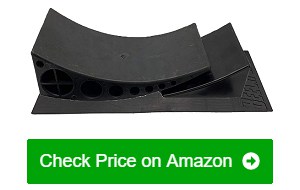
I was looking for dual wheel leveling blocks and came across this Beech Lane camper leveler. After reading some positive reviews about this leveler for campers, I decided to purchase it.
One of the things that I like about this model is its flexibility. The package comes with two leveling ramp kits, making it suitable for use for either single- or dual-wheeled RVs. These RV leveling blocks for dual wheels can even be cut to fill gaps between the tires of certain camping vehicles.
The nylon polymer construction is also quite solid. It even feels tougher than many low-quality counterparts that I tried using in the past, particularly those made out of high-density polyethylene (HDPE) plastic.
The brand is confident about manufacturing quality, as they apply a lifetime warranty for these products, including levelers and chocks. The notable thing is, this warranty works even when the leveler is already customized.
I also found that the material can hold up to 30,000 pounds of weight. The blocks are slightly heavier than others. Still, these models are not significantly heavy to require assistance for carrying them on and off the parking site.
Installation and fine-tuning with this camper leveler is also a reasonably straightforward affair. It only took about 5 minutes to complete the setup. The removal also took roughly the same amount of time to complete.
- Flexible usage allows use for single- and dual-wheeled RVs
- Nylon polymer construction is reasonably tough
- Can hold up to about 30,000 pounds of weight
- Only takes about 5 minutes to install and remove
- Offers lifetime warranty for levelers, even when being cut
- Slightly heavier than other competing products
- Does not come with a storage bag
5. Camco 21023 FasTen RV Leveling Block
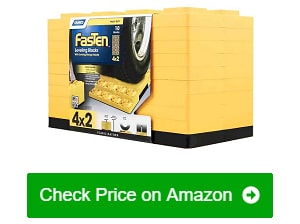
My experience with the Camco FasTen leveling block provided me with both contentment and excitement. Its plethora of practical features releases the happy camper within me.
The first likable feature to mention is the number of leveling blocks included in the package. While many options on the market only supply RVers with two or four blocks, this kit has ten levelers in a single pack. In turn, buying one pack is a more economical purchase than many other choices on the market.
Moreover, the pack also comes with a fairly distinct way of storage. Storing these blocks means stacking them on top of the included base. The base also has a handle, promoting a convenient way to transport the ten leveling blocks to and from the parking site.
Many will appreciate the compatibility provided by these units. For example, people can use these blocks on different RV tools, like tandem axles and RV stabilizer jacks . Plus, these units are usable on both single- and tandem-wheeled camping vehicles.
I also found that the ruggedness of these blocks exceeds many of its competitors, especially when compared to low-quality choices. In addition, the strong and durable build quality is resistant to the elements, particularly from the sun’s harsh UV rays.
- Economical purchase, thanks to the ten levelers included in one package
- Distinct storage process to put the blocks away easily
- Compatible with other tools, such as tandem axles and other stabilizers
- Usable for single- and double-wheeled RVs
- Durable UV-resistant construction
- Might not be ideal for use on rough terrain
6. OxGord ACLR-02 RV Leveling Ramps
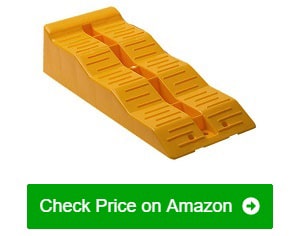
Many search the market for a leveling ramp that does not require extra assembly procedures like interlocking blocks. In that case, these OxGord levelers are ideal for purchase. At first glance, I knew that the products’ designs could help improve the level of my RV.
The ramps have notched ridges for reasonably easy adjustments during camper leveling operations. But it also gave me the freedom to raise or lower my RV in three fairly large increments. With these design choices, I was able to find out that these ramps are usable on different surfaces.
Using the ramps on pavements and uneven terrains did not give me a difficult time. Unfortunately, I could not record the time it took to level my RV with these blocks. But the time it took to complete the leveling job only took about a few moments.
Next, I also like that each ramp in the kit only weighs about 4 pounds. In comparison, some RV levelers, regardless of their shapes and sizes, would weigh more than 10 pounds. Therefore, carrying these ramps to and from the parking site did not require me to pull more muscle than necessary.
- Notched ridges on the ramp provide excellent fine-tuning for RV leveling jobs
- Usable on pavements and uneven terrains
- Lightweight 4-pound construction
- Sufficiently durable plastic material can hold up to 11,000 pounds
- Some leveling ramps might do better in carrying heavier loads
7. CARMTEK Camper Leveler Kit
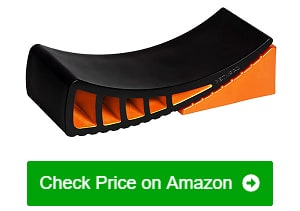
Precision is the name of the game with this camper leveling kit. Using this product for a short period almost immediately made it into one of my favorites.
The first feature that I adored is its jointing system. Its curved design has a plastic construction and comes in two parts. But one component has a rubber shell, enhancing its anti-slip features. As a result, the leveler did not slip on different surfaces, and my camper stayed in place.
Next, I found the maximum weight capacity is comparably higher than many of this product’s competitors. This unit can hold up to 35,000 pounds, and it is compatible with tires up to 32 inches. Plus, it is possible to trim the leveler block if it is longer than required for your specific setup.
Using this model is also reasonably easy. In detail, I was able to level my RV in ½- to 4-inch increments in approximately 5 minutes. Also, once my vehicle was in place, it did not require me to do any additional fine-tuning because the tire stayed in place.
- Unique jointing system for curved levelers provides top-notch anti-slip features
- Maximum 35,000-pound load-bearing capacity is higher than many levelers
- Ends can be trimmed to suit specific leveling demands
- Fairly easy installation process that should not last more than 5 minutes
- Expensive kit might not be suitable for rig owners following strict budgets

8. Camco RV Curved Leveler
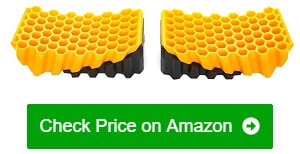
I find it uncommon to see a leveler with a honeycomb design. Yet, I found this particular Camco model enticing.
Upon my first-hand experience, this honeycomb look is not only for aesthetics. It serves to provide optimal traction for compatible RVs. Once I backed my vehicle into this RV leveling device, my camper stayed in place.
The honeycomb design also enhances another benefit: durability. With this design choice, it would seem that the manufacturer was able to conjure up a look that can help disperse weight across the product. Some levelers, especially the low-quality options, often concentrate the load of the carried vehicle to one spot, causing fragility.
I also liked that the levelers in the pack come with non-slip rubber grippers. With these accessories, the entire setup was immovable most of the time.
However, I did experience some degree of movement when I parked in a slippery site. It was not a dire issue since I could solve it by adding extra support to the leveler and chock.
- Honeycomb design helps improve traction for compatible RVs
- Appearance also helps disperse weight across the material, increasing durability
- Non-slip rubber grippers help prevent unnecessary slippage
- Compact design makes it possible to install in both single- and dual-wheel RVs
- The product may still slide when used over a slippery surface
9. BAL RV Products 28050 Light Trailer Leveler
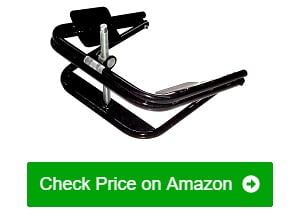
Before anything else, take note that this leveler should only be used for a light travel trailer, pop-up campers, and relatively small RVs. Although this leveling device cannot handle heavy camping vehicles, it makes up for this one caveat with many appealing features.
Many campers like the unique and compact design of this product. Yet, despite the distinct look, I found it reasonably easy to install. The device can slip around the wheel of a compatible RV tire (which caters to 13- to 15-inch models).
Additionally, the convenience supplied was outstanding since I could fine-tune the alignment by turning the screw with a wrench. This extra tool is also in the package, which means that you do not have to rush to the store if you lack a wrench in your toolbox.
Also, the design makes it possible to eliminate the need of pulling or backing into a block or ramp-style levelers. The entire assembly only took a few minutes of my time. Moreover, an assistant may not be a requirement in leveling an RV with this leveler.
The metal build is also corrosion-resistant. In turn, I can expect to use this travel trailer leveler for many years.
- Fairly easy install process, thanks to the unique design
- Can slip around the wheel of a compatible RV tire of 13- to 15 inches
- Wrench is included in the package
- Top-notch convenience eliminates the need to back an RV into the leveler
- Corrosion-resistant construction
- More expensive than most conventional models
10. Valterra A10-0918 Stackers RV Leveling Pads

Perhaps if there was one word to describe these Valterra leveling pads, it would be ‘reliable.’ These leveling pads are of good quality and nice design, allowing campers to enjoy stability when parking their RVs.
First of all, each block features a handle. Although this design choice seems quite simple, it is an ingenious addition to the entire setup. With a handle in each pad, it is easier to place and remove the leveler to and from different RV parking setups.
Another characteristic that benefits many rig owners is its versatility. In detail, these leveling pads are compatible with many other RV support products. We can use these pads on things like a jack stand and tongue wheel without them giving me significant trouble.
Plus, the pads can bear weights of up to 40,000 lbs. Therefore, one block can carry a maximum of 10,000 pounds, which is more than enough to lift one RV wheel.
The grooves also help enhance leveling while improving accuracy during installation and stability from use. It is also surprising to see that this superb strength comes from a reasonably lightweight package.
- A handle on each pad, promoting convenient installation and removal
- Versatile usage since the pads are compatible with tongue wheels
- Great maximum load-bearing capacity of 40,000 lbs
- Fairly lightweight construction
- Takes some effort to remove dirt and mud
11. Yosager CLD Camper Levelers

Although many manufacturers vie for cramming the most features out of their camper levelers, Yosager was able to keep things simple with this product.
Its straightforward appearance may not have the bells and whistles found in more expensive models. However, it can still outdo many of its competitors with such a simple yet functional design.
These leveling stacks can bear the heavyweight of different RVs. I should mention that I did not find information about the maximum load-bearing capacity of these levelers. However, I yielded pleasing results with these models from my tests with compatible small- to medium-sized RVs.
These levelers also performed well when placed in different parking sites. It even prevented my RV from sinking when I parked the vehicle on soft ground.
I am also quite amazed by these models’ ability to work with other RV support devices. Each leveling pad did not give me problems when used with other accessories, including stabilizer, tongue, and hydraulic jacks.
Last but not least is the top-notch user-friendliness provided by these blocks. Installation was almost effortless since it did not require me an entire afternoon to complete the setup.
- Can carry small- to medium-sized RVs
- Prevents tires from sinking into soft ground
- Compatible with other devices like different RV stabilizers
- User-friendly operations, thanks to the convenient structure
- An affordable piece with functional and straightforward design
- Might crack or break when used on rough terrain
RV Leveling Blocks Buying Guide
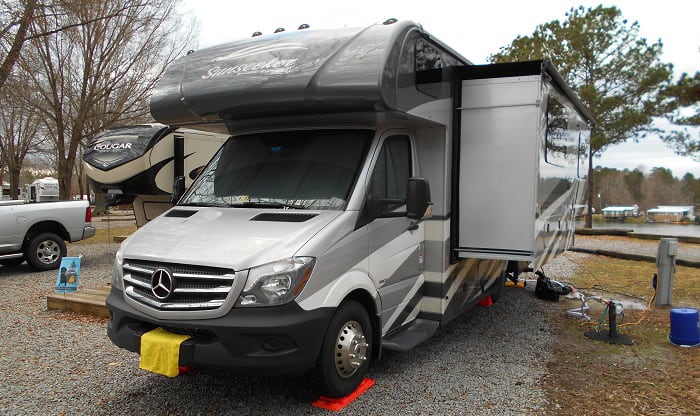
Although the RV leveling block reviews mentioned above provided you with great options, you still need to purchase the right model to meet specific requirements. While you are still at the buying stage, considering the following factors ensures that you gain the most value from your purchase.
Leveling blocks for motorhome generally come in different shapes and sizes. But you can classify these motorhome leveling blocks into main categories, which are:
- Interlocking blocks: Touted as the most basic type, interlocking leveling blocks often appear as square plastic tiles. These models are akin to the reasonably famous Lego toys, albeit they are built for providing RVs with a proper alignment.
- Ramp levelers: As the name implies, RV leveling ramps have a slope that usually allows better fine-tuning than their interlocking counterparts. Additionally, ramp models are often quite convenient to install.
- Inflatable levelers: Inflatable RV levelers are generally small, flat airbags upon taking them out of their packages. Then, you need to inflate them (hence the name) to help provide the correct level to your camping vehicle. But inflatable models often have less flexibility than other types.
- Electric levelers: Electric RV leveling blocks for motorhome arguably provide the best in convenience out of all the RV types. But these models often carry price tags that go beyond thousands of dollars, making them unideal for RV owners on a tight budget.
Maximum Load-Bearing Capacity
You should always consider using heavy-duty RV leveling blocks that can carry the weight of your camping vehicle. Thankfully, many manufacturers of reliable leveling blocks are not shy about disclosing their products’ maximum load-bearing capacities.
Still, herein lies the tricky part of determining how much weight you need when buying RV leveling systems. Here is a shortlist of the different types of RVs and their average weight ranges to help you in your search:
- Class A: 13,000 to 30,000 pounds
- Class B: 4,000 to 9,000 pounds
- Class C: 10,000 to 13,000 pounds
- Travel trailer: 1,100 to 12,000 pounds
- 5th wheel: 7,000 to 20,000 pounds
One of the most important RV leveling block features that you should pay attention to is the build quality. Take note that the RV leveling pads or ramps you use will bear the entire weight of your vehicle and not only its tires. So if you use an RV leveler with a poorly built construction, you will run into consequences like your camper misaligning suddenly.
Here is a quick comparison between the different materials used in manufacturing RV utility blocks:
- Wood: RV blocks made of wood are usually homemade models. Variants made from this material are often ideal for temporary scenarios rather than permanent parking setups because some types of wood often deteriorate faster than plastic or rubber.
- Plastic: Many if not most leveling blocks you can see on today’s market have plastic constructions. Additionally, many plastic options have weather-resistant properties. Some models even have high resistance against UV, allowing them to maintain their colors for extended periods.
- Rubber: Rubber leveling blocks usually have better protection against the elements than wood or plastic models. Certain options are even made from recycled materials for environment-conscious RVers. However, some options may have a strong smell, which can make installation and use tougher than intended.
Convenience
Perhaps the last thing you would want to experience from using a camper leveler is spending an entire afternoon or day trying to use the product properly.
Some RV campers may find interlocking levelers to be more convenient than using ramps. But if you have the extra cash, you may want to buy an electric RV leveling unit for optimal ease of use.
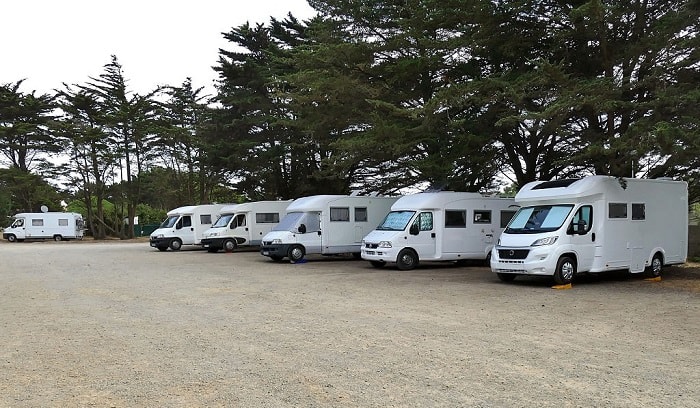
Are RV Leveling Blocks Necessary?
Many RVers swear by using an RV leveling kit whenever and wherever they are needed. The overall camping experience can shift towards the positive end by using the best RV levelers the market can offer.
Although you can still use DIY leveling blocks for RVs, getting the alignment or balance you want from these homemade models can be tough. So instead, you should consider taking the time to browse the market for one of the best RV leveling block sets you can own.
Many modern RV leveling blocks will help provide optimal levels to compatible camping vehicles, and these tools also aid in stabilizing the vehicles. Opt for using a leveler block kit for motorhomes and travel trailers with excellent durability and steadiness. If you pair these tools with RV stabilizer jacks, walking in your camping vehicle might be a similar experience to strolling on the ground.
What Is The Best Way To Level An RV?
The best way to level an RV often depends on the type of vehicle you possess. Leveling a motorhome, Class B, or Class C camper might not have the same process as aligning a travel trailer.
In this section, you can find the differences and similarities between these leveling methods in greater detail:
Leveling a Motorhome, Class B, or Class C RV
- Find a reasonably flat location to park the vehicle temporarily. If you are parking your camping vehicle on uneven ground, make sure that it will not significantly tilt your RV or motorhome.
- Use your preferred RV level to check how much fine-tuning you need to do.
- Measure the vehicle from front to back and left-to-right.
- If the balance is off at the front-to-back measurement, raise both ends of the RV or motorhome using your preferred camper leveling system.
- If the balance is off from the left-to-right orientation, use wheel chocks with leveling capabilities on the tires at the left and right sides of the vehicle.
- If the balance is off from the left-to-right and front-to-back measurements, install camper leveling blocks where they are necessary.
Leveling a Travel Trailer
- Follow steps 1 through 3 from the step-by-step guide on leveling a motorhome mentioned above.
- Place leveling blocks for travel trailers wherever necessary and slowly pull the camping vehicle onto them.
- Lower the trailer’s stabilizers once you are satisfied with the alignment.
At first, it might look easy to level an RV (regardless of size or type) without requiring assistance from others. However, consider having another individual check the level of your vehicle as you pull it onto a camper leveler. Doing so can help you a significant amount of time and effort from fine-tuning the setup.
How Much Weight Can Leveling Blocks Hold?
Different RV wheel levelers generally use dissimilar materials. In other words, one set of camper leveling blocks may not have the same maximum weight capacity as another camper leveling kit.
Still, many interlocking or stackable levelers for campers can carry an RV weight range of approximately 3,000 to 10,000 pounds. Take note that load-bearing capacity found in many product descriptions usually points to that piece of information for each block.
How High Can You Stack RV Leveling Blocks?
The answer to that question depends on the RV tire levelers you are using. Some camper leveling blocks may only provide height adjustment of up to 8.5 inches. Additionally, these units may supply height alterations in 1.50-inch increments.
On the other hand, you may want to use ramp leveling blocks instead of models that stack. RV levelers with a ramp or slope designs often provide better fine-tuning procedures than many blocks.
However, the maximum allowable height for some camping trailer levelers, particularly those with ramp-like constructions, cannot only go up to four inches. Therefore, make sure to check the product’s description before buying it to avoid the hassle of buying the wrong model.
Moreover, take note of the limitations of certain RV leveler models. For example, an RV leveling blocks Harbor Freight variant may only supply users with up to three stages of stackable height.
How Do You Make RV Blocks Leveling?
You might need RV and trailer blocks in certain scenarios, such as boondocking. However, accessing an RV supply store is not possible currently. If so, here is a quick guide to help you make a DIY RV leveling system.
What You’ll Need
- Measuring tape
- Belt sander or sandpaper
- Screwdriver and screws
- Heavy-duty glue
- Two 8-foot 2 x 10 timber planks
Step-by-Step Guide
- Step 1: Measure the axles of your vehicle from one center to another. Then, measure the distance between the ground and your vehicle’s tires.
- Step 2: Use the saw to cut one of the planks. Make sure that the cut size matches the distance measured between the ground and the tires.
- Step 3: Sand a bevel to both ends of the wooden plank.
- Step 4: Repeat steps 2 and 3 for the other plank. But this time, only make a bevel on one end.
- Step 5: Find and mark the center of both planks.
- Step 6: Place the single-bevel plank on the longer board. Make sure to align the straight edges.
- Step 7: Measure the distance from the center of both wooden planks and mark it.
- Step 8: Align the short piece to the long board while following the marked path.
- Step 9: Park your RV onto these wooden motorhome levelers to test.
Take note that using these homemade RV leveling blocks may not replace factory-made models. Although homemade leveling blocks can be ideal for boondocking, using your leveling blocks might not be suitable for permanent locations. Many issues can come to mind, such as the inability to fine-tune the leveler with utmost convenience.
If you decide to use a DIY camper leveling system, do not forget to buy reliable commercial models. That way, you can easily adjust your RV’s level without having to build RV leveling pads from scratch.
How Many Leveling Blocks Do You Need?
A general rule of thumb to know the right amount of trailer leveling blocks to use is to know the number of tires on your camping vehicle. The number of blocks used should coincide with your RV’s equipped tires. Therefore, if you are a proud owner of an RV with six wheels, make sure to use six camper wheel levelers.
Additionally, the number of blocks needed might change based on the products’ design. For instance, you might need to use a pair of Anderson leveling blocks because of their curved ramp designs.
Make sure to read the product description, especially if you are buying online. That way, you will have a general idea of the number of leveling blocks you need for your desired setup.
Now that you are at the end of this guide, you should have a better idea of the best RV leveling blocks. Remember, take the time to think about the different vital factors before you finalize your purchasing decision. Make sure to maintain and care for the pieces after using them to lift your heavy RV.

Hi, I am Joseph. Carpe diem! Seize the day! That’s always been my life motto. If you haven’t seen some of the most beautiful places in the country, you are missing out on incredible adventures.
8 Best RV Jack Pads, Blocks and Supports for Stabilization
There are few things as fun as spending a weekend, a week, or a lifetime hitting the open road in your RV and exploring the campgrounds and backwoods of the world. Sad to say though there are few things more annoying than trying to level your RV and watching your jacks sink down into the soft Mississippi soil. Thankfully jack pads are there to help. Today we’re covering the best RV jack pads around to help you find the ones most suited for your needs.
Table of Contents
- 1.1 Camco RV Stabilizing Jack Pads
- 1.2 SnapPad Xtra XL Permanently Attached RV Leveling Jack Pad
- 1.3 Quality Plastics Utility Block
- 1.4 Andersen Hitches Jack Block – Stabilize Your RV
- 1.5 Camco Yellow Stabilizer Jack Support
- 1.6 Road Warrior Guaranteed Unbreakable RV Jack Pads
- 1.7 Andersen Hitches EZ-Block Jack Block for Scissor Jacks
- 1.8 Valterra StayPut Jack Pad
- 2 Compare the Best RV Jack Pads
- 3.2 Weight Load
- 3.3 Ease of Use
- 3.4 Number of Pads
- 3.5 Non-Slip & Stackable
- 3.6 Weight, Size & Storability
- 3.7 Durability
- 4 Top RV Jack Pads Video
- 5 FAQ: Best RV Jack Pads
- 6 Final Thoughts
Best RV Jack Pads

Jack pads are an often overlooked yet essential item for any RVers who consistently use leveling or stabilization jacks. They help keep your jack from sinking into soft ground or being damaged while pressed against hard concrete or asphalt.
While it may seem like there isn’t much to separate different jack pads from one another, you’d be surprised by the subtle differences that can make a big difference on how they work.
Our list includes multiple types and styles of jack pads at a variety of different price points.
Camco RV Stabilizing Jack Pads

Buy from Amazon
The Camco RV Stabilizing Jack Pads are heavy-duty polypropylene jack pads designed to help stop your RV’s jacks from sinking into the ground. They come in a pack of four and are UV stabilized to protect them from the sun’s damaging rays.
They come in a pack of four with a velcro storage strap and nest together into a very compact cube. They’re rated for a maximum load of 6,000 lbs, just about right for your average travel trailer, pop up camper, or class B RV .
They’re compact and very easy to use, but they do have some flaws. First and foremost, they’re clearly designed to be value-priced jack pads. That’s not a bad thing in itself, but it does mean that they aren’t as strong or durable as some other options out there.
Overall the Camco RV Stabilizing Jack Pads are a good choice for lighter travel trailers and RVs, especially if you’re looking to get out there for a bargain price.
SnapPad Xtra XL Permanently Attached RV Leveling Jack Pad

The SnapPad Xtra XL Permanently Attached RV Leveling Jack Pads are heavy duty rubber jack pads for large RVs. They’re designed to be mounted on the end of your RV’s jacks and offer substantial protection against sinkage or damage.
When they said these are heavy duty, they meant it. Each jack pad is 12 inches across and weighs a full five pounds. Once attached they’ll keep your heavy weight RV from shifting, sinking, or moving effectively for the long haul.
Permanently mounted jack pads require a good bit more setup than basic models, but are a lot more convenient once mounted. You can just lower your jacks down to level your RV without having to worry about laying them out at the right angle or orientation.
One thing to keep in mind though is cost. A four pack of the Xtra XL’s are substantially more expensive than other jack pads.
If you’ve got a large RV and don’t want to be bothered pulling out and putting away jack pads, the SnapPad Xtra XL’s are a very viable option.
Quality Plastics Utility Block

The Quality Plastics Utility Block is a combination leveling block and jack pad. It’s basically a heavy duty plastic that’s designed to act as both a jack pad and as portable leveling blocks.
It comes in a pack of four and stacks together for easy storage. The blocks are extremely easy to use for both of its intended purposes and pack up quickly and compactly when you’re ready to leave.
One thing we did notice though was that the long ridge running through the center of the pad seemed like it would reduce its strength. Several RVers who used it over longer periods of time reported that it broke or bent in half along that line. So long as you’re using it for lighter RVs though this shouldn’t be a problem.
One thing that didn’t hit us until we’d put it through its paces is that the core benefit of the Utility Block, it’s multi-purpose nature, wasn’t actually that useful. For most RVers they either use leveling blocks or they use jacks and therefore jack pads. Having both could theoretically come in handy, but isn’t the big feature we initially thought it was. Thankfully the Utility Block works well in both its rolls, so it still gets a place here.
The Quality Plastics Utility Block is a good product with a somewhat curious design ethos. It works well as both a leveling block or a jack pad though, so we won’t question it.
Andersen Hitches Jack Block – Stabilize Your RV

The Andersen Hitches Jack Block is a heavy duty jack pad built for a variety of different vehicle types. At first glance it looks like nothing so much as an upside down red bucket, and it honestly works in much the same way.
It’s designed to work with hitch posts, jacks, and even as a step stool or seat. The circular build gives you a large and stable surface to place your jack on, and integral magnets make it a cinch to properly line it up underneath your jack.
The blocks nest into one another for easy storage and can even be used two high if you need a taller base for your jack. They’re rated at 6,000 lbs each and provide a very stable base that helps reduce movement within your RV.
One of the only real downsides to the Jack Block is having to buy enough of them. They’re sold singly and only provide the most noticeable benefits in groups of four.
If you’re looking to try something new to spice up your RVs stabilization and set up the Andersen Hitches Jack Block isn’t a bad way to do it.
Camco Yellow Stabilizer Jack Support

The Camco Yellow Stabilizer Jack Support is a 7” jack stand specifically designed for use when reaching level isn’t possible with your jack’s basic length. It allows you to extend your jacks and still provides a firm base for your RV.
They’re rated for 5,000 pounds and use a unique three cell design that allows the heavy duty plastic they’re made from to bear a much heavier weight while simplifying setup. Even better, they’re designed to nest into one another for much easier storage.
Best of all, these are priced at a really affordable level for such a capable stabilizer jack pad.
If you’re worried about camping at sites where grade is an issue the Camco Yellow Stabilizer Jack Support offers a reliable boost that helps you get your RV safely leveled out and comfortable.
Road Warrior Guaranteed Unbreakable RV Jack Pads

The Road Warrior Guaranteed Unbreakable RV Jack Pads are the heavyweight option of the jack pad market. They’re built to hold the heaviest RVs in the toughest conditions and are guaranteed to never break.
They’re up to 18” across and extremely thick, thick enough to weigh in at a full 12 pounds for the heaviest model. All that size and weight gives you an incredibly capable and effectively indestructible jack pad that won’t bend, won’t rot, and definitely won’t break.
The counterpoint to this is that they’re heavy, large, and take up a lot of space with a set of four. You’re going to need a pretty substantial dedicated storage space for the Road Warrior’s, something not everyone has available in their RV.
If you want some of the best and heaviest duty RV Jack pads the Road Warrior Guaranteed Unbreakable Jack Pads are them.
Andersen Hitches EZ-Block Jack Block for Scissor Jacks

The Andersen Hitches EZ-Block Jack Block for Scissor Jacks is a heavy duty jack block designed specifically to work with scissor style jacks. They’re rectangular cones rather than circles or bucket shapes, perfect for the rectangular feet of scissor jacks.
Even better, they have a built in post hole to allow you to use them with other styles of jacks if you need to. They’re rated at 2,000 pounds each and designed to nest together for easier storage down the line.
For their intended purpose they work great. Scissor jacks can be a real pain to properly stabilize with regular jack pads and these work perfectly with them to help protect your jack and the road underneath it.
If you’ve got an RV with scissor jacks the Andersen Hitches EZ-Block Jack Blocks are the ideal solution.
Valterra StayPut Jack Pad

The Valterra StayPut Jack Pad is a bright red jack pad designed to keep your jack perfectly in place without slippage or movement. It’s made from a heavy duty plastic and has a ribbed design that allows it to hold more weight than you’d think for something its size.
Each jack pad has a carry handle for easy pickup and storage and packs flat against each other for easier storage. They don’t have much in the way of special features, but they do provide an excellent option if you need basic jack protection and aren’t looking to spend a lot on it.
Overall the Valterra StayPut Jack Pad is a good enough option that won’t break the bank.
Compare the Best RV Jack Pads

Buyer’s Guide to Buying the Best RV Jack Pads
Jack pads only have a few key features you need to consider. The most important are material type, weight capacity, ease of use, and durability.
The bulk of jack pads are priced within a consistent range and quite affordable. You can get pretty good pads for under $20 for a pack of four, with the next level up not much more expensive.
On the higher end of the market, and especially when we’re talking jack pads built for heavy weight RVs, prices can jump up to $40 or more per pad.
Weight Load
By far the most important factor when picking out RV jack pads is their weight load. The best jack pads in the world aren’t going to work for you if they aren’t rated to hold the load of your RV.
Trying to level your RV on inadequate jack pads can lead to damaged jacks and other mishaps you definitely don’t want to deal with while out trying to relax.
Make sure any jack pads you consider offer a comfortable extra margin of load for your RV.
Ease of Use
It may surprise new RVers to learn that there are actually some jack pads that are a pain to use. Most are simple in design and set up, basically just acting as a small pad that your jack can rest on, but some require actual installation when they’re being used for a more precise fit.
Figure out what level of effort you’re willing to put into getting your jacks set up before you by the very best, but difficult to use, RV jack pads.
Number of Pads
One thing that leaves a lot of new RVers scratching their heads in irritation is buying just enough jack pads and accidentally breaking, bending, or otherwise disabling one. Jack pads aren’t technically a consumable product, but we’ve known RVers who use them as such.
Given how compact and easy to store jack pads are we always recommend you pick up several extra so you don’t end up with a naked jack while out boondocking or on softer ground.
Non-Slip & Stackable
A non-slip coating such as a rubberized booth or similar is a really nice feature to have on a jack pad. It makes it less likely it will move out of place or slide across the ground while you’re fitting your RV’s jacks down onto it and generally increase both safety and convenience.
Stackable jack pads are great purely from a storage and convenience standpoint. Space is always at a premium in an RV, having stackable jack pads allows you to store plenty of spares in a very small space.
Weight, Size & Storability
One of the great things about jack pads is that they generally don’t weigh much and don’t take up much space. The nature of their design allows them to use compressive forces and materials to handle large loads without having to be heavy weight themselves.
Because they’re basically just a small pad to go over a few inch wide jack end, they also don’t have to be very large at all. Both of these factors makes it a lot easier to store them in your RV while you’re moving around or to keep extras on hand.
Last but not least, we highly recommend you buy a jack pad that’s at least moderately durable. We’ve joked above about how often you’ll be replacing them, but you should still pick up some that offer better than average protection for your RV’s jacks.
Thicker models made of heavier duty plastic or rubber last longer and give your RV a more secure footing when leveling jacks are deployed.
Top RV Jack Pads Video
FAQ: Best RV Jack Pads
Navigating the world of RV accessories can sometimes be overwhelming, especially when it comes to selecting the right jack pads for your RV. To help answer your queries and provide you with the information you need, we’ve put together this FAQ section on the best RV jack pads.
Whether you’re a seasoned RVer or a newbie, understanding the purpose, selection criteria, and proper usage of jack pads is essential for a smooth and stable camping experience. In this section, we address common questions and concerns related to RV jack pads, providing valuable insights to assist you in making informed decisions.
From clarifying what jack pads are and their importance to guiding you through the selection process, we cover a range of topics to help you find the best jack pads for your RV. We also address whether homemade alternatives are viable, discuss compatibility with different RV models, and provide recommendations for maintenance and usage.
By delving into these frequently asked questions, we aim to equip you with the knowledge necessary to enhance your RV leveling and stabilization setup. So, let’s explore the world of RV jack pads and get ready for a more secure and hassle-free camping experience.
Feel free to browse through the following frequently asked questions to gain a better understanding of RV jack pads and their significance in your RVing journey.
What are RV jack pads?
RV jack pads, also known as stabilizer pads or leveling pads, are specially designed accessories placed under the jacks or stabilizers of an RV to provide stability and support. They distribute the weight of the RV more evenly and prevent sinking or damage to the ground surface.
Why should I use jack pads for my RV?
Using jack pads for your RV offers several benefits. They help prevent your RV’s jacks from sinking into soft surfaces such as mud or gravel, providing stability and ensuring levelness. Jack pads also protect the ground surface from damage caused by the sharp metal feet of the jacks.
How do I choose the right RV jack pads?
When selecting jack pads for your RV, consider the following factors:
- Material: Look for durable materials like high-density polyethylene (HDPE) or heavy-duty rubber.
- Size and shape: Ensure the jack pads are large enough to provide adequate support for your RV’s jacks and stabilizers.
- Weight capacity: Check the weight capacity of the jack pads to ensure they can handle the load of your RV.
- Surface grip: Opt for jack pads with a textured surface or grip to prevent slipping.
Can I use homemade jack pads instead of buying them?
While some RV owners choose to create homemade jack pads, it’s generally recommended to purchase professionally designed ones. Homemade pads may not provide the same level of stability and durability as purpose-built jack pads. Manufacturers design RV jack pads specifically to distribute weight and provide proper support.
Are jack pads universal or RV-specific?
Jack pads come in various sizes and shapes to accommodate different RVs and their jack systems. Some jack pads are more universal and can fit a range of RV models, while others are designed for specific types of jacks or RV brands. Always check the compatibility of the jack pads with your RV’s jacks before making a purchase.
How many jack pads do I need for my RV?
The number of jack pads you need depends on the configuration of your RV’s jacks. Typically, you’ll require at least one jack pad for each jack or stabilizer. For motorhomes with four corner jacks, four jack pads are usually sufficient. However, if you have additional jacks or stabilizers, you may need more pads.
Can I leave my RV jack pads on while driving?
No, it’s not recommended to leave your jack pads on while driving. Jack pads are meant to provide stability and support when your RV is parked and leveled. They may become loose, damaged, or dislodged during transit, potentially causing accidents or damage to your RV.
How do I clean and maintain my RV jack pads?
Cleaning and maintaining your RV jack pads is relatively simple. Rinse them with water and mild soap to remove any dirt or debris. Avoid using harsh chemicals or abrasive cleaners, as they may damage the pads’ surface. Inspect the jack pads regularly for signs of wear or damage, and replace them if necessary.
Remember, always consult your RV’s owner’s manual and follow the manufacturer’s recommendations for proper installation and use of jack pads.
Final Thoughts
When picking out jack pads their weight capacity and durability are the first factors to consider. It doesn’t matter how great a jack pad is if it buckles under the weight of your RV or breaks in half form a two foot drop.
After that it really comes down to where and how you intend to use them. So long as you have a pretty good idea of those factors it’s a cinch to pick out the best RV jack pads for your needs.
About The Author
Karan Riley
Become a Dealer | Contact TLRV

Travel More, Tow Less
Introducing the Rove Lite Series — Travel Lite RV’s All-New Line of Ultra-Lite Travel Trailers
Travel Lite RV is making adventure accessible to all with the revolutionary Rove Lite — an ultra-lite travel trailer towable by nearly every mid-size sedan vehicle!

Check Out Rove Lite's Features

Find a Travel Lite RV Dealer Near You

Start Exploring in Your Rove Lite
Go anywhere, with any vehicle.
- Feel Freedom
- Find Adventure
- Enjoy Comfort
- Experience Relaxation
- Explore Happiness
- Discover Connection
- Create Memories
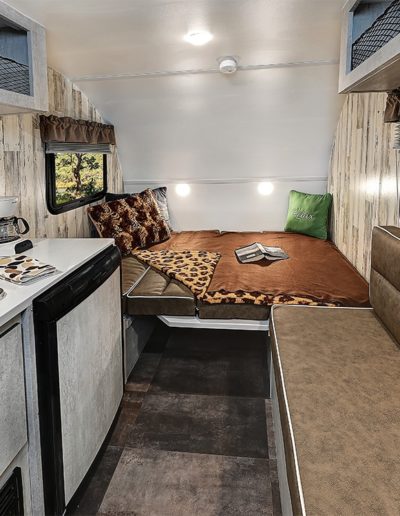
An Impressively Outfitted, Yet Ultra-Lite Travel Trailer
Presenting a sleek European-style build including a composite floor and aluminum chassis, all interior panels are Azdel composite and the seamless poured resin fiberglass roof is one piece from bumper to hitch. Interior features, including a convertible bed and bath with a shower, offer space-saving functionality.
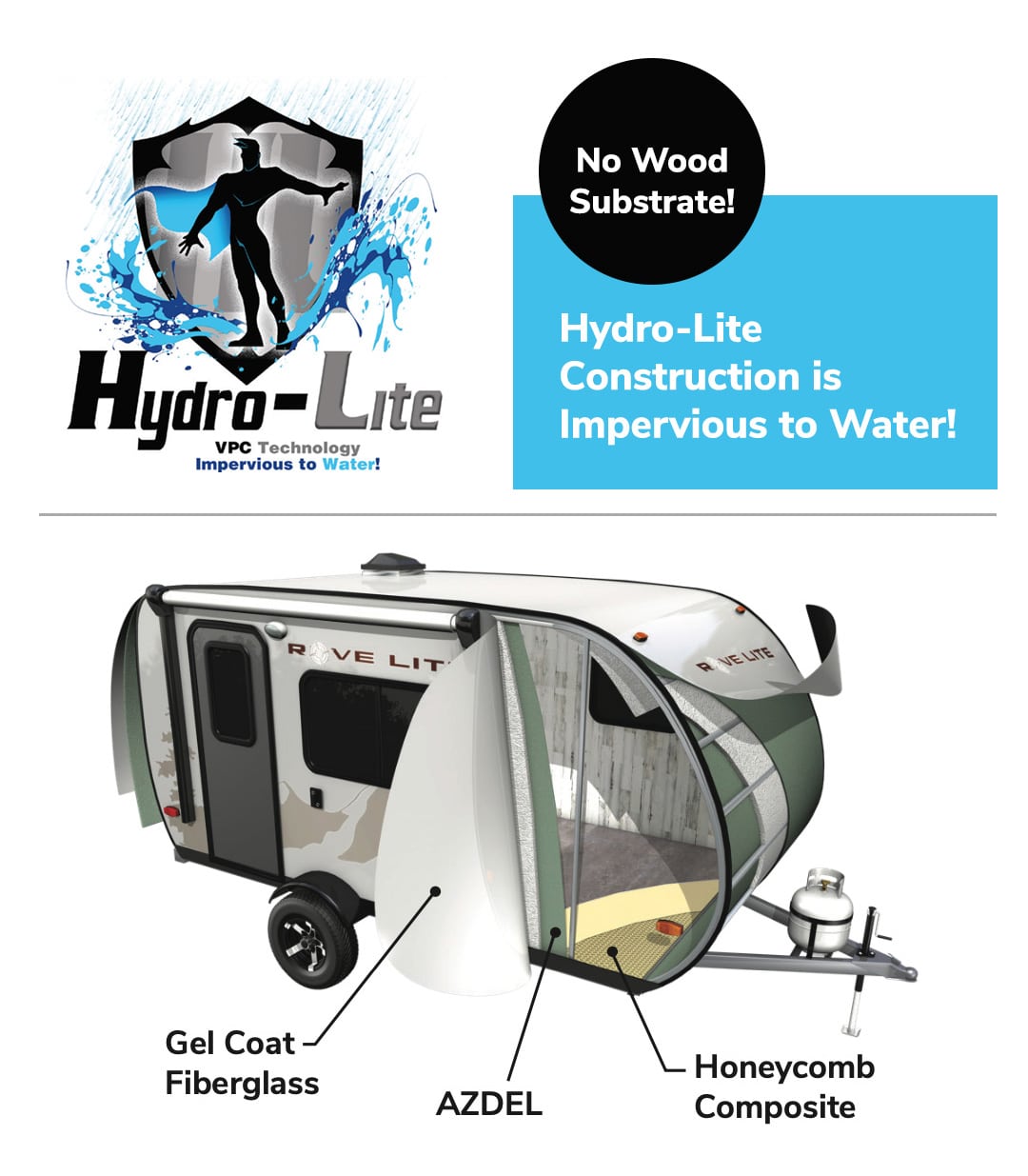
Ultra-Lite on Weight, Heavy on Options
The 16-foot Rove Lite delivers on versatility, with three floorplans towable by vehicles with 2,000# towing capacity.

Travel Lite RV Lightweight Truck Campers & Ultra-Lite Travel Trailers
Travel trailers and truck campers that are beautifully designed yet lightweight and affordable so you can be free to adventure comfortably.
Truck Fitment Use our truck fitment tool to see what floorplans fit your truck
Hidden Data
Front end form data.
- Make _Select Make Chevrolet Ford GMC Honda Jeep Nissan Ram Toyota
- Model Select
- Phone This field is for validation purposes and should be left unchanged.
- Hidden Dealer Email
- Customer Name * Customer First Customer Last
- Customer Phone Number *
- Customers Email Address *
- VIN Number *
- Dealer Repair Order Number *
- Date of Purchase
- How Many Issues Are Submitting * 1 2 3
Warranty Claim Issue 1
- Issue Solution (Proposed) *
- Parts Needed *
- Repair Time *
- Photo of Issue * Max. file size: 1 GB.
- Issue Description *
Warranty Claim Issue 2
Warranty claim issue 3.
- Name * First Last
- Address * Street Address Address Line 2 City State / Province / Region ZIP / Postal Code Afghanistan Albania Algeria American Samoa Andorra Angola Anguilla Antarctica Antigua and Barbuda Argentina Armenia Aruba Australia Austria Azerbaijan Bahamas Bahrain Bangladesh Barbados Belarus Belgium Belize Benin Bermuda Bhutan Bolivia Bonaire, Sint Eustatius and Saba Bosnia and Herzegovina Botswana Bouvet Island Brazil British Indian Ocean Territory Brunei Darussalam Bulgaria Burkina Faso Burundi Cabo Verde Cambodia Cameroon Canada Cayman Islands Central African Republic Chad Chile China Christmas Island Cocos Islands Colombia Comoros Congo Congo, Democratic Republic of the Cook Islands Costa Rica Croatia Cuba Curaçao Cyprus Czechia Côte d'Ivoire Denmark Djibouti Dominica Dominican Republic Ecuador Egypt El Salvador Equatorial Guinea Eritrea Estonia Eswatini Ethiopia Falkland Islands Faroe Islands Fiji Finland France French Guiana French Polynesia French Southern Territories Gabon Gambia Georgia Germany Ghana Gibraltar Greece Greenland Grenada Guadeloupe Guam Guatemala Guernsey Guinea Guinea-Bissau Guyana Haiti Heard Island and McDonald Islands Holy See Honduras Hong Kong Hungary Iceland India Indonesia Iran Iraq Ireland Isle of Man Israel Italy Jamaica Japan Jersey Jordan Kazakhstan Kenya Kiribati Korea, Democratic People's Republic of Korea, Republic of Kuwait Kyrgyzstan Lao People's Democratic Republic Latvia Lebanon Lesotho Liberia Libya Liechtenstein Lithuania Luxembourg Macao Madagascar Malawi Malaysia Maldives Mali Malta Marshall Islands Martinique Mauritania Mauritius Mayotte Mexico Micronesia Moldova Monaco Mongolia Montenegro Montserrat Morocco Mozambique Myanmar Namibia Nauru Nepal Netherlands New Caledonia New Zealand Nicaragua Niger Nigeria Niue Norfolk Island North Macedonia Northern Mariana Islands Norway Oman Pakistan Palau Palestine, State of Panama Papua New Guinea Paraguay Peru Philippines Pitcairn Poland Portugal Puerto Rico Qatar Romania Russian Federation Rwanda Réunion Saint Barthélemy Saint Helena, Ascension and Tristan da Cunha Saint Kitts and Nevis Saint Lucia Saint Martin Saint Pierre and Miquelon Saint Vincent and the Grenadines Samoa San Marino Sao Tome and Principe Saudi Arabia Senegal Serbia Seychelles Sierra Leone Singapore Sint Maarten Slovakia Slovenia Solomon Islands Somalia South Africa South Georgia and the South Sandwich Islands South Sudan Spain Sri Lanka Sudan Suriname Svalbard and Jan Mayen Sweden Switzerland Syria Arab Republic Taiwan Tajikistan Tanzania, the United Republic of Thailand Timor-Leste Togo Tokelau Tonga Trinidad and Tobago Tunisia Turkmenistan Turks and Caicos Islands Tuvalu Türkiye US Minor Outlying Islands Uganda Ukraine United Arab Emirates United Kingdom United States Uruguay Uzbekistan Vanuatu Venezuela Viet Nam Virgin Islands, British Virgin Islands, U.S. Wallis and Futuna Western Sahara Yemen Zambia Zimbabwe Åland Islands Country
- Select Model * Extended Stay Truck Camper Rayzr Truck Camper Super Lite Truck Camper Rove Lite Ultra Lightweight Travel Trailer Other
- Other Model *
- Purchase Date * MM slash DD slash YYYY
- Write In Model Number and Floorplan *
- Hidden Disclaimer: For Dealer Use Only. Please Print & Sign I received a copy of the Travel Lite Limited Warranty before I purchased this camper/trailer and I understand that it is designed to only be used for recreational camping and not full-time or commercial use. I have inspected or have been given the opportunity to inspect this camper/trailer prior to my purchase.
- Hidden Purchaser Name
- Hidden Purchaser Signature
- Hidden Dealer Signature
Just added to your cart
FREE shipping on every order (US only)
OX BLOX Trailer Jack Blocks
The strongest trailer jack blocks on the market.
Durable. Versatile. Stable.
OX BLOX™ Trailer Jack Blocks are perfect for your trailer or 5th wheel pad jacks, post jacks, stabilizer jacks, wheel jacks, scissor jacks, and more. It's stable on a variety of surfaces including gravel, grass, dirt, and pavement.

Customer Reviews for OX BLOX
Ox Blox is a great product for the jack on our 25' airstream. It is MUCH more stable, safer, and faster to use the the many combinations of leveling blocks and wood. It is very stable on mutiple surface types and weather. The top captures the round foot of my jack well so I don't have to worry about it slipping. I highly recommend this product.
Arrived quickly, sturdy, well made
We recently received the Ox Blox Trailer Jack Blocks for our 2006 Newmar Essex Class A diesel pusher, and are thoroughly impressed with their performance. These blocks are an absolute game-changer when it comes to stabilizing our RV and minimizing movement and sway.
The claim that Ox Blox are the strongest jack blocks on the market is no exaggeration. Their unique design provides unparalleled stability and strength, giving us peace of mind knowing that my RV is securely supported. We've tried other jack blocks in the past, but none come close to the durability and reliability of Ox Blox.
One of the standout features of Ox Blox is their versatility. Designed for RVs or trailers with extra-large stabilizer pads up to 13 inches, they are perfect for Class A or Class C RVs. Plus, they fit 9-inch round feet and smaller, making them compatible with a wide range of RV models.
With a weight capacity of 10,000 lbs each, we never have to worry about the Ox Blox buckling under the weight of my RV. Despite their impressive strength, they are surprisingly lightweight and stackable for easy storage and transport.
We also appreciate that Ox Blox are made in the USA of 100% recycled plastic and are UV resistant. This ensures that they are environmentally friendly and built to withstand the elements for years to come. And with a lifetime warranty, we can trust that Ox Blox stands behind their product.
Overall, S&S RV Adventures highly recommend Ox Blox to any RV owner looking for the ultimate solution for stabilizing their vehicle. These jack blocks are a game-changer, providing unmatched stability, durability, and peace of mind on every adventure.
Check out our full video at https://youtu.be/jrYRbujHlbE
These are heavy duty jack blocks! I’m looking forward to using them next month.
We LOVE these things. Granted you need to have the space available to store them and the weight allowance but they are worth the cost. We’ve had them for a couple months now and the pros WAY outweigh the cons. Don’t hesitate to use these!
It collapses down, making it so easy to store. It's also been fun and brought friends together in the RV park.
Excellent RV product! It's so sturdy and durable and definitely helps stablize our rig. It's so much better than what we were using before!
Wish it came in for a double wheel jack
Kids loved it
Haven't been able to play, to cold. Looking forward to warmer weather
Purchased for our horse show trailer, works great and is very sturdy. Highly recommend!
Nice outside game that's small and packs flat.
Kids young and old have had fun with this ring toss game.
Great product!
This game is great and it’s not as easy as you think and a lot of fun
- Choosing a selection results in a full page refresh.
- Press the space key then arrow keys to make a selection.

The Savvy Campers
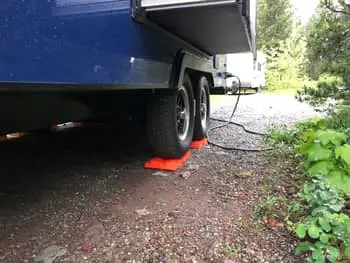
What are the best Travel Trailer Leveling Blocks? 2023 Edition
How to choose the best travel trailer leveling system.
Let’s talk about the two trailer leveling levelers that are the best systems on the market today. Trailer leveling systems are one of the most overlooked items in your trailer arsenal. You may think is just a cheap piece of plastic, but these travel trailer levelers can turn your ordinary tilted camper into a level palace in the middle of the outdoors.
What are the best leveling blocks for a travel trailer?
The two best leveling blocks on the market are the Lynx Levelers (block type) as well as the Andersen Levelers (ramp type). Both have great warranties and they are both very durable and do the job great. For some situations we use the Lynx Levelers and some the Andersen, but they can be used interchangeably.
Choosing the best travel trailer levelers is an important task for the comfort with your travels in your RV. There are two different styles of travel trailer leveling systems that I would recommend; one being Lynx Travel Trailer Levelers which are the bright orange building block type, and the other being the Andersen travel trailer leveling system which are ramps you drive on, then you or your partner chocks up the ramp and in an instant, your rig is leveled. Read more about our recommended levelers. Both types of levelers we recommend are good quality with a good warranty, and you will not go wrong if you buy either one. As we are camping for fun, we enjoy using both types because all items travel trailer are fun for us. Even leveling and black tank items. Ehhh… Maybe not that second one.
Why you need travel trailer levelers?
You may be wondering why you need to spend more money for another contraption for your trailer after you already have all of the accessories including the literal kitchen sink in your rig. You, your family, and your trailer all need a travel trailer leveling system for their own specific reasons.
Your family and yourself need your travel trailer level so you don’t roll out of bed halfway through the night, allowing you to get a good night’s rest. Sitting on that crooked dinette bench with grapes rolling all over to the floor wishing you had spent the extra 5 minutes to level your trailer makes leveling systems an easy sell.
Your trailer or RV needs to be level for several reasons; most importantly for your refrigerator. It will not function properly if it is not level. The slide out needs to be level to function properly and not get uneven on its tracks.
Cooking in a frying pan can be difficult if the oil you use rolls off to one side of the pan making those fried eggs less than perfect. Taking a shower in an unlevel trailer can leave a puddle of water in the shower pan that is unable to drain, this can be an annoyance to anyone if you also use this area for storage while on the road. We can all agree that dry clothes make happy campers. For more detail on how to level your travel trailer, read our article .
Types of Levelers
There are two types of levelers available for your trailer or RV. The first is the ramp type, which is considered an upgrade from the block type, the second is the block type which is the Lego building block style of leveler. Both serve a purpose, personally we carry both types on our travel trailer. We use our ramp type for leveling and our blocks for under our tongue jack and stabilizer jacks.
Sometimes depending on the situation, such as if we are on a hill, we use the block type as I think they are better in that situation. This is a personal preference on what we generally want to use at the time with no science behind it.
The ramp type, also known as the Andersen Leveler , as well as other brands which make the same type such as Camco or Beech Lane are very easy to install. First, arrive at your site. Next insert the levelers under the tires and drive your travel trailer forward until you are level. Then put the chocks under the ramp and you are done. No back and forth or guesswork. These are the quickest type and provide wheel chocking as well as leveling. Ramp type levelers can be used for Travel Trailers, Camper Vans, RV’s, and Truck Campers. If you are using these on big rigs such as a Class A, make sure it has the weight rating to back it up.
The block type are exactly as they are called; building blocks. First, arrive at your site, then guess how much leveling you will need, 1″, 2″, even 3″. Put your blocks under the tire and drive forward. If you guessed wrong, you will need to back up and re estimate your blocks. Leveling blocks are only available in 1″ increments, so to get closer, you will need to either dig a hole under your block, or add dirt or gravel to raise it. This is not hard, it just takes some more time. I am not sure how much you like setting up your trailer, but I like to get things done ASAP to enjoy the camping experience. The sooner I get out of the truck and in my hammock, the better. Block type levelers can be used for Travel Trailers, Camper Vans, RV’s, and Truck Campers. If you are using these on large rigs, make sure they are rated to hold the weight.
The Best Travel Trailer Levelers Reviewed
Andersen travel trailer levelers: the best ramp type travel trailer leveler.
- One time setup
- Also acts as a wheel chock
- Lifetime Warranty
- Ability to get perfectly level
- No Guesswork
- Can be more expensive than alternatives
The Andersen travel trailer levelers are mostly the same concept as the block levelers. The difference being that you will not have to start over if you do not estimate the number of blocks correctly.
To use the ramp type levelers, first, drive to your desired camping spot, park about one foot off of where you want the trailers final resting space will be. Next, place the Anderson levelers in front of the wheels both axles if you have a dual axle, put the level in the trailer or activate your Level Mate Pro, and start driving. Pull forward and either you or your spotter can check the level as you drive up the ramps.
Once you are level, you or your spotter will put the chocks under the ramps you just drove up. You are now chocked and leveled in one step with no second guessing, backing up, or re leveling. The ramp type leveling system also acts as a wheel chock which can save some time. Make sure to chock the opposite wheels for additional security. When parked at a campsite, we also always utilize the X-Chocks for added precaution and to help trailer wobble while you are moving inside.
Lynx Levelers: The Best Block Type Travel Trailer Levelers
- Easy to use
- Cheaper than alternatives
- Can also be used under leveling jacks in soft dirt
- 10 Year Warranty
- Comes with carrying bag
- May take one or two tries to get perfectly level
- Only available in 1″ increments
The building block type is another type of leveling system which we carry in our trailer, and the Lynx is the best on the market today. Travel Trailer Leveling Blocks are relatively easy to use, first pull into your desired location about 1.5 feet from where you want your final resting space to be. Next check for level in your trailer, I use a 4’ level . There are also iPhone apps, the LevelMatePro , and bubble levels that will also work, but my brain prefers the good old-fashioned way as well as I already own a level and do not have to go purchase additional items. Someday soon I will try out these other leveling systems and give you my input.
Next assess how many blocks you will use. Most campgrounds are fairly level so you will find yourself only utilizing one to three blocks high. Stack your blocks either in the front of the tires or the rear depending on your final resting spot.
Tip: it is easier to pull forward over the blocks than go in reverse.
Also, it is easier to see if you are on the block from your rear-view mirror going forward. If you need two blocks, you can put one block down first, then stack two blocks next to it in a building block fashion.
Driveup on your stack of blocks and recheck level. Use your judgment if you need more or less blocks and repeat the process. Doing this a few times will make you an expert at estimating the number of blocks needed to achieve level. Chock both sets of wheels as well as install your X-Chocks if you own them to provide a very stable level travel trailer.
Remember, your leveling jacks are not for fine adjustments, they are for stabilization only. Don’t jack up the whole trailer with them or you can damage your frame or your jacks.
With the blocks being 1” in height, to get very precise, you can either build some dirt/gravel under the blocks, or dig some out if you need 1.5”. Typically, you will not notice being 1” off over 7-8 feet of width of trailer. The block type can also be used under your leveling jacks if you have soft ground to prevent sinking.
I prefer the Lynx over the Camco system as it comes in a handy storage bag, they are warrantied for 10 years, and have a stated weight rating of 40,000 pounds. Camco has a screw lock type storage system, are warrantied for 1 year, and do not state the weight rating. Function wise, the Camco functions just like the Lynx system and is about the same price.
Camco Levelers: A good alternative to the Lynx Block Type
- 1 year warranty
- No stated weight limit
The Camco levelers are basically the same as the Lynx except for being a different color. We like the building block type as they are fairly easy to use and can be installed correctly with one person, or with a spotter as well. The Camco blocks are rated a bit lower in our book than the Lynx as they do not state their weight carrying capacity, as well as only provide a 1 year warranty. Functionally, they do the same thing: level your trailer.
These blocks have been used for many years by RV’ers with little trouble. The warranty really doesn’t concern me because these are a block that really does not have a chance of breaking.
As far as not stating their weight limit, I am sure these will hold most trailers or RV’s just fine, but it is nice to know if they are 20,000 pounds, 30,000 pounds or even more weight capacity.
Homemade 2×6 Levelers
- Will work in 2″ increments as a 2×6 is a hair under 2″ thick
- Can require more guesswork and digging under where you are trying to stay level
- Can be unstable as they do not interlock together
No one said you needed to purchase levelers. You can use 2×6 boards as levelers and be perfectly fine. There are some downsides though. These will have larger increments due to their size being taller than the other type of levelers, as well as if you stack multiple on top of each other, they can be unstable due to them not interlocking together. You can nail them together, but then when you need to switch sizes, you will have to remove the nails.
Other Notable Levelers
There are countless leveling block systems and ramp systems on the market today. Many of these others on this list are similar to the leveling systems we mentioned above, but may be copycat, or appear to not have the same qualities. When looking at these other levelers, they may work in some situations, but may be inferior in other situations. For your application, they may work just fine, but we prefer the recommended levelers above.
Camco RV Curved Leveler With Chock
The Camco Curved RV leveler with chock is very similar to the Andersen levelers, they have a weight capacity of 30,000 pounds which should handle most RV’s and quite all travel trailers out there. From the reviews, there are lots of complaints about these not gripping properly and the chocks shooting out leaving the trailer unchocked. This can create a very dangerous situation for anyone around the trailer as well as parties inside of the trailer. As a good note, always chock BOTH sides of your travel trailer just in case something like this happens and you are parked on a slippery surface. Many ramp levelers are including pads for this slippage situation.
As far as leveling capabilities, they can level your trailer as small as 1/4″ to up to 4″. They do appear to be a bit shorter than the Andersen levelers, which may be better if you have a really short wheelbase.
Beech Lane Camper Leveler
The Beech Lane Camper Leveler looks to be a splitting image of the Andersen unit. These are capable of holding 35,000 pounds and come with two rubber mats to put under the levelers to prevent them from sliding around when trying to level. Reviews seem to be good except for a few reviews where the grip tape attached to the levelers comes unglued and tires slide which is bad news. It is mentioned in their newer units that they do not include grip tape that causes failure with hot tires melting the glue.
The company seems to stand behind their product with a lifetime warranty even if you have to cut the levelers if you have small space between your dual axle wheels. It is good to see companies warranty their items in situations like these. As the price is very similar to the Andersen units, I think they are still a better unit due to having more mainstream usage.
Camco Tri-Leveler
The Camco Tri-leveler is a drive on ramp that escalates in height as you move forward. One flaw I see by looking at these is you are parking on a ramp which offers no way to chock your wheels. I would not trust the chocks on the other side of the trailer to keep your vehicle in place. Also, these are only rated for 3,500 pounds which is very little compared to other units.
I do see these being used for more of a Class C or camper van which you just drive up and park. The emergency brake and transmission can hold the vehicle in place of chocks. Personally, I would rather take that stress off my vehicle and stay away from these ramp type without chocks.
OxGord RV Camper Leveler Ramps
The OxGord RV camper levelers are like the Camco Tri-Leveler as they are a ramp type. The same analysis goes for these, I would stay away unless you have a camper van or Class C that you can drive up and park. Even though the block type take more work, I would prefer being on a level surface than being on a ramp with no chock.
BAL Light Travel Trailer Leveler
This unit is unlike all of the others, the BAL light travel trailer leveler allows you to park in your final resting space, then put the unit around the tire, and ratchet in place. This acts like a leveler as well as a wheel chock. The BAL unit fits 13″, 14″, and most 15″ wheels which are found on many tent travel trailers. This unit is made for single axle small lightweight trailers for chocking and leveling. The size of the unit is 21″x 19″ and 14 pounds, so make sure that you have enough space for storage and can deal with the heavier weight than lightweight levelers or ramp type levelers.
Through our research, we could not find a weight rating on this unit, but on their website, they show a picture of a tent travel trailer as well as a normal travel trailer. If you have a small camper, this could make leveling and chocking a breeze without having to get in or out of your vehicle. If this is your specific application, and you have room for it, then I would say this is a good contender.
Are you Level?
There are a few ways to determine if your travel trailer is truly level. Two are manual, and one is fully automatic you can do from inside your tow vehicle. You can guess what way is our favorite to level your trailer.
A 4′ level is a quick and easy way to determine if your trailer is level. We typically place our level on the floor or our RV when we are leveling. First side to side, then front to back.
This process is easy and simple, and uses a larger general area to determine level than bubble levels, but requires you to go in and out of your trailer, while moving the tow vehicle on your blocks or ramps and can add some extra steps.
Bubble Levels
Bubble levels are only as accurate as how level they were installed as well as how much sensitivity the bubble has over such a short distance. These levels can be mounted on the side and front of your trailer to tell you if you are level front to back and side to side. Bubble levels are cheap and easy to stick on and install, and some screw into your travel trailer. If you install these off level, you typically cannot redo it easily without making more holes, or redoing the stick tape.
One downside on the install would be to create more screw penetrations within your travel trailer, you will now need to keep this area sealed and check your sealant job periodically.
As bubble levels are small, the accuracy can be difficult to read over short distances of the width of your travel trailer. These work for good general use, but you may be off plus or minus 1-2 inches while stating your trailer is level.
Level Mate Pro
We have mentioned the LevelMatePro a few times in this article. This is a device that is installed within your trailer. Whenever you get to a campsite, you will activate your app on your phone, which doesn’t need service to work just a Bluetooth connection. You will begin your process of leveling with your ramps or blocks, and the app will tell you to keep going up your ramps, or how much lift is needed if you are using blocks to be perfectly level.
This small device completely takes the guesswork out of the leveling process and allows you to level your trailer without another person or without having to get in and out of your tow vehicle several times to check for level.
The device is installed in your trailer while it is perfectly level, and is configured to your specs of width and length. The installation process is easy and this device is a huge time saver. This is by far the easiest way to level your trailer as you have real time data of how level it is as well as recommendations on what you need to do to make your trailer level. If you like little gadgets and want to level your trailer quicker, this is a must have.
What Leveling System We Like
As mentioned, I personally like the ramp type trailer leveling system better as my spotter is usually chasing down our 1 year old. While she is chasing down the little one, I am in and out of the truck checking for level and do not have to start over if I estimated wrong. If you are trailing alone with Anderson travel trailer levelers, then you are in a good position to do a good job leveling your rig by yourself. If I had a dedicated spotter or LevelMatePro , completing this in one step would be quick and easy. Just use the Bluetooth app, drive the vehicle up the ramps, then put the vehicle in park when level and chock the ramps up and you are done.
What not to do While Leveling
- Don’t forget to chock both sets of wheels
- Don’t install levelers on an unstable surface
- Always take caution to make sure your trailer is properly stopped before unhitching
You can’t go wrong with either way of leveling blocks or ramps mentioned in this article. Lynx leveling blocks are comparable in price to the Camco system at the time of this article. The Anderson ramp system will run a bit more, but are totally worth it if you want to quickly level your trailer without any hiccups. If you have a dual axle trailer, you will need two ramp levelers. We currently have both Andersen Levelers and Lynx Levelers.
Be the first to be notified about FREE tips, hints, coupon codes, and email-exclusive information. All for FREE!
Related Posts:
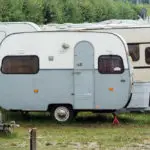
Similar Posts
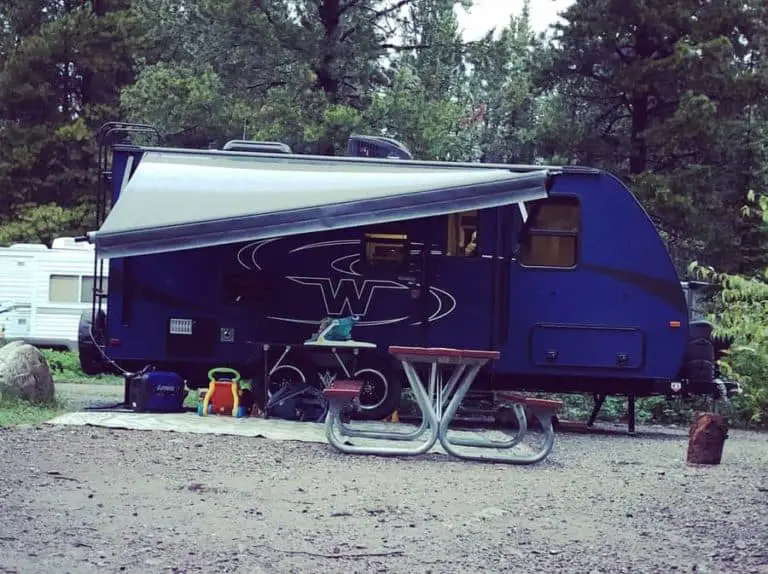
100+ Must Have Travel Trailer RV Accessories
There are thousands of accessories you can get for your RV for camping or living in if you are a full timer. This is our compilation of our favorite accessories that you most likely will need if you are new to RV’ing or a pro. All of the items below will make great gifts for…
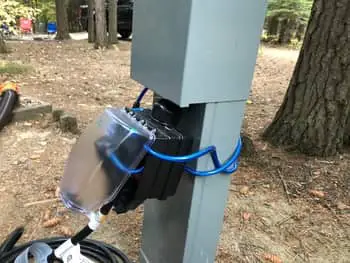
Best RV Surge Protectors in 2023 (read this before buying)
You will need to buy a RV surge protector to protect your RV or travel trailer from the varying quality of power that can be found in campgrounds. Campgrounds suffer from surges, lack of voltage, too much voltage, spikes, and generally overall a bad quality power. For example, there is a campground that we have…
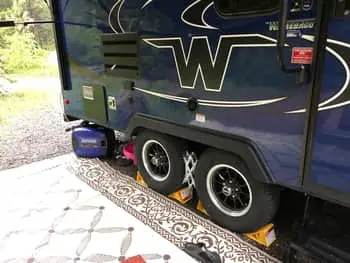
Best 6 RV and Camping Generators Reviewed for 2023
Many travel trailer owners go from plug in campground to plug in campground, but many will also go into the back country where there is no power available. Without power, your batteries will drain down and eventually leave you with no heat, water, light, etc. A good way to keep your batteries charged as well…
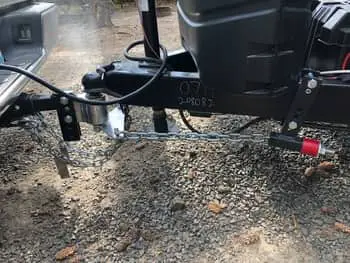
What is the Best Weight Distribution Hitch? 2023 Guide
We had heard of weight distribution hitches way before we decided to purchase our RV. We came across them when researching travel trailers, as well as used one the first time when we rented a travel trailer. On the trailer we rented, there was a bar type hitch installed. It worked great, but the squeal…
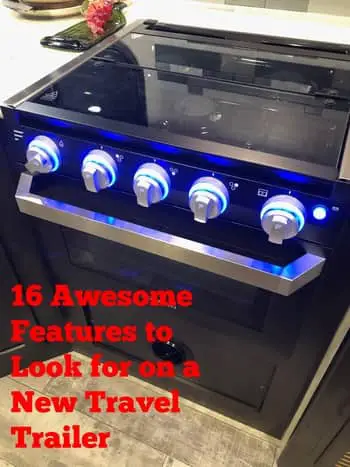
16 Awesome Features to Look for on a New Travel Trailer
Travel trailers are beginning to come with more desired aftermarket features directly from the factory. Most of these features are the ones you will want to install to your trailer someday down the road, but if you can get them factory installed, that not only saves you time to research the products and install, but…
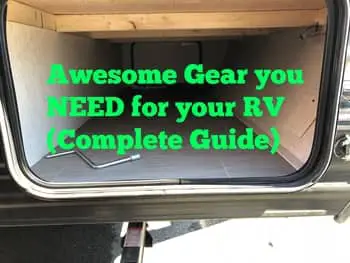
Awesome Gear you need for your RV (Complete Guide)
When you first purchase your travel trailer, you will recognize that there are several items you need in order to have a successful camping trip. These items range from necessities such as a sewer hose to luxury items such as camp chairs or generators. Through this article we go through all items you will need…
Join our Newsletter to stay up to date on the latest RV topics and receive our FREE RV Inspection Cheat Sheet Today. Use this tool to inspect new or used campers you are looking at purchasing.
No thanks, I’m not interested!

- You are here:
- Home »
- Blog »
- » Travel Trailer Lift Blocks: Can You Put Lift Blocks On RVs?
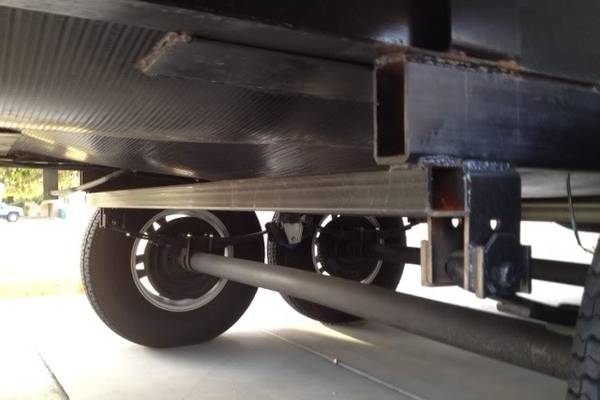
Travel Trailer Lift Blocks: Can You Put Lift Blocks On RVs?
- April 14, 2022 /
- RV Driving /
- By James V.
The danger of towing a trailer into a campground is that the access road is not one of the best. There are usually bumps, holes, and other obstacles that can damage low-lying components. One solution is to lift the trailer so it does not bottom out on you when you drive those roads.
First off, there are different names for lift blocks. They are called spacers, lift kits and more names but they all do the same thing. They lift your trailer a few inches to give you more clearance. Second, yes, you can do this but be careful about ruining your trailer’s center of gravity.
To learn more about this topic just continue to read our article. It has the information you want to know about so you can make the right decision for your camping travels. There are differing opinions on this topic as well, some people do and others do not favor this method.
How do You Raise The Suspension on a Camper Trailer?
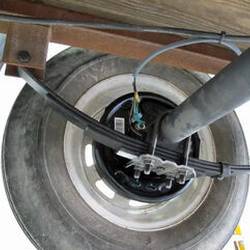
There are different methods to do this project. the first one, which many RVers use is flipping the axle. This will provide you with that couple of extra inches you may need without buying expensive parts.
The drawback to this option is that you can do it wrong and cause damage to your tires and decrease your handling ability. The next method will be to use new suspension spring hangers. Get them in a longer size to get the clearance you want.
However, it is possible that by using this method you will add more stress to the frame if you do not include some extra support. Then you can go to lift blocks or lift kits. One owner had the dealer install them, then weld them to the gusset for that additional support that is needed
So far, according to that owner, there has been no problem despite what others say. The drawback to using lift blocks is that the trailer may become more bouncy and ride rougher. This will put more stress on your suspension and wear out the trailer faster.
If you already own a Winnebago, some of their models already have an adjustable lift system installed. The company put about 3 to 4 vertical bolt holes that allow you to make adjustments without having to go to blocks or use lift kits.
Can You Put a Lift Kit on a Travel Trailer?
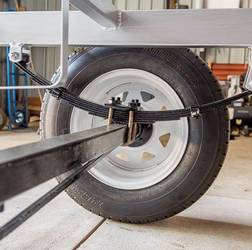
Yes, you should be able to. Another name for them is over/under kits and they have been successfully on different trailer models and years. These kits do come in a variety of sizes to make sure they fit your particular axle diameter on your specific trailer model.
The biggest benefit you will get by installing a lift kit on your trailer is a more worry-free life. You do not have to be as concerned about those lower-down components when traveling over rough and bumpy roads. You will get more clearance.
These kits are also good on those off-road trailer models trucks. You can go further into the wilderness than you could without one of these installed on your vehicles. Keep in mind that there are risks involved when using lift blocks or kits.
One risk is that you will push your center of gravity higher and you may and will lose some handling control. You should talk to experienced mechanics that you trust before installing these kits to make sure you are aware of all the risks that come with this installation.
But those drawbacks and risks may be acceptable when you have a steep driveway at your traditional home. Think it through before buying to make sure you will reap the most benefits from this upgrade.
Are Lift Blocks Safe?
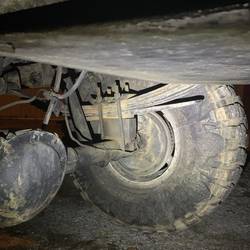
For the most part, there is very little that is unsafe about these lift blocks. There are minor drawbacks that we have talked about but under normal conditions and good driving habits, there should not be a problem.
With that said. some owners and parts companies are against lift blocks. The main reason for their opposition is that they do not like the bouncier or rougher ride that comes with their installation.
You do have to be careful about adding extra stress to that part of your trailer. Yet, we have read many owners who have reported that they have had no issues when they installed their lift blocks.
It is going to be a subjective issue as some people with bad experiences will say one thing and tell you to avoid using them and other people will say the exact opposite.
The best thing to do is talk to actual mechanics and get the full story on these lift blocks. They will know more about them and how to install them in such a way that they will be safe to use.
Travel Trailer Lift Blocks
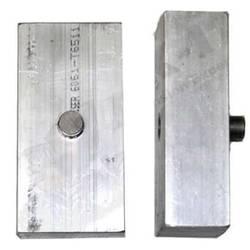
There is a wide array of retailers who will sell you a lift kit. That is the name you should use when making your own search for this product. If you say lift blocks, you will get the standard blocks that your RV or trailer drives over to get off the ground and secure the wheel in place.
The kits come with the U-bolts and hardware you need for installation. They are also priced between $50 and $100 on Amazon. There are other retailers that are more expensive and their blocks do not come with the U-bolts.
Plus, you should be able to find these kits at different outlets including RV parts and supplies, big box stores and hardware outlets. Their prices will vary depending on if you get the kit or just the blocks.
The blocks are designed to fit into the axle and suspension mechanism and lock into place so you do not have to worry about movement or losing one. It would be best to get the kits as they will have the U-bolts you need to compensate for the additional height.
Your old U-Bolts may not have the length to handle that addition. That would mean that you would have to run back to the store to buy new and longer U-bolts if you did not buy the kit.
5th Wheel Trailer Lift Blocks
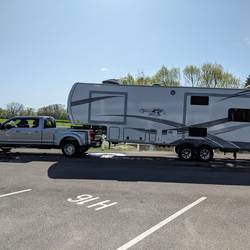
You can get these blocks but one of the first things you need to check before you buy is the axle rating. The weight rating will determine which lift block option you should buy. There are companies out there that sell lift blocks that are designed to work with axles with a 1000 to 7000-pound weight rating.
The other thing you should be cautious about is your warranty. Some RV brands may state that they will void the warranty if you install lift blocks . On older trailers, this may not be an issue but on newer ones, it can be.
RV makers are good at pointing to any modification you make to your trailer and claiming it was responsible for the accident or other issues that arise over your use of the trailer.
Check your warranty first or call your dealer to see if that will be a problem for you. If it is, you may have to plan on staying at those campgrounds that have ideal access roads.
When To Use Lift Blocks And When To Use Leaf Springs
Knowing when to use them is essential as you do not always need lift blocks to get the clearance you want. Here are some tips on when to use these little devices and when to turn to leaf springs for clearance help:
Lift Blocks
- when you do not have a lot of money to spend . They are affordable and easy to install
- when you want to install larger wheels. Adding larger wheels and rims is the safest way to get clearance but adding both is not always an option. The lift blocks should save you a little money here and achieve your clearance goals.
- when you need more clearance- steep driveways, bumpy terrain or roads, other problematic parking lots, etc are ideal situations to add your lift blocks.
Leaf Springs
- increase your weight limits- leaf springs let you add more weight to your trailer. They provide good support for the extra weight
- tire alignment- leaf springs are great at doing this task. This alignment will provide greater handling and protect your tires
- smoother ride- leaf springs even out those bumps and make sure you are not bounced around as much
Some Final Words
This is going to be a judgment call on your part. Get all the facts, talk to people on both sides of the issue and make your own decision. That is the best way to go about this topic.
If you need them then there is nothing really stopping you from using them. Don’t get them if you do not need them.
Related Posts
Route 81 From Connecticut To Florida (81 to 77 to 26 to 95)
RV Dinette With Seat Belts: Can You Add Seat belts To an RV?
Garden State Parkway Height Restrictions (Trucks and RVs)
Leave a Comment:
- Skip to main content
- Skip to secondary menu
- Skip to primary sidebar
- Skip to footer

Jeffsetter Travel
Travel Consultants and Travel Tips
How Do You Put A Travel Trailer On Blocks?
December 9, 2022 by Beth Johnson
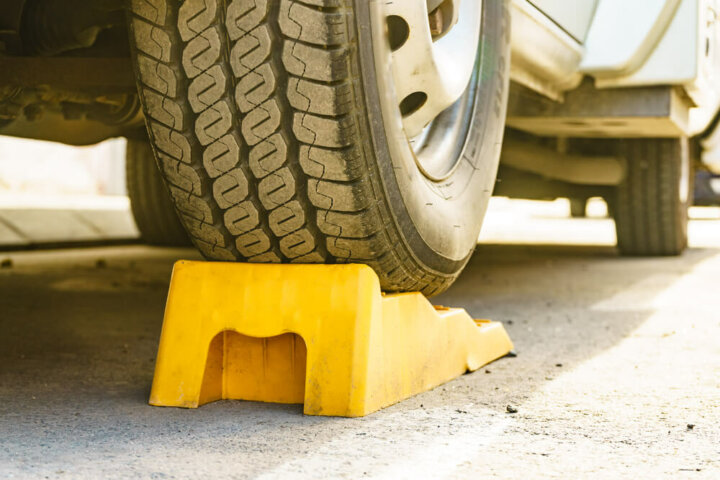
All of our reviews are based on exhaustive research, industry experience and whenever possible, hands-on testing. When you make a purchase using one of our chosen links we’ll get a small percentage of the proceeds. This supports the site and keeps Jeffsetter running. You can read more here .
If you’re looking to stay in your travel trailer for an extended period, it will be a far better experience if it isn’t rocking with every step you take . Putting a travel trailer on blocks is a way of bringing stabilization to the trailer and if done correctly, you can get the trailer leveled perfectly too. No more coffee cups sliding down the countertop!
So, how do you put a travel trailer on blocks?
To put a travel trailer on blocks, first, create level ground, then lower the front of the trailer and stack the blocks underneath the rear of the travel trailer. Next, lift the front of the trailer and repeat the block stacking process evenly on each side, according to the size of your travel trailer.
Putting your travel trailer on blocks is important, not only because you will be creating a more stable space for anyone who may be using the trailer whilst it’s off the road, but the wheels will also no longer be bearing the full weight of the trailer.
This process can be daunting, especially if you’ve never leveled a trailer before, so let’s look at the method in a bit more detail.
What Do You Need To Put A Travel Trailer On Blocks?
Before going ahead and starting to stack blocks to put the trailer onto, you need to gather the right equipment to get the job done. Having the correct tools will make things far easier further down the line.
1. Strong Jack
You may need more than one jack depending on the size of your travel trailer, and it’s crucial to use ones that can handle the weight of the trailer. Many RV owners like to use hardwood underneath the tongue jack which can be useful if you are on questionable ground.
2. Leveling Blocks
There are plastic leveling blocks on the market, but you can also use wooden blocks, just make sure either of these options can handle the size and weight of the vehicle. If your RV is too large , then the wood or plastic blocks might not be a safe option for you to use.
There’s also the option of using cinder blocks, these are usually made out of concrete and they are great to use underneath your travel trailer to bring strength and stability. Cinder blocks are hollow, and this is one of the characteristics that makes them so durable and weight-bearing.
3. Solid Ground
Arguably one of the most important parts of this process is the ground you are using to park your travel trailer. The ground ideally needs to be solid so it won’t sink under the weight of your travel trailer.
4. Spirit Level
It’s wise to use a spirit level to work out if the ground where you’ll be putting your travel trailer is level. Ground that’s not level will lead to a trailer that’s unlevel too, so it’s best to have a spirit level to hand.
How Do You Put A Travel Trailer On Blocks?
There are several steps to the process of putting a travel trailer on blocks and each one is important and shouldn’t be skipped. Before you begin, make sure everything is packed away inside the trailer, along with closing any drawers or cupboards.
When the trailer is being moved and tilted, things can fly about everywhere inside, creating a mess and potentially even some damage. We all know that dreadful noise of things falling out of an unlocked cupboard whilst on the move!
It also may be worth asking friends or family for some help when putting your travel trailer on blocks as the process needs to be done correctly to avoid any damage coming to the trailer or ending up with a very unlevel camper.
Step 1: Dig and Create Level Ground
Once you’ve decided where you want to park your travel trailer, you’ll need to dig the ground and create a level area. It’s frustrating to be on unlevel ground, especially long-term, so using a bubble spirit level or something similar will make sure everything is leveled perfectly .
Step 2: Lower the Front of the Trailer
Bring the jack to the points on the frame near where you will be working as it’s time to start getting the trailer onto the blocks. Once you’re happy the ground is level, use the jack to lower the front end of the trailer which in turn will raise the back end.
It may be useful to have another set of eyes here to help guide how far the back of the travel trailer needs to be raised.
Step 3: Stack Blocks
You can then go ahead and start stacking up the blocks under both sides at the back of the travel trailer. Placing the blocks in different directions for each layer can help improve overall strength which will aid the blocks in taking the weight of the trailer. Stacking the blocks vertically and interlocking them as you create layers will also increase their strength.
The blocks need to be used at each corner as well as on both sides of the trailer in front and behind the axle. Be sure to space the block stacks evenly apart to distribute the weight of the trailer.
If you’re using cinder blocks then wood such as thick plywood can be used on top of the final cinder block layer as a spacer as this is the point where the frame of the trailer will come into contact with the blocks. Be sure to not use a piece of wood that’s too big or thick as this could potentially end up making the travel trailer unlevel.
Step 4: Raise the Front End of The Trailer
The front end of the trailer can now be raised back up, but you’ll need to lift it a little higher than the back of your trailer. This will allow you to continue putting the rest of the cinder block stacks underneath.
Step 5: Add Another Block Stack
Another block stack can be built under the travel trailer, where the trailer will need additional support. The number of block stacks you’ll need to use will depend on the length of your travel trailer. Make sure the block stacks don’t end up interfering with any critical components that might be underneath the trailer such as gas pipes.
If you are planning on using your travel trailer whilst stacked for a long time and the ground beneath the trailer isn’t fully solid, you may eventually need to re-level the trailer.
As you can see in the detailed demonstration video, the process is simple but requires a considerable amount of time and effort. If you reach a point and start to get impatient, just remind yourself of how good it will be to have a stable and level travel trailer!
Do You Need Leveling Blocks For a Travel Trailer?
Regular RVers will know how frustrating it is when you reach a dreamy spot but it’s unlevel and no matter how hard you try, you can’t find a flat spot to park. Although you could in theory store an RV that’s not level, this isn’t wise as it can lead to problems with internal components and generally make life unnecessarily difficult.
Cinder blocks are great for a more permanent set-up option, and you could make your own leveling blocks made from wood, but for those who want to take their trailer to various sites and maybe even some wild park-ups, plastic leveling blocks may be more useful. They provide stabilization, even on slanted terrain, so you’ll no longer have the battle of getting your rig level.
What Are the Advantages of Using Leveling Blocks?
If you use your travel trailer regularly and want to have the luxury of a level spot every time you park up, leveling blocks might be the answer. Even if your trailer has electric jacks , they may not solve the problem if the spot where you’re parking has a dramatic slope.
1. Improves Comfort and Functionality
Being able to park your RV level will make for a far more enjoyable experience, as you won’t be walking on a slope or having to stop things sliding around on tables and countertops. When I first started out living full-time in a camper, being parked on a lean didn’t massively bother me.
However, after moving into a camper with my partner, I quickly realized parking level was a necessity as we were rolling into each other during the night. No one likes unhappy campers and we both need our sleep, so leveling blocks were a must for us!
2. Reduces Potential Stress on The Trailer
Parking unlevel can increase the stress on the frame of your trailer, and if it is left unlevel for a considerably long time, the frame can twist and damage can be caused.
Having a level trailer will mean everything inside is working as it should. Water won’t pool and spill out of the shower tray, the frame will support the trailer correctly, and the cupboard doors stay closed.
3. Enhances Performance of Components
RV components such as fridges can be a nightmare if you’re parked on a slope. Many travel trailers have a two-way electric or propane fridge and these need to be level to function properly and safely.
Other features such as the fresh, gray, and black water gauge won’t be reliable if you’re not parked level, as any liquid will tilt in the direction of the lean giving an inaccurate reading.
What Are the Disadvantages of Using Leveling Blocks?
There are a few drawbacks with leveling blocks that need to be considered before buying a set. Some leveling blocks are made from materials that will break down over time and need replacing, whilst others have a hefty price tag.
1. High Price
Leveling blocks, although useful, can be quite expensive depending on the type of block you buy. Basic plastic chocks, for example, are often far less in price than an advanced leveler system block.
Although leveling blocks can be pricey, they may be worth the investment if you use your trailer regularly and want to have the best experience possible whilst also being comfortable in the trailer.
2. Heavy and Require Storage Space
Those regular to RVing know how important every last bit of space can be and what a difference it can make. Leveling blocks can be heavy and awkward to store as they take up considerable space.
If you have a travel trailer that’s on the smaller side, it may be hard to find a home for a set of leveling blocks unless they are compact and can hide away when they’re not needed. I always keep a space under the bed in my camper to store our leveling blocks, that way I know not to use the space for anything else, and my blocks always have a space to fit into.
3. Material May Not Last
Leveling blocks can be made from various materials from plastic to wood, and each material has its pros and cons. Thin plastic may become brittle over time and crack under the weight of a travel trailer, whereas wood may initially be strong, but will eventually break down and need replacing.
Closing Thoughts
Putting a travel trailer on blocks is a must if you’re looking to store your travel trailer for a while, and is especially important if you’ll be inside it too!
Using cinder blocks will keep your trailer level, secure, and stable, meaning you can walk around inside the trailer and there will be minimal movement. If you’re not sure how many blocks you need to use, my advice would be to buy extra and take back whatever you don’t use, as it can be hard to work out the exact number you will need.
Putting a travel trailer on blocks is a big job and needs to be done right or the results may be disappointing. It’s best to take your time and be patient as you need to ensure each stack of cinder blocks is the perfect height to stabilize your trailer.
Important Links
- Advertising Policy and Affiliate Disclaimer
- Privacy Policy
- Contact Jeffsetter Travel Blog
- Ask Jeffsetter a Question
Recent Posts
- Maybe Avoid Kona Airport If You Can
- New for 2024 Mastercard Benefits
- Review: Ken’s House of Pancakes (Hilo)
- Review: Arden Waikiki
- Spirit Airlines Defers Deliveries

- RV Parts & Accessories
- Leveling & Stablilization
- Jacks & Stabilizers
Add to your order

- No Additional Cost: You pay nothing for repairs – parts, labor, and shipping included.
- Coverage: Plan starts on the date of purchase. Drops, spills and cracked screens due to normal use covered for portable products and power surges covered from day one. Malfunctions covered after the manufacturer's warranty.
- Easy Claims Process: File a claim anytime online or by phone. Most claims approved within minutes. We will send you an e-gift card for the purchase price of your covered product. In some instances, we will replace or repair it.
- Product Eligibility: Plan must be purchased with a product or within 30 days of the product purchase. Pre-existing conditions are not covered.
- Terms & Details: More information about this protection plan is available within the “Product guides and documents” section. Simply click “User Guide” for more info. Terms & Conditions will be available in Your Orders on Amazon. Asurion will also email your plan confirmation with Terms & Conditions to the address associated with your Amazon account within 24 hours of purchase.

Enjoy fast, free delivery, exclusive deals, and award-winning movies & TV shows with Prime Try Prime and start saving today with fast, free delivery
Amazon Prime includes:
Fast, FREE Delivery is available to Prime members. To join, select "Try Amazon Prime and start saving today with Fast, FREE Delivery" below the Add to Cart button.
- Cardmembers earn 5% Back at Amazon.com with a Prime Credit Card.
- Unlimited Free Two-Day Delivery
- Streaming of thousands of movies and TV shows with limited ads on Prime Video.
- A Kindle book to borrow for free each month - with no due dates
- Listen to over 2 million songs and hundreds of playlists
- Unlimited photo storage with anywhere access
Important: Your credit card will NOT be charged when you start your free trial or if you cancel during the trial period. If you're happy with Amazon Prime, do nothing. At the end of the free trial, your membership will automatically upgrade to a monthly membership.
Buy new: #buybox .a-accordion .a-accordion-active .a-price[data-a-size=l].reinventPriceAccordionT2 .a-price-whole { font-size: 28px !important; } #buybox .a-accordion .a-accordion-active .a-price[data-a-size=l].reinventPriceAccordionT2 .a-price-fraction, #buybox .a-accordion .a-accordion-active .a-price[data-a-size=l].reinventPriceAccordionT2 .a-price-symbol { top: -0.75em; font-size: 13px; } $39.99 $ 39 . 99 FREE delivery: Tuesday, April 23 Ships from: Amazon Sold by: CircleRoad
Return this item for free.
Free returns are available for the shipping address you chose. You can return the item for any reason in new and unused condition: no shipping charges
- Go to your orders and start the return
- Select the return method
This item has been tested to certify it can ship safely in its original box or bag to avoid unnecessary packaging. Since 2015, we have reduced the weight of outbound packaging per shipment by 41% on average, that’s over 2 million tons of packaging material.
3 Year Home Improvement Protection Plan
4 year home improvement protection plan, save with used - very good #buybox .a-accordion .a-accordion-active .a-price[data-a-size=l].reinventpriceaccordiont2 .a-price-whole { font-size: 28px important; } #buybox .a-accordion .a-accordion-active .a-price[data-a-size=l].reinventpriceaccordiont2 .a-price-fraction, #buybox .a-accordion .a-accordion-active .a-price[data-a-size=l].reinventpriceaccordiont2 .a-price-symbol { top: -0.75em; font-size: 13px; } $36.49 $ 36 . 49 free delivery: wednesday, april 24 ships from: amazon sold by: amazon warehouse.

Image Unavailable

- To view this video download Flash Player
Trailer Jack Block, 1 PC RV Leveling Blocks Super Strong Heavy Duty Boat Trailer Jack Up to 15,000 lbs RV Jack Pads Stabilizer for Trailers Camper, Blue
Purchase options and add-ons, about this item.
- 🚚【High-quality Materials】 CircleRoad RV leveling pads are made of super strong quality plastic. RV jacks & stabilizers are UV, oil, water, heat, and dirt resistant for durability and can hold up to 15,000 lbs per jack block.
- 🚚【Eliminating Shaking】 With these trailer tongue jack, setting up camper becomes a breeze. Simply place them under the jack and adjust as needed for a perfectly secure setup. The trailer jack stand ensures stability and eliminates wobbling on any surface.
- 🚚【Multifunctional】 Stackable design allows you to adjust for extra height as needed, perfect for any tongue jack, post foot or stabilizer. The rv leveling jacks with convenient side holes make it easy to carry and transport.
- 🚚【Measurement】 These camper leveling blocks are 6 inches tall, 11.06 inches long and 8.66 inches wide at the base, 9.25 inches long and 6.88 inches wide at the top, and the center dimple is 2.36 inches in diameter.
- 🚚【Why Choose Us】 The trailer jack foot have been rigorously tested to ensure that users receive camper leveling jacks that work perfectly, won’t sacrifice the quality for the price. Please feel free to contact our friendly customer service team.

Frequently bought together

Similar items that may deliver to you quickly

From the brand

CircleRoad is committed to providing you with a comfortable and convenient RV life. Join us, enjoy your outdoor life!

CircleRoad is dedicated to providing high-quality maintenance and stabilization products for your RV, ensuring your comfort and convenience on the road. We are not only a brand, but also a partner for your RV adventure life! Join us, keeping your RV in its best condition and enhance your travel experience!

RV Roof Tape & RV Blocks

RV Leveling Blocks

Meet All Your RV Needs
Product description.

CircleRoad RV Leveling Blocks
Product information, technical details, additional information, warranty & support, what's in the box.
- Comes with housing
Compare with similar items
Looking for specific info, customer reviews.
Customer Reviews, including Product Star Ratings help customers to learn more about the product and decide whether it is the right product for them.
To calculate the overall star rating and percentage breakdown by star, we don’t use a simple average. Instead, our system considers things like how recent a review is and if the reviewer bought the item on Amazon. It also analyzed reviews to verify trustworthiness.
Customers say
Customers like the sturdiness and quality of the utility jack. For example, they mention it's a good stable solution and has no trouble holding the weight.
AI-generated from the text of customer reviews
Customers like the sturdiness of the utility jack. They say it's a good stable solution that has no trouble holding the weight.
"Easy to move with the built in handles, and these are very strong ." Read more
"Bought two of these to get my boat trailer up higher. They are very sturdy nd had not trouble holding the weight...." Read more
"We absolutely love this product. It's sturdy and reliable ...." Read more
"... Heavy duty design , good footprint. Perfect for keeping from sinking in softer ground/asphalt/etc." Read more
Customers are satisfied with the quality of the utility jack. They mention it's a great product.
" Great product ..." Read more
Reviews with images

- Sort reviews by Top reviews Most recent Top reviews
Top reviews from the United States
There was a problem filtering reviews right now. please try again later..
- Amazon Newsletter
- About Amazon
- Accessibility
- Sustainability
- Press Center
- Investor Relations
- Amazon Devices
- Amazon Science
- Sell on Amazon
- Sell apps on Amazon
- Supply to Amazon
- Protect & Build Your Brand
- Become an Affiliate
- Become a Delivery Driver
- Start a Package Delivery Business
- Advertise Your Products
- Self-Publish with Us
- Become an Amazon Hub Partner
- › See More Ways to Make Money
- Amazon Visa
- Amazon Store Card
- Amazon Secured Card
- Amazon Business Card
- Shop with Points
- Credit Card Marketplace
- Reload Your Balance
- Amazon Currency Converter
- Your Account
- Your Orders
- Shipping Rates & Policies
- Amazon Prime
- Returns & Replacements
- Manage Your Content and Devices
- Recalls and Product Safety Alerts
- Conditions of Use
- Privacy Notice
- Consumer Health Data Privacy Disclosure
- Your Ads Privacy Choices

IMAGES
VIDEO
COMMENTS
Camco's RV Light Blocking Door Window Shade protects your RV interior from the sun and helps keep the interior temperature cooler in hot weather. This shade also provides additional privacy by blocking unwanted outside views. It measures 25 ¼-inches (L) x 16 ¼-inches (W) and is made of black nylon ripstop with a silver reflective backing.
DIY your own custom blackout window covers for your travel trailer so that your family can finally take that relaxing darkened afternoon nap in the camper! ... Anyways, I wanted a quick and cheap way to do a couple of things - block out the light, help regulate the temperature a bit in our camper, as well as hopefully reduce the need to have ...
COMPATIBILITY: The vent insulator for RV trailers fits standard 14″ RV vents. This camper accessory is an RV must-have. It's great for motorhomes, travel trailers, 5th wheels, and more. THREE-LAYER PROTECTION: The insulated vent cover has a reflective layer, a foam insulating layer, and a synthetic fleece layer for UV ray protection.
RV Skylight Window Shade, 23 ¼" (L) x 15 ¼" (W), Foldable Magnet RV Blackout Cover, UV Rays Protection Camper Trailer Fan Vent Cover, Waterproof Thickened Oxford Fabric (Black) 351. 100+ bought in past month. $1499. List: $16.99. Save 15% with coupon. FREE delivery Sat, Apr 20 on $35 of items shipped by Amazon. Or fastest delivery Thu, Apr 18.
install a vent cushion or cover over the inside of the skylight. use a curtain to block light from the bathroom itself. 1. Paint the skylight from the outside. Painting a skylight isn't something that you should undertake light heartedly. Once you paint the skylight cover a darker color, it's tough or impossible to go back to clear.
EZ Snap® RV window shades block up to 90% of the sun's heat without blocking the view. DIY easy exterior solar shade install with no drilling 3M™ fasteners. 1-877-439-7627 [email protected]
Designed exclusively for RV windows with radius corners, the Blackout EZTM RV Window Cover will -. Give you total privacy. Keep you cooler in the summer by reflecting the sun. Keep you warmer in the winter by insulating your windows. Keep your interior from fading during storage. Note - custom covers ship complete with Velcro tape.
This is where Sharon's DIY skylight blockers save the day! Sharon blocks her RV's bathroom skylight with her timeless quilt squares she hand sewed in the comfort of her own home. Sharon said she also uses her quilt squares to block her RV's vents from leaking warm or cool air into her RV. "The quilt pattern is an eight pointed star ...
Here's a unique addition to our list of the best lightweight travel trailers of 2022: the ultralight, 15-foot, all fiberglass Trillium Heritage Bunk 4500 camper from L'air Camper Company in Ontario, Canada. The L'air Trillium Heritage is an ultra-lightweight travel trailer that can be easily towed by many smaller SUVs and crossovers.
There's also butcher-block countertop, premium accent lighting, a power awning, an exterior kitchen, and a 2,000-watt inverter. The 2024 19QBH adds rear bunk beds to the mix, making it a great family camping trailer. Base MSRP: $44,987.
1. Vintage Trailer Works XTR: An Off-Road Lightweight, Customizable Camper. The Vintage Trailer Works team builds custom teardrops, retro campers, and toy haulers in Dothan, Alabama. The 5'x8′ model XTR is one of VTW's four off-road, customizable lightweight teardrop trailers. Vintage Trailer Works XTR Off-Road Teardrop Camper.
Camco doesn't specify a weight limit. 1-Year warranty versus Lynx's 10-year warranty. Camco is our-runner up for RV leveling blocks. While still a nice product, the downside of the Camco is its very limited warranty. Additionally, they only a one-year warranty compared to Lynx Leveler's 10-year warranty. Camco Leveling Blocks.
Camco RV Leveling Blocks provide a level and stable base for your RV. The blocks are durable polypropylene materials that can support up to 16,000 lbs. The Camco leveling blocks have a raised center design that helps to prevent sinking and sliding, and the built-in handles make them easy to move and stack.
Type: RV leveling blocks often come in different types, including interlocking blocks, ramps, electric units, and inflatable models.Each kind of leveling block will have its unique pros and cons. Load-bearing capacity: Only use leveling blocks for campers, motorhomes, and travel trailers that can handle the vehicle's weight.Avoid using flimsy models, which would otherwise cause your camping ...
📧【BLOCKS 100% of LIGHT】 Along sides of Blackout Window Blinds (Does not include shade)- Keego Light blocker prevent light gaps on blinds and windows. Stop the light from coming in through the sides of your Blackout Blinds & shades, ideal for office, media rooms, bedrooms, and wherever naps are taken.
1.3 Quality Plastics Utility Block. 1.4 Andersen Hitches Jack Block - Stabilize Your RV. 1.5 Camco Yellow Stabilizer Jack Support. 1.6 Road Warrior Guaranteed Unbreakable RV Jack Pads. 1.7 Andersen Hitches EZ-Block Jack Block for Scissor Jacks. 1.8 Valterra StayPut Jack Pad. 2 Compare the Best RV Jack Pads.
An Impressively Outfitted, Yet Ultra-Lite Travel Trailer. Presenting a sleek European-style build including a composite floor and aluminum chassis, all interior panels are Azdel composite and the seamless poured resin fiberglass roof is one piece from bumper to hitch. Interior features, including a convertible bed and bath with a shower, offer ...
OX TOSS outdoor game for camping, RVing, and backyard fun. $39.99. $49.99. Sale. OX Blox Trailer Jack Blocks are the strongest RV blocks on the market. Perfect for support all kinds of jacks as well as for leveling and stabilizing RVs and trailers. These blocks are rated up to 10,000 lbs, making them the strongest jack and stabilizer blocks on ...
Buy OX BLOX Heavy Duty Trailer Jack Block - RV Leveling Blocks Made in USA from 100% Recycled Plastic - Super Strong and Durable RV Jack Blocks - Trailers, RVs & Camper Essentials - RV Trailer Accessories: Jacks & Stabilizers - Amazon.com FREE DELIVERY possible on eligible purchases
The two best leveling blocks on the market are the Lynx Levelers (block type) as well as the Andersen Levelers (ramp type). Both have great warranties and they are both very durable and do the job great. For some situations we use the Lynx Levelers and some the Andersen, but they can be used interchangeably.
Travel Trailer Lift Blocks. There is a wide array of retailers who will sell you a lift kit. That is the name you should use when making your own search for this product. If you say lift blocks, you will get the standard blocks that your RV or trailer drives over to get off the ground and secure the wheel in place. ... The weight rating will ...
To put a travel trailer on blocks, first, create level ground, then lower the front of the trailer and stack the blocks underneath the rear of the travel trailer. Next, lift the front of the trailer and repeat the block stacking process evenly on each side, according to the size of your travel trailer. Putting your travel trailer on blocks is ...
ROBLOCK Trailer Jack Block, 1 PC RV Camper Stabilizer Blocks with Bag for Travel Trailer, G.V.W: 25000 lbs, Use for Any Tongue Jack, Post, Foot, 5th Wheels, Round Square or Scissor Stabilizer (Black) 4.6 out of 5 stars 28